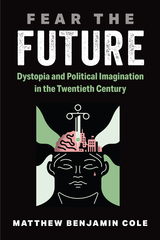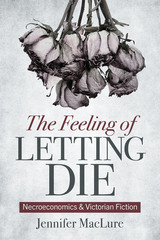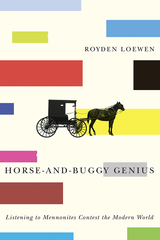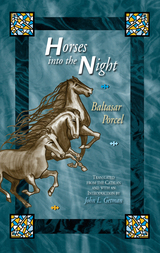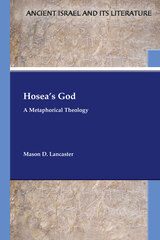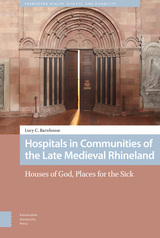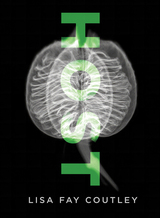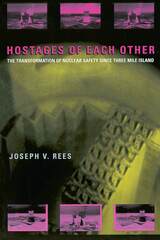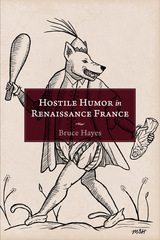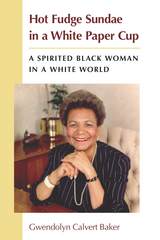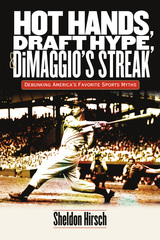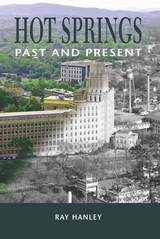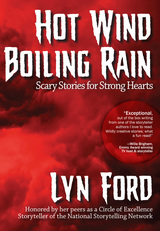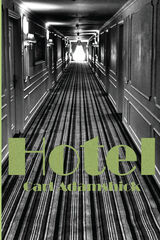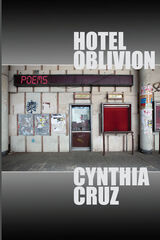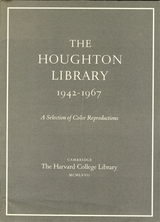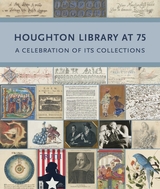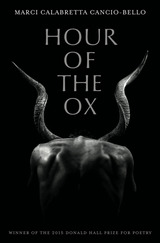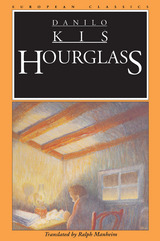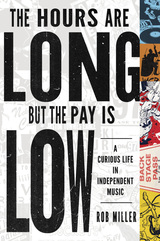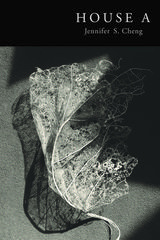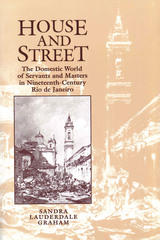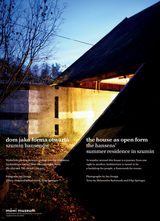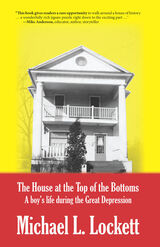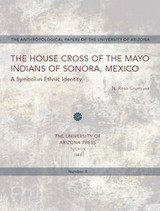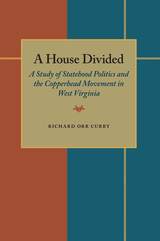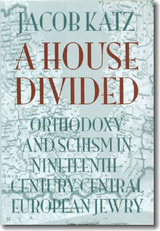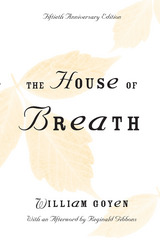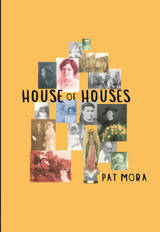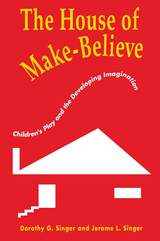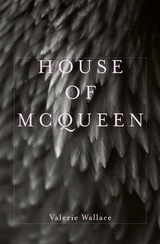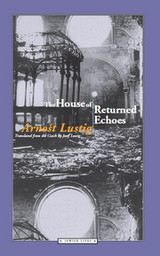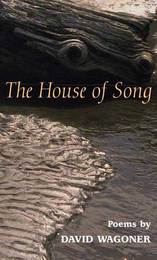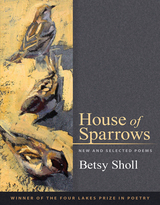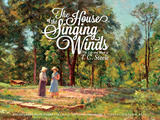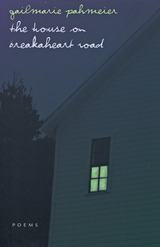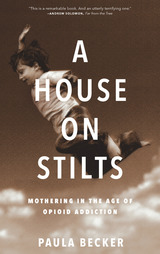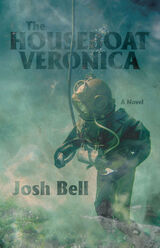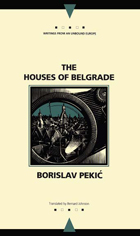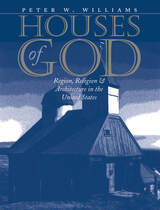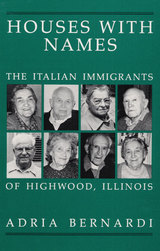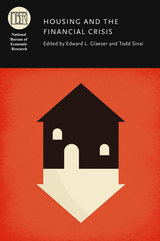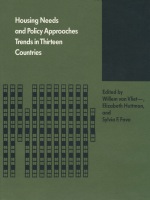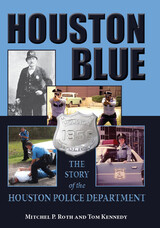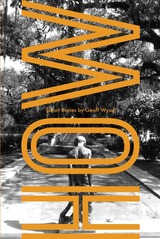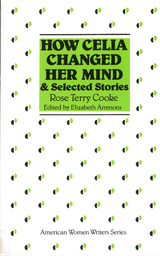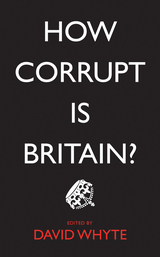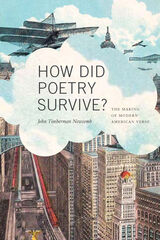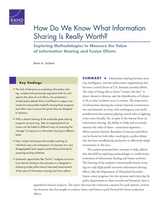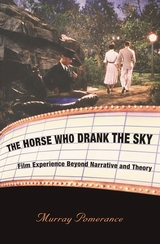 The Horse Who Drank the Sky: Film Experience Beyond Narrative and Theory
Pomerance, Murray
Rutgers University Press, 2008 What is most important about cinema is that we are alive with it. For all its dramatic, literary, political, sociological, and philosophical weight, film is ultimately an art that provokes, touches, and riddles the viewer through an image that transcends narrative and theory. In The Horse Who Drank the Sky, Murray Pomerance brings attention to the visceral dimension of movies and presents a new and unanticipated way of thinking about what happens when we watch them. By looking at point of view, the gaze, the voice from nowhere, diegesis and its discontents, ideology, the system of the apparatus, invisible editing, and the technique of overlapping sound, he argues that it is often the minuscule or transitional moments in motion pictures that penetrate most deeply into viewers' experiences. In films that include Rebel Without a Cause, Dead Man, Chinatown, The Graduate, North by Northwest, Dinner at Eight, Jaws, M, Stage Fright, Saturday Night Fever, The Band Wagon, The Bourne Identity, and dozens more, Pomerance invokes complexities that many of the best of critics have rarely tackled and opens a revealing view of some of the most astonishing moments in cinema.
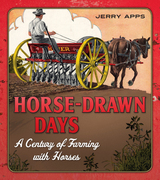 Horse-Drawn Days: A Century of Farming with Horses
Jerry Apps
Wisconsin Historical Society Press, 2010 Before tractors or steam engines arrived on the farm, horses did all the heavy work. From spring plowing to the fall harvest, the mighty draft horse powered farms across the Midwest. Relied upon to complete a multitude of tasks, including towing threshing machines and plows, hauling milk to the local cheese factory, and pulling the family buggy to church each Sunday, these animals were at the center of farm life, cementing the bond between human and horse. Horse-Drawn Days: A Century of Farming with Horses captures stories of rural life at a time when a team of horses was a vital part of the farm family. Author Jerry Apps pairs lively historic narrative with reminiscences about his boyhood on the family farm in Wisconsin to paint a vivid picture of a bygone time. Featuring fascinating historic photos, ads, and posters, plus contemporary color photos of working horses today, Horse-Drawn Days evokes the majesty of these animals and illuminates the horse’s role in our country’s early history and our rural heritage.
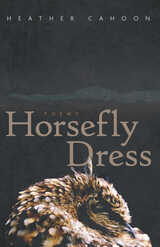 Horsefly Dress: Poems
Heather Cahoon
University of Arizona Press, 2020 Horsefly Dress is a meditation on the experience and beauty of suffering, questioning its triggers and ultimate purpose through the lens of historical and contemporary interactions and complications of Séliš, Qĺispé, and Christian beliefs. Heather Cahoon’s collection explores dark truths about the world through first-person experiences, as well as the experiences of her family and larger tribal community. As a member of the Confederated Salish and Kootenai Tribes, Cahoon crafts poems that recount traditional stories and confront Coyote’s transformation of the world, including his decision to leave certain evils present, such as cruelty, greed, hunger, and death. By weaving together stories of Cahoon’s family and tribal community with those of Coyote and his family, especially Coyote’s daughter, Horsefly Dress, the interactions and shared experiences show the continued relevance of traditional Séliš and Qĺispé culture to contemporary life. Rich in the imagery of autumnal foliage, migrating birds, and frozen landscapes, Horsefly Dress calls forth the sensory experience of grief and transformation. As the stories and poems reveal, the transformative powers associated with the human experience of loss belong to the past, present, and future, as do the traditional Salish-Pend d’Oreille stories that create the backbone of this intricate collection.
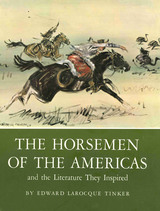 The Horsemen of the Americas and the Literature They Inspired
Edward Larocque Tinker
University of Texas Press, 1967 Wherever cattle have been raised on a large scale horsemen have been there to handle them; and wherever these horsemen have existed they have left an indelible mark upon the history of the land. Frequently they have been ignorant, violent, and brutal. Always they have been vigorous and individualistic. They have taken their herds into frontier areas, opened new country, fought and driven off earlier inhabitants, participated in revolutions, battled among themselves, and generally lived lives which, colorful and somewhat frightening to their contemporaries, have become robust legends to those who followed them. Edward Larocque Tinker portrays the life of these people in the two Americas, the conditions which created them, and those that ultimately destroyed or transformed them. "Ever since I was a small boy, when my parents returned from Mexico bringing me a charro outfit complete with saddle and bridle, Latin America has beckoned with the finger of romance," Mr. Tinker recalls. "As soon as I was old enough, I made many trips to Mexico and, in the days of Porfirio Díaz, learned to know it from the border to the Isthmus of Tehuantepec. During the Revolution I was with General Álvaro Obregón when he was a Teniente Coronel in his Sonora Campaign, and, although I was only a lawyer on a holiday, took care of his wounded in the battel of San Joaquín. Later, in Pancho Villa's train, I was present at Celaya when he was defeated by Obregón. "Always an ardent horseman, I worked many a roundup with the vaqueros of Sonora and Chihuahua, and with the cowboys of our Southwest. . . . "I saw the similarity between the American cowboy, the Argentine Gaucho, and the Vaquero of Mexico. They all received their gear and technique of cattle handling from Spain, and developed the same independence, courage, and hardihood. I thought if these qualities were better known they might serve as a bridge to closer understanding throughout the Americas." From his study of the lives of these horsemen, Tinker proceeds to an examination of the literature that evolved among and then about them. The first and largest part of the book deals with the gaucho of Argentina and Uruguay. The second and third sections examine the charro of Mexico and the cowboy of the United States.
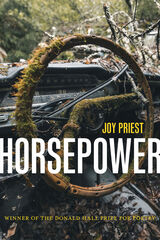 Horsepower: Poems
Joy Priest
University of Pittsburgh Press, 2020 Priest’s debut collection, Horsepower, is a cinematic escape narrative that radically envisions a daughter’s waywardness as aspirational. Across the book’s three sequences, we find the black-girl speaker in the midst of a self-imposed exile, going back in memory to explore her younger self—a mixed-race child being raised by her white supremacist grandfather in the shadow of Churchill Downs, Kentucky’s world-famous horseracing track—before arriving in a state of self-awareness to confront the personal and political landscape of a harshly segregated Louisville. Out of a space that is at once southern and urban, violent and beautiful, racially-charged and working-class, she attempts to transcend her social and economic circumstances. Across the collection, Priest writes a horse that acts as a metaphysical engine of flight, showing us how to throw off the harness and sustain wildness. Unlike the traditional Bildungsroman, Priest presents a non-linear narrative in which the speaker lacks the freedom to come of age naively in the urban South, and must instead, from the beginning, possess the wisdom of “the horses & their restless minds.”
FROM "RODEO"
The four-wheeler is a chariot. Horse-wraiths
Kicking up a plume of spirits in the dirt behind us.
Her arms kudzu around my middle. Out here,
In the desert, everything is invisible.
Only the locusts’ flat buzz gives
Them away. Everything native & quieting
Perennial & nighthawk black
As we ride through: the cowgirls,
The witch & the water sky-mirror-split,
The severity of squall lines. Also, the lips
Parting air like lightning & the girl
Blowing bubbles—in each one
a rainbow.
 Horses at Work: Harnessing Power in Industrial America
Ann Norton Greene
Harvard University Press, 2008 Historians have long assumed that new industrial machines and power sources eliminated work animals from nineteenth-century America, yet a bird’s-eye view of nineteenth-century society would show millions of horses supplying the energy necessary for industrial development. Horses were ubiquitous in cities and on farms, providing power for transportation, construction, manufacturing, and agriculture. On Civil War battlefields, thousands of horses labored and died for the Union and the Confederacy hauling wagons and mechanized weaponry.
The innovations that brought machinery to the forefront of American society made horses the prime movers of these machines for most of the nineteenth century. Mechanization actually increased the need for horsepower by expanding the range of tasks requiring it. Indeed, the single most significant energy transition of the antebellum era may have been the dramatic expansion in the use of living, breathing horses as a power technology in the development of industrial America.
Ann Greene argues for recognition of horses’ critical contribution to the history of American energy and the rise of American industrial power, and a new understanding of the reasons for their replacement as prime movers. Rather than a result of “inevitable” technological change, it was Americans’ social and political choices about power consumption that sealed this animal’s fate. The rise and fall of the workhorse was defined by the kinds of choices that Americans made and would continue to make—choices that emphasized individual mobility and autonomy, and assumed, above all, abundant energy resources.
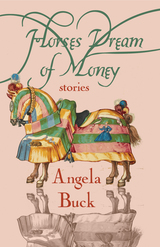 Horses Dream of Money: Stories
Angela Buck
University of Alabama Press, 2021 2021 Big Other Book Award Fiction Finalist A visceral, stark, and deadpan collection of stories that brilliantly fuse humor with horror Horses Dream of Money is a daring collection of tales, darkly humorous, that eerily channels the surreal and sinister mood of the times. Preoccupied with the fault lines between life and death, and veering often into horror, Angela Buck brings a raw energy and witty sobriety to these accounts of human life and connection with the intimacy of fireside-storytelling, gimlet-eyed revelry in bloodletting, and a masterful sleight of hand between the fantastical and the quotidian.
“The Solicitor” reinvents the coming-of-age story as a romance-for-hire between a girl and her “solicitor,” a man whose services are demanded by her mother and enforced by a cruel master. “Coffin-Testament” is a fabulous futuristic account of the extinction of human life on earth written 1,667 years later by a group of lady robots channeling Sir Thomas Browne to muse on their own mortality. “The Bears at Bedtime” documents a compound of cuddly kind worker-bears and their ruthless doings. “Bisquit” imagines today’s precariat as a lovable horse who is traded from one master to another until a horse race brings his maddeningly repetitive adventures to a violent conclusion.
 Horses: History, Myth, Art
Catherine Johns
Harvard University Press, 2006 The remarkable relationship between people and horses has been evoked in art from the beginning of the bond between them. In this beautifully illustrated book, Catherine Johns explores the horse in art from the ancient world to the modern era.
In early human history, horses were among the wild creatures hunted for meat; they were domesticated comparatively late, around 4000 B.C. As people developed from hunter-gatherers to farmers, the horse offered the potential for a revolution in power and transport—the ability to move farther and faster transformed society. Johns tells the story of the horse and highlights the key roles this animal has played in human warfare, travel, ceremony, hunting, racing, and in myth and symbolism.
The themes are presented in stunning four-color illustrations of British Museum objects that trace our perceptions of the horse through time and space, and convey the wide variety of images that have been created of this magnificent creature: in colossal and life-sized sculpture, in paintings, and in minuscule form on coins, gems, and jewelry; and from the world of ancient Greece and Rome to the arts of India, Africa, China, and Japan.
Horses appear in stone and metal, ceramic, wood, bone, ivory, and textiles. From the Horse of Selene and a gold model chariot from the Oxus treasure to Persian miniatures and prints by Duerer, Stubbs, and Hokusai, this book will inform, entertain, and delight horse lovers and all readers interested in this inspiring animal and its profound contribution to human culture.
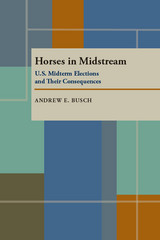 Horses In Midstream: U.S. Midterm Elections and Their Consequences, 1894–1998
Andrew E Busch
University of Pittsburgh Press, 1999
Horses in Midstream breaks the mold of midterm election literature by focusing on the consequences of midterm elections rather than on the causes of the anti-administration pattern of those elections. The book concludes that the midterm pattern has two primary consequences: it stymies the President and provides an opportunity for the revitalization of the opposition party—and that numerical losses by the President's party is really only a small part of the equation. Consequently, midterm elections can be considered an additional check in the U.S. political system, acting as a mechanism that helps to assure rough two party balance.
In examining the historical results from midterm elections dating back to 1894 and extending to the surprising result of 1994 and 1998, Busch has uncovered seven consistent ways in which the president and his party are harmed by midterm elections. These elections unfavorably alter the composition of congress, both between the parties and within the President's own party; they deprive the President of the plebiscitary power derived from his original electoral mandate; they give an intangible sense of momentum to the opposition party, leading to renewed opportunities for the opposition to put forward new leaders and to develop winning issues; they exacerbate splits within the President's own party; and they provide the opposition party with expanded party-building opportunities at the state level. Busch also places the midterm elections into four categories: "preparatory" midterms, which contribute to a subsequent change in party control of the Presidency; "calibrating" midterms in which voters slow but do not reverse extraordinary periods of Presidentially-driven change; "normal" midterms when midterm elections stymie the President without contributing to a White House takeover; and the rare "creative exceptions" when an administration escapes the midterm curse at the polls and find themselves invigorated rather than weakened. Busch's new approach to midterm elections, his well supported conclusions, and his clear, consistent style will certainly be of interest to political scientists and will translate well to the classroom.
Horses into the Night
Baltasar Porcel
University of Arkansas Press, 1994 Belonging with the work of Gabriel Garcia Márquez, Carlos Fuentes, and Julio Cortázar, this richly drawn story runs the gamut from lyrical to violent to pastoral. Originally published in 1975, Cavalls cap a la fosca was hailed by the public and critics alike as perhaps the most incisive Catalan novel since the Spanish Civil War. It was honored with four prestigious literary prizes, including the 1976 Spanish Literary Critics’ Award In Horses into the Night, the narrator’s search for his roots—especially for his father—among the myths, stories, lies, and truths of his family and hometown, strikes a universal chord. As the plot becomes increasingly textured with piracy, smuggling, the Inquisition, morbid familial relationships, eroticism, and occult occurrences, it is all but impossible to resist this epic story described by El Pais as a “Mediterranean novel flooded with light and bathed in darkness.”
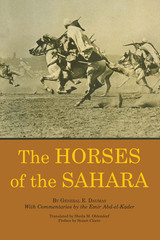 The Horses of the Sahara
By General E. Daumas
University of Texas Press, 1968 The Arabs created one of the world's finest breeds of saddle horses, the Arabian, and they have long possessed an immense store of knowledge regarding the care, training, and breeding of this splendid horse. In the nineteenth century, General Melchior Joseph Eugene Daumas had access to their knowledge even though, as he pointed out, "it requires a great deal of patience and tact for a Christian to obtain from the Mohammedans even the most insignificant of details . . ." General Daumas was, because of his unique relationship with the Arabs, probably the first European to produce a comprehensive study of Arabian horses. And to add even greater value to The Horses of the Sahara, he was able to secure for the ninth edition, here translated, extended commentaries on all aspects of Arabian horsemanship by the Emir Abd-el-Kadar, one of the most important nineteenth-century Arab leaders and certainly one of the foremost authorities on the subject. The Horses of the Sahara will be of interest not only to equestrians but also to historians and other scholars interested in the customs of the North African desert tribes and in the complex backgrounds of European–North African relations. General Daumas took part in the conquest of Algeria by France, so distinguishing himself that he was named Director of the Bureau of Algerian Affairs in the French Ministry of War. During the campaigns and the occupation that followed, he studied and attempted to understand the native peoples, with an objectivity and sympathy unusual among the colonialists of the period. His book provides fascinating sidelights on many aspects of Arab life, including customs, superstitions, religion, and family life. Sheila M. Ohlendorf was uniquely suited to translate The Horses of the Sahara. An excellent rider herself, thoroughly experienced with the animals and the techniques being discussed, she also spoke fluent French, having received her B.A. degree in languages from Texas Western University (now the University of Texas at El Paso). As curator of the Hall of the Horsemen, the large collection at the University of Texas at Austin, she had access to a wide variety of supplementary authorities, which enriched both her translation and the notes that accompany the book.
 Horsing Around in New Jersey: The Horse Lover's Guide to Everything Equine
Zatz, Arline
Rutgers University Press, 2004 Arline Zatz has writtenthe first guidebook to everything equine in the Garden State: Horsing Around in New Jersey. This accessible, easy-to-use volume is essential reading for the novice who yearns to go horseback riding but doesn't know how or where to begin; for the experienced equestrian seeking new trails and campsites; for anyone wishing to attend an equestrian event; and for those seeking a job in the equestrian field, which already employs nearly 6,000 New Jerseyans. The industry generates more than 650 million dollars in annual revenue. Millions of people attend equine events in New Jersey each year. The U.S. Equestrian team makes its home there, and New Jersey's state animal is the horse. Zatz tells readers--including those with disabilities--where they can take lessons, rent a horse, and prepare for riding. She includes safety and first aid tips. Horse history and breeds common to New Jersey are discussed, as are health concerns, including diseases, preventative medicine, and emergency care. The book showcases New Jersey's eighty-five equestrian trails and covers information on where to obtain riding permits and their accompanying rules and regulations. There is advice for both new horse owners and renters, including recommendations on tack and clothing, stable management, and horse adoption. The book acquaints readers with year-round equine entertainment opportunities, and offers dozens of suggestions on where to watch or participate in sports on horseback. Zatz lists equine education programs for all ages, and outlines numerous employment opportunities within the equine industry. The book concludes with a glossary of common horse industry terminology, a listing of national equine associations and breed registries, equipment sources, and equine publications for further reading.
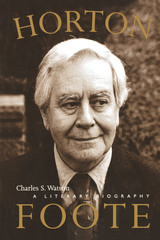 Horton Foote: A Literary Biography
By Charles S. Watson
University of Texas Press, 2003 Winner of the Pulitzer Prize for Drama for The Young Man from Atlanta and Academy Awards for the screen adaptation of To Kill a Mockingbird and the original screenplay Tender Mercies, as well as the recipient of an Academy Award nomination for the screenplay of The Trip to Bountiful and the William Inge Lifetime Achievement Award, Horton Foote is one of America's most respected writers for stage and screen. The deep compassion he shows for his characters, the moral vision that infuses his social commentary, and the kindness and humanity that Foote himself radiates have also made him one of our most revered artists—the father-figure who understands our longings for home, for human connections, and for certainty in a world largely bereft of these. This literary biography thoroughly investigates how Horton Foote's life and worldview have shaped his works for stage, television, and film. Tracing the whole trajectory of Foote's career from his small-town Texas upbringing to the present day, Charles Watson demonstrates that Foote has created a fully imagined mythical world from the materials supplied by his own and his family's and friends' lives in Wharton, Texas, in the early twentieth century. Devoting attention to each of Foote's major works in turn, he shows how this world took shape in Foote's writing for the New York stage, Golden Age television, Hollywood films, and in his nine-play masterpiece, The Orphan's Home Cycle. Throughout, Watson's focus on Foote as a master playwright and his extensive use of the dramatist's unpublished correspondence make this literary biography required reading for all who admire the work of Horton Foote.
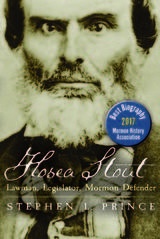 Hosea Stout: Lawman, Legislator, Mormon Defender
Stephen L. Prince
Utah State University Press, 2016 Hosea Stout witnessed and influenced many of the major civil and political events over fifty years of LDS history, but until the publication of his diaries, he was a relatively obscure figure to historians. Hosea Stout: Lawman, Legislator, Mormon Defender is the first-ever biography of this devoted follower who played a significant role in Mormon and Utah history.
Stout joined the Mormons in Missouri in 1838 and followed them to Nauvoo, where he rose quickly to become a top leader in the Nauvoo Legion and chief of police, a position he also held at Winter Quarters. He became the first attorney general for the Territory of Utah, was elected to the Utah Territorial Legislature, and served as regent for the University of Deseret (which later became the University of Utah) and as judge advocate of the Nauvoo Legion in Utah. In 1862, Stout was appointed US attorney for the Territory of Utah by President Abraham Lincoln. In 1867, he became city attorney of Salt Lake City and he was elected to the Utah House of Representatives in 1881.
But Stout’s history also had its troubled moments. Known as a violent man and aggressive enforcer, he was often at the center of controversy during his days on the police force and was accused of having a connection with deaths in Nauvoo and Utah. Ultimately, however, none of these allegations ever found traction, and the leaders of the LDS community, especially Brigham Young, saw to it that Stout was promoted to roles of increasing responsibility throughout his life. When he died in 1889, Hosea Stout left a complicated legacy of service to his state, his church, and the members of his faith community.
Hosea’s God: A Metaphorical Theology
Mason D. Lancaster
SBL Press, 2023 The book of Hosea is a labyrinth of juxtaposed images for God and God’s people, with such disparate metaphors as God the devouring lion and God the reviving dew. In Hosea’s God: A Metaphorical Theology, Mason D. Lancaster demonstrates that recent advances in metaphor theory help untangle these divergent portrayals of God. He analyzes fifteen metaphor clusters in Hosea 4–14 individually, then discerns patterns and reversals between the clusters. Finally, respecting the ancient value for emphasizing individual aspects of a depiction over a homogenized picture of the whole, the book identifies five characteristics of God prominent among the metaphors of Hosea. Based on this analysis, Lancaster asserts that Hosea’s metaphorical depiction of Yahweh ultimately derives from the primacy of Yahweh’s fidelity to Israel.
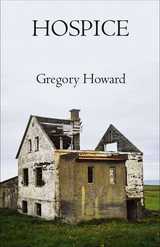 Hospice
Gregory Howard
University of Alabama Press, 2015 When Lucy is little something happens to her brother. He disappears for months and when he returns he’s not the same. He’s not her brother. At least this is what Lucy believes. But what actually happened?
Comic, melancholy, haunted, and endlessly inventive, Gregory Howard’s debut novel Hospice follows Lucy later in life as she drifts from job to job caring for dogs, children, and older women—all the while trying to escape the questions of her past only to find herself confronting them again and again.
In the odd and lovely but also frightening life of Lucy, everyday neighborhoods become wonderlands where ordinary houses reveal strange inmates living together in monastic seclusion, wayward children resort to blackmail to get what they want, and hospitals seem to appear and disappear to avoid being found.
Replete with the sense that something strange is about to happen at any moment, Hospice blurs the borders between the mundane and miraculous, evoking the intensity of the secret world of childhood and distressing and absurd search for a place to call home.
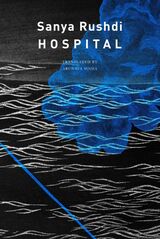 Hospital
Sanya Rushdi
Seagull Books, 2023 A strong and courageous novel that deftly tackles psychosis.
In Melbourne, Australia, a woman in her late thirties is diagnosed with her third episode of psychosis, amounting to schizophrenia. What follows is a frenzied journey from home to a community house to a hospital and out again. Sanya, the protagonist, finds herself questioning the diagnosis of her sanity or insanity, as determined and defined by a medical model which seems less than convincing to her. Having studied psychology herself, she wonders whether, even if the diagnosis is correct to some extent, the treatment should be different. Sanya tells her story in a deceptively calm, first-person voice, using conversations as the primary narrative mode, as she ponders if and when the next psychotic episode will materialize.
Based on real-life events and originally written in Bengali, Hospital is a daring first novel that unflinchingly depicts the precarity of a woman living with psychosis and her struggles with the definition of sanity in our society.
 Hospital Costs and Health Insurance
Martin Feldstein
Harvard University Press, 1981 The cost of hospital care has grown so rapidly in the past thirty years that it is threatening to bend our economy completely out of shape. A hospital bed that cost $16 per day in 1950 cost $214 per day by 1978—an increase of more than 1200 per cent! What is the cause of this fantastic inflation, which has been far higher than for any other major good or service? In this pathbreaking book, Martin Feldstein sets forth a novel explanation, provides empirical support for it, and suggests some remedies for the problem.
Feldstein demonstrates a complex relationship between the growing sophistication of hospital care, physician and patient demand, third-party insurance payments, and the tax treatment of insurance premiums. This last, he argues, is the key to the problem in that government policies stimulate the purchase of excessive insurance by a tax deduction and exclusion that cost the Treasury about $10 billion a year. To mitigate the increasingly severe burden of hospital costs, Feldstein recommends that this preferential tax treatment be ended. In its place, he proposes a new national health insurance plan that would give incentives to physicians and their patients to economize on costs and at the same time provide adequate coverage for major illnesses.
Hospital Costs in Massachusetts: An Econometric Study
Mary Lee Ingbar and Lester D. Taylor
Harvard University Press The authors present an analysis of direct departmental expenses in 72 community hospitals in Massachusetts for the years 1958–59 and 1962–63. Their purpose is to offer new insights into the fundamental relation between the costs of medical care and the administrative structure of hospitals. The conclusions of their study indicate that the hospital industry could find more efficient ways of providing medical care through organizational changes and thus offset or at least moderate the pressures to increase costs.
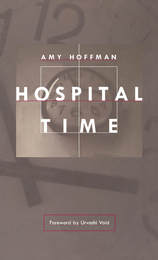 Hospital Time
Amy Hoffman
Duke University Press, 1997 Hospital Time is a memoir about friendship, family, and caregiving in the age of AIDS. Amy Hoffman, a writer, lesbian activist, and former editor of Gay Community News, chronicles with fury and unflinching honesty her experience serving as primary caretaker for her friend and colleague, Mike Riegle, who died from AIDS-related complications in 1992. Hoffman neither idealizes nor deifies Riegle, whom she portrays as a brilliant man, devoted prison rights activist, and very difficult friend.
Hoffman became central to Riegle’s caregiving when he asked her to be his health-care proxy, and although she willingly chose to do this, she explores her conflicting feelings about herself in this role and about her involvement with Riegle and his grueling struggle with hospitalization, illness, and, finally, death. She tells of the waves of grief that echoed throughout her life, awakening memories of other losses, entering her dreams and fantasies, and altering her relationships with friends, family, and even total strangers.
Hoffman’s memoir gives voice to the psychological and emotional havoc AIDS creates for those in the difficult role of caring for the terminally ill and it gives recognition to the role that lesbians continue to play in the AIDS emergency. A foreword by Urvashi Vaid, former executive director of the National Gay and Lesbian Task Force, offers a meditation on the politics of AIDS and the role of family in the lives of lesbians and gay men.
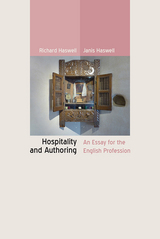 Hospitality and Authoring: An Essay for the English Profession
Richard Haswell
Utah State University Press, 2015 Hospitality and Authoring, a sequel to the Haswells’ 2010 volume Authoring, attempts to open the path for hospitality practice in the classroom, making a strong argument for educational use and offering an initial map of the territory for teachers and authors.
Hospitality is a social and ethical relationship not only between host and guest but also between writer and reader or teacher and student. Hospitality initiates, maintains, and completes acts of authoring. This extended essay explores the ways that a true hospitable classroom community can be transformed through assigned reading, one-on-one conferencing, interpretation, syllabus, reading journals, topic choice, literacy narrative, writing centers, program administration, teacher training, and many other passing habitations.
Hospitality and Authoring strives to offer a few possibilities of change to help make college an institution where singular students and singular teachers create a room to learn with room to learn.
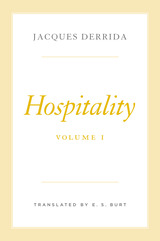 Hospitality, Volume I
Jacques Derrida
University of Chicago Press, 2023 Jacques Derrida explores the ramifications of what we owe to others.
Hospitality reproduces a two-year seminar series delivered by Jacques Derrida at the École des hautes études en sciences sociales in Paris between 1995 and 1997. In these lectures, Derrida asks a series of related questions about responsibility and “the foreigner”: How do we welcome or turn away the foreigner? What does the idea of the foreigner reveal about kinship and the state, particularly in relation to friendship, citizenship, migration, asylum, assimilation, and xenophobia? Derrida approaches these questions through readings of several classical texts as well as modern texts by Heidegger, Arendt, Camus, and others. Central to his project is a rigorous distinction between conventional, finite hospitality, with its many conditions, and the aspirational idea of hospitality as something offered unconditionally to the stranger. This volume collects the first year of the seminar.
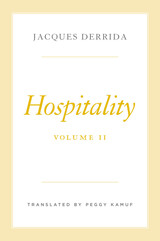 Hospitality, Volume II
Jacques Derrida
University of Chicago Press, 2024 Jacques Derrida explores the ramifications of what we owe to others.
Hospitality reproduces a two-year seminar series delivered by Jacques Derrida at the École des hautes études en sciences sociales in Paris between 1995 and 1997. In these lectures, Derrida asks a series of related questions about responsibility and “the foreigner”: How do we welcome or turn away the foreigner? What does the idea of the foreigner reveal about kinship and the state, particularly in relation to friendship, citizenship, migration, asylum, assimilation, and xenophobia? Central to his project is a rigorous distinction between conventional, finite hospitality, with its many conditions, and the aspirational idea of hospitality as something offered unconditionally to the stranger. This volume collects the second year of the seminar, which considers an Islamic problematic of hospitality, the relevance of forgiveness, and the work of Emmanuel Levinas.
Hospitals in Communities of the Late Medieval Rhineland
Lucy Barnhouse
Amsterdam University Press, 2023 From the mid-twelfth century onwards, the development of European hospitals was shaped by their claim to the legal status of religious institutions, with its attendant privileges and responsibilities. The questions of whom hospitals should serve and why they should do so have recurred — and been invested with moral weight — in successive centuries, though similarities between medieval and modern debates on the subject have often been overlooked. Hospitals’ legal status as religious institutions could be tendentious and therefore had to be vigorously defended in order to protect hospitals’ resources. This status could also, however, be invoked to impose limits on who could serve in and be served by hospitals. As recent scholarship demonstrates, disputes over whom hospitals should serve, and how, find parallels in other periods of history and current debates.
Host
Lisa Fay Coutley
University of Wisconsin Press, 2024 In raw, lyrical poems, Host explores parasitic relationships—between men and women, sons and mothers, and humans and the earth—and considers their consequences. How much control do we have over our lives? To what extent are we being controlled? And how much does it matter in the end? Revealing the unvarnished pain of mistreatment—whether inflicted maliciously or accidentally—Lisa Fay Coutley examines legacies of abuse in poems that explore how trauma parasitizes bodies, infecting the text, repeating in language and image the injuries the body has been subjected to. Ask me why
light can pour warm through a cold bay
window while water under sun is dark
as a closed door. A man’s hand
erases a girl’s thigh. The trees start starving
themselves into everyone’s favorite color.
Her darkest room digs itself
below her throne. The body knows no
wrong move. The more love, the more.
—Excerpt from “Oubliette”
Host Index of the Fungi of North America
Arthur Bliss Seymour
Harvard University Press A new and completely rewritten edition of the Provisional Host Index of the Fungi of the United States (covering the period 1888–1891) by the late Professor W. G. Farlow and A. B. Seymour, this work will be indispensable to all mycologists and phytophathologists. It contains about 80,000 names, as against 23,000 of the earlier book. The present Index includes Central America and the West Indies, Greenland and Arctic America with full synonymy so far reported on a given host up to July 1, 1927. The host families are arranged according to Dalla Torre and Harms’ Genera Siphonogamarum ad Systerna Engleriana, 1900–1907, while the specific names are arranged alphabetically. No attempt is made to give the synonymy of hosts. The author has had cooperation of many specialists who have given freely from their exact knowledge in dealing with puzzling problems of synonymy of both fungi and hosts.
Hostages of Each Other: The Transformation of Nuclear Safety since Three Mile Island
Joseph V. Rees
University of Chicago Press, 1996 Rees offers the first in-depth account of the extraordinary transformation in the safety standards, operations, and management of the nation's nuclear facilities spurred by the accident at Three Mile Island. Detailing the surprising success of self-regulation within the nuclear industry, his book reveals the possibilities for effective communitarian action.
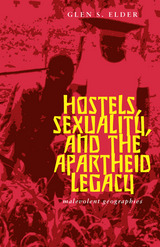 Hostels, Sexuality, and the Apartheid Legacy: Malevolent Geographies
Glen S. Elder
Ohio University Press, 2003 In the last decade, the South African state has been transformed dramatically, but the stubborn, menacing geography of apartheid still stands in the way of that country’s visions of change. Environmentally degraded old homelands still scar the rural geography of South Africa. Formerly segregated, now gated, neighborhoods still inhibit free movement. Hostels, Sexuality, and the Apartheid Legacy is a study of another such space, the converted “male” migrant worker hostel. Professor Glen Elder identifies hostels as sites of public and domestic violence, literal destruction and rebuilding, and as an important node in the spread of HIV/AIDS. Hostels have also become home to increasing numbers of “invisible” female residents. Finding that one way to understand hostel space is through women’s experiences, Professor Elder turned to thirty black migrant women living in an East Rand hostel to map the everyday geographies of South Africa’s time of change. By following the lives of these women, Elder identifies spatialized forms of marginalization, impoverishment, infection, and disempowerment. But, as he points out, the women’s survival strategies may provide signposts to the way out of apartheid’s malevolent geography. Hostels, Sexuality, and the Apartheid Legacy argues that the gendered geography of the migrant labor system developed in South Africa was premised upon sexual assumptions about men, women, and their bodies, and that feminist and queer analyses of space can inform public policy decisions.
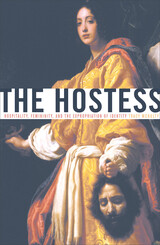 The Hostess: Hospitality, Femininity, and the Expropriation of Identity
Tracy McNulty
University of Minnesota Press, 2006 The evolution of the idea of hospitality can be traced alongside the development of Western civilization. Etymologically, the host is the “master,” but this identity is established through expropriation and loss—the best host is the one who gives the most, ultimately relinquishing what defines him as master.In The Hostess, Tracy McNulty asks, What are the implications for personhood of sharing a person—a wife or daughter—as an act of hospitality? In many traditions, the hostess is viewed not as a subject but as the master’s property. A foreign presence that both sustains and undercuts him, the hostess embodies the interplay of self and other within the host’s own identity.Here McNulty combines critical readings of the Bible and Pierre Klossowski’s trilogy The Laws of Hospitality with analyses of exogamous marital exchange, theological works from the Talmud to Aquinas, the writings of Kant and Nietzsche, and the theory of femininity in the work of Freud and Lacan. Ultimately, she contends, hospitality involves the boundary between the proper and the improper, affecting the subject as well as interpersonal relations.Tracy McNulty is assistant professor of romance studies at Cornell University.
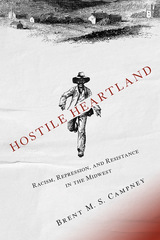 Hostile Heartland: Racism, Repression, and Resistance in the Midwest
Brent M. S. Campney
University of Illinois Press, 2019 We forget that racist violence permeated the lower Midwest from the pre-Civil War period until the 1930s. From Kansas to Ohio, whites orchestrated extraordinary events like lynchings and riots while engaged in a spectrum of brutal acts made all the more horrific by being routine. Also forgotten is the fact African Americans forcefully responded to these assertions of white supremacy through armed resistance, the creation of press outlets and civil rights organizations, and courageous individual activism. Drawing on cutting-edge methodology and a wealth of documentary evidence, Brent M. S. Campney analyzes the institutionalized white efforts to assert and maintain dominance over African Americans. Though rooted in the past, white violence evolved into a fundamentally modern phenomenon, driven by technologies such as newspapers, photographs, automobiles, and telephones. Other surprising insights challenge our assumptions about sundown towns, who was targeted by whites, law enforcement's role in facilitating and perpetrating violence, and the details of African American resistance.
Hostile Humor in Renaissance France
Bruce Hayes
University of Delaware Press, 2020 This book is also freely available online as an open access digital edition here: https://bibliopen.org/9781644531792. The open access edition is funded by the National Endowment for the Humanities.
In sixteenth-century France, the level of jokes, irony, and ridicule found in pamphlets and plays became aggressively hostile. In Hostile Humor in Renaissance France, Bruce Hayes investigates this period leading up to the French Wars of Religion, when a deliberately harmful and destructive form of satire appeared. This study examines both pamphlets and plays to show how this new form of humor emerged that attacked religious practices and people in ways that forever changed the nature of satire and religious debate in France. Hayes explores this phenomenon in the context of the Catholic and Protestant conflict to reveal new insights about the society that both exploited and vilified this kind of satire.
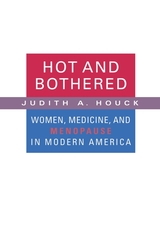 Hot and Bothered: Women, Medicine, and Menopause in Modern America
Judith A. Houck
Harvard University Press, 2006 How did menopause change from being a natural (and often welcome) end to a woman's childbearing years to a deficiency disease in need of medical and pharmacological intervention? As she traces the medicalization of menopause over the last 100 years, historian Judith Houck challenges some widely held assumptions. Physicians hardly foisted hormones on reluctant female patients; rather, physicians themselves were often reluctant to claim menopause as a medical problem and resisted the widespread use of hormone therapy for what was, after all, a normal transition in a woman's lifespan. Houck argues that the medical and popular understandings of menopause at any given time depended on both pharmacological options and cultural ideas and anxieties of the moment. As women delayed marriage and motherhood and entered the workforce in greater numbers, the medical understanding, cultural meaning, and experience of menopause changed. By examining the history of menopause over the course of the twentieth century, Houck shows how the experience and representation of menopause has been profoundly influenced by biomedical developments and by changing roles for women and the changing definition of womanhood.
 Hot Books in the Cold War: The CIA-Funded Secret Western Book Distribution Program Behind the Iron Curtain
Alfred A. Reisch
Central European University Press, 2013 This study reveals the hidden story of the secret book distribution program to Eastern Europe financed by the CIA during the Cold War. At its height between 1957 and 1970, the book program was one of the least known but most effective methods of penetrating the Iron Curtain, reaching thousands of intellectuals and professionals in the Soviet Bloc. Reisch conducted thorough research on the key personalities involved in the book program, especially the two key figures: S. S. Walker, who initiated the idea of a “mailing project,” and G. C. Minden, who developed it into one of the most effective political and psychological tools of the Cold War. The book includes excellent chapters on the vagaries of censorship and interception of books by communist authorities based on personal letters and accounts from recipients of Western material. It will stand as a testimony in honor of the handful of imaginative, determined, and hard-working individuals who helped to free half of Europe from mental bondage and planted many of the seeds that germinated when communism collapsed and the Soviet bloc disintegrated.
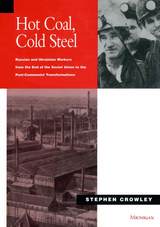 Hot Coal, Cold Steel: Russian and Ukrainian Workers from the End of the Soviet Union to the Post-Communist Transformations
Stephen Crowley
University of Michigan Press, 1997 Well after the disintegration of the Communist Party and the Soviet state--and through several years of economic collapse--industrial workers in almost every sector of the former Soviet Union have remained quiescent and the same ineffective and unpopular trade unions still hold a virtual monopoly on worker's representation. Why? While many argue that labor is a central variable in the development of economic and political systems, little is known about workers in the states of the former Soviet Union since the fall of Communism. In a comparative study of two groups of industrial workers--the coal miners and steelworkers--at the end of the Soviet era, Stephen Crowley sheds light on where these workers have been and where they are going.
Coal miners in the final years of the Soviet Union effectively organized and led strikes which supported the end of Communism, even though their heavy subsidies would be threatened by capitalism. Steel workers, in contrast, did not effectively organize and strike. This pattern has continued under the new governments, with the coal miners effectively organized and seeking protection from the worst consequences of marketization, while the steel workers remain weakly organized despite deteriorating economic conditions.
Based on extensive on-site research including interviews with miners and steelworkers, labor leaders and plant managers, Crowley develops a detailed picture of the conditions under which workers organize. His findings have application beyond the conditions of post-Communist Russia and Ukraine to other societies undergoing fundamental change.
This book will be of interest to sociologists and political scientists interested in the role of labor in transitional societies, the patterns of organization of labor, as well as area specialists.
Stephen Crowley is Associate Professor of Political Science, Oberlin College.
The Hot 'Cold War': The USSR in Southern Africa
Vladimir Shubin
Pluto Press, 2008 This book analyses the causes of armed conflicts in Southern Africa during the Cold War. It examines the influence of the various external forces in the region during this period and their relationship to local movements and governments.
The book focuses on states experiencing violent internal conflict and foreign intervention, that is Angola, Mozambique, Namibia , South Africa and Zimbabwe.
The author provides an unique history of the key part that the Soviet Union played in these developments. Spanning 30 years, the book explores how each country struggled for genuine independence against colonialism and apartheid and their place in the wider conflicts encompassed by the Cold War.
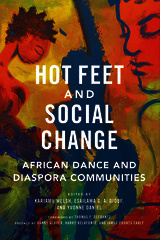 Hot Feet and Social Change: African Dance and Diaspora Communities
Edited by Kariamu Welsh, Esailama Diouf, and Yvonne Daniel
University of Illinois Press, 2019 The popularity and profile of African dance have exploded across the African diaspora in the last fifty years. Hot Feet and Social Change presents traditionalists, neo-traditionalists, and contemporary artists, teachers, and scholars telling some of the thousands of stories lived and learned by people in the field. Concentrating on eight major cities in the United States, the essays challenges myths about African dance while demonstrating its power to awaken identity, self-worth, and community respect. These voices of experience share personal accounts of living African traditions, their first encounters with and ultimate embrace of dance, and what teaching African-based dance has meant to them and their communities. Throughout, the editors alert readers to established and ongoing research, and provide links to critical contributions by African and Caribbean dance experts. Contributors: Ausettua Amor Amenkum, Abby Carlozzo, Steven Cornelius, Yvonne Daniel, Charles “Chuck” Davis, Esailama G. A. Diouf, Indira Etwaroo, Habib Iddrisu, Julie B. Johnson, C. Kemal Nance, Halifu Osumare, Amaniyea Payne, William Serrano-Franklin, and Kariamu Welsh
Hot Fudge Sundae in a White Paper Cup: A Spirited Black Woman in a White World
Gwendolyn Calvert Baker
University of Michigan Press, 2014 Gwendolyn Calvert Baker has had an extraordinary career and has witnessed a dramatic change in the ways that U.S. schools provide education to and about our multiethnic, multicultural society. But Baker hasn’t just lived through the progression of multicultural considerations—she has been singularly instrumental in the creation and acceptance of multicultural education. In Hot Fudge Sundae in a White Paper Cup, she shares her memories and experience of a lifetime spent serving and leading the causes for multicultural education.
Hot Hands, Draft Hype, and DiMaggio's Streak: Debunking America's Favorite Sports Myths
Sheldon Hirsch
University Press of New England, 2017 In sports there are lies, damned lies, and statistics. Joe DiMaggio’s fifty-six-game hitting streak was magical. The three-point shot is an essential part of NBA basketball. Babe Ruth shouldn’t have attempted to steal second base in the ninth inning of the 1926 World Series. Scientist and researcher Sheldon Hirsch has taken a decidedly unorthodox approach to sports history. He looks at myths, legends, conventional wisdom, shibboleths, and firm convictions of all kinds that sports lovers hold to be true, and demonstrates how analysis of facts and figures disproves what tradition—and sportswriters—would have us believe. Divided into three parts, on baseball, basketball, and football, Hot Hands, Draft Hype, and DiMaggio’s Streak contains enough clear-sightedness and shocking conclusions to delight any sports lover.
Hot, Hot Chicken: A Nashville Story
Rachel Louise Martin
Vanderbilt University Press, 2021 These days, hot chicken is a “must-try” Southern food. Restaurants in New York, Detroit, Cambridge, and even Australia advertise that they fry their chicken “Nashville-style.” Thousands of people attend the Music City Hot Chicken Festival each year. The James Beard Foundation has given Prince’s Chicken Shack an American Classic Award for inventing the dish.
But for almost seventy years, hot chicken was made and sold primarily in Nashville’s Black neighborhoods—and the story of hot chicken says something powerful about race relations in Nashville, especially as the city tries to figure out what it will be in the future.
Hot, Hot Chicken recounts the history of Nashville’s Black communities through the story of its hot chicken scene from the Civil War, when Nashville became a segregated city, through the tornado that ripped through North Nashville in March 2020.
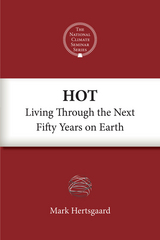 Hot: Living Through the Next Fifty Years on Earth
Mark Hertsgaard
Island Press, 2012 On December 7, 2011, Mark Hertsgaard participated in The National Climate Seminar, a series of webinars sponsored by Bard College’s Center for Environmental Policy. The online seminars provide a forum for leading scientists, writers, and other experts to talk about critical issues regarding climate change. The series also opens a public conversation, inviting participants to ask questions and contribute their own thoughts.
Hertsgaard has spent the last two decades reporting on climate change for media outlets including The New Yorker, NPR, Time, Vanity Fair, and The Nation, where he is the environment correspondent. His lecture focused on political movements and how environmental advocates can provoke change in public attitudes and on Capitol Hill. Hertsgaard sees 2011’s Occupy movement as a sign of real hope and discussed what climate activists can learn from Occupy’s tactics.
This E-ssential is an edited version of Hertsgaard’s talk and the subsequent question and answer session. While some material has been cut and some language modified for clarity, the intention was to retain the substance of the original discussion.
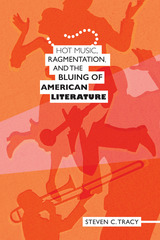 Hot Music, Ragmentation, and the Bluing of American Literature
Steven C. Tracy
University of Alabama Press, 2015 A multidisciplinary exploration of the ways that African American “hot” music emerged into the American cultural mainstream in the nineteenth century and ultimately dominated both American music and literature from 1920 to 1929
Exploring the deep and enduring relationship between music and literature, Hot Music, Ragmentation, and the Bluing of American Literature examines the diverse ways in which African American “hot” music influenced American culture—particularly literature—in early twentieth century America. Steven C. Tracy provides a history of the fusion of African and European elements that formed African American “hot” music, and considers how terms like ragtime, jazz, and blues developed their own particular meanings for American music and society. He draws from the fields of literature, literary criticism, cultural anthropology, American studies, and folklore to demonstrate how blues as a musical and poetic form has been a critical influence on American literature.
Hot Music, Ragmentation, and the Bluing of American Literature begins by highlighting instances in which American writers, including Herman Melville, Stephen Crane, and Gertrude Stein, use African American culture and music in their work, and then characterizes the social context of the Jazz Age, discussing how African American music reflected the wild abandon of the time. Tracy focuses on how a variety of schools of early twentieth century writers, from modernists to members of the Harlem Renaissance to dramatists and more, used their connections with “hot” music to give their own work meaning.
Tracy’s extensive and detailed understanding of how African American “hot” music operates has produced a fresh and original perspective on its influence on mainstream American literature and culture. An experienced blues musician himself, Tracy draws on his performance background to offer an added dimension to his analysis. Where another blues scholar might only analyze blues language, Tracy shows how the language is actually performed.
Hot Music, Ragmentation, and the Bluing of American Literature is the first book to offer such a refreshingly broad interdisciplinary vision of the influence of African American “hot” music on American literature. It is an essential addition to the library of serious scholars of American and African American literature and culture and blues aficionados alike.
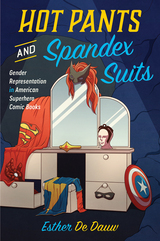 Hot Pants and Spandex Suits: Gender Representation in American Superhero Comic Books
Esther De Dauw
Rutgers University Press, 2021 The superheroes from DC and Marvel comics are some of the most iconic characters in popular culture today. But how do these figures idealize certain gender roles, body types, sexualities, and racial identities at the expense of others?
Hot Pants and Spandex Suits offers a far-reaching look at how masculinity and femininity have been represented in American superhero comics, from the Golden and Silver Ages to the Modern Age. Scholar Esther De Dauw contrasts the bulletproof and musclebound phallic bodies of classic male heroes like Superman, Captain America, and Iron Man with the figures of female counterparts like Wonder Woman and Supergirl, who are drawn as superhumanly flexible and plastic. It also examines the genre’s ambivalent treatment of LGBTQ representation, from the presentation of gay male heroes Wiccan and Hulkling as a model minority couple to the troubling association of Batwoman’s lesbianism with monstrosity. Finally, it explores the intersection between gender and race through case studies of heroes like Luke Cage, Storm, and Ms. Marvel.
Hot Pants and Spandex Suits is a fascinating and thought-provoking consideration of what superhero comics teach us about identity, embodiment, and sexuality.
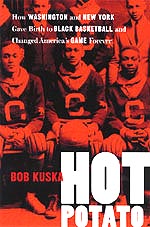 Hot Potato: How Washington and New York Gave Birth to Black Basketball and Changed America's Game Forever
Bob Kuska
University of Virginia Press, 2004 "The players today are much better than we were...But there is one thing that we could do better. We could pass the ball better than they do now. Man, we used to pass that basketball around like it was a hot potato."
--Sam "Buck" Covington, former member of the Washington Bruins
In a nation distinguished by a great black athletic heritage, there is perhaps no sport that has felt the impact of African American culture more than basketball. Most people assume that the rise of black basketball was a fortuitous accident of the inner-city playgrounds. In Hot Potato, Bob Kuska shows that it was in fact a consciously organized movement with very specific goals.
When Edwin Henderson introduced the game to Washington, D.C., in 1907, he envisioned basketball not as an end in itself but as a public-health and civil-rights tool. Henderson believed that, by organizing black athletics, including basketball, it would be possible to send more outstanding black student athletes to excel at northern white colleges and debunk negative stereotypes of the race. He reasoned that in sports, unlike politics and business, the black race would get a fair chance to succeed. Henderson chose basketball as his marquee sport, and he soon found that the game was a big hit on Washington's segregated U Street. Almost simultaneously, black basketball was catching on quickly in New York, and the book establishes that these two cities served as the birthplace of the black game.
Hot Potato chronicles the many successes and failures of the early years of black amateur basketball. It also recounts the emergence of black college basketball in America, documenting the origins of the Colored Intercollegiate Athletic Association, or CIAA, which would become the Big Ten of black collegiate sports.
The book also details for the first time the rise of black professional basketball in America, with a particular emphasis on the New York Renaissance, a team considered by experts to be as important in the development of black basketball as the Harlem Globetrotters. Kuska recounts the Renaissance's first victory over the white world champion Original Celtics in 1925, and he evaluates the significance of this win in advancing equality in American sports. By the late 1920s, the Renaissance became one of the sport's top draws in white and black America alike, setting the stage for the team's undisputed world championship in 1939. As Edwin Henderson had hoped -- and as any fan of the modern-day game can tell you -- the triumphs certainly did not end there.
 Hot Property: The Stakes and Claims of Literary Originality
Françoise Meltzer
University of Chicago Press, 1994 But is it original? The question, on which so much of writing stakes its claim to greatness, may be more interesting than the answer. In this provocative book, Francoise Meltzer takes a subtle and incisive look at the anxiety of origins at the heart of the literary enterprise. Using four case studies, Meltzer reveals the shaky status of originality as a founding principle of the critical establishment.
Freud, inventor of "dream work," turns a blind eye upon the dreams that were the starting point of his predecessor Descartes's famous methode, the one man's obsession with originality mirroring the other's fear of plagiarism. The Holocaust poet Paul Celan, whose sense of identity and place resided in his work, is devastated by a charge of plagiarism. Colette's husband Willy outdoes himself, and his "lazy" wife as well, with his enactment of literary seriousness. Walter Benjamin's early interpreters, notably Hannah Arendt and Theodor Adorno, insidiously undermine the originality of his project . In each of these cases, Meltzer shows how a threat to a writer's status as creator betrays the larger fraud of the originality myth itself.
Fascinating for its insights into the ways originality is both at risk and at work in Western literary culture, Hot Property will engage all those who have an interest in questions of authorship, textual soveriegnty, and the legitimacy of the critical establishment.
 Hot Spot: A Doctor's Diary From the Pandemic
Dr. Alex Jahangir
Vanderbilt University Press, 2022 When Nashville identified its first case of coronavirus in March 2020, the city was between Public Health Department directors and as unprepared as the rest of the world for what was to come. Dr. Alex Jahangir, a trauma surgeon acting at that time as chair of the Metro Nashville Board of Health, unexpectedly found himself head of the city's COVID-19 Task Force and responsible for leading it through uncharted waters.
What followed was a year of unprecedented challenge and scrutiny. Jahangir, who immigrated to the US from Iran at age six, grew up in Nashville. He thought he knew the city well. But the pandemic laid bare ethnic, racial, and cultural tensions that daily threatened to derail what should have been a collective effort to keep residents healthy and safe.
Hot Spot is Jahangir's narrative of the first year of COVID, derived from his op notes (the journal-like entries surgeons often keep following operations) and expanded to include his personal reflections and a glimpse into the inner sanctums of city and state governance in crisis.
Hot Springs: Past and Present
Ray Hanley
University of Arkansas Press, 2014 A century ago Hot Springs, Arkansas, was a world-renown resort city. Today, the town remains the most unique city in Arkansas but with much of its Victorian-to-1950s views nearly unrecognizable. Hot Springs: Past and Present shows vividly the before and after of hundreds of sites, answering questions such as “What used to be on this corner?” and “What was here before it was a parking lot?” The answer to those questions is often an opulent hotel, a theater, a bathhouse, a gambling house, or a mansion. Fire destroyed many buildings, even more were demolished, and some sites remain not so unlike they used to be. Hot Springs: Past and Present makes a perfect walking companion for anyone visiting the town and wishing to learn more about this one-of-a-kind place through not only the photographs but also the informative text that provides a good overview of the town’s history.
 Hot Takes: Every Journalist's Guide to Covering Climate Change
Sadie Babits
Island Press, 2025 It’s Monday morning and your editor assigns you a story about a housing project where several residents have been hospitalized because of heat stroke. Is this a climate story? Is it a climate justice story? No one would have thought so twenty years ago. In fact, when many of us were attending journalism school or reporting our first stories in newsrooms, those terms did not even exist. Today, it’s a whole different story.
Whether you cover the environment, healthcare, economics, politics, sports, or any other beat, the fact is, you need to understand climate change to do your job. Because climate affects every human (and animal, and plant) on Earth, that means it affects all our reporting.
You may know the basics when it comes to the science of human-driven climate change. But how about the major policies that determine global climate action or the growing number of legal climate-related cases? Have you considered what it means to practice journalism focused on solutions—rather than offering up a puff piece? What about how to cover the vast inequities generated from human-caused climate change, or how race and socioeconomics interact with climate? Are you prepared to detect and debunk misinformation and to remove bias from your stories?
Climate change is dramatically shifting so many aspects of our world, journalism included. So, whether you’re still a student or a fifty-year veteran, chances are, you could use some up-to-date guidance on how to report on this critical and endlessly complex issue. You have come to the right place. No resource has all the answers, but Hot Takes engages the big questions that will determine how climate change is covered, and the stories we tell our audiences and ourselves.
 Hot Towns: The Future of the Fastest Growing Communities in America
Wolf, Peter
Rutgers University Press, 1999 Hot Towns is about the vast, current national relocation of one million Americans a year. Successful, accomplished, and well-financed people of all ages are moving to communities they view as choice—places distinguished by fine climate, physical beauty, abundant natural recreation resources, and minimal social problems and low crime. Towns in this elite roster include Santa Fe, Aspen, Boulder, Bozeman, Chapel Hill, East Hampton, and many others. These American boom towns, Peter Wolf writes, have grown in jobs and population at two to three times the national average. But warning signs of deterioration are already evident: overbuilding, failing natural resources, rising taxes, and traffic congestion are all taking a toll on these communities. Rapid migration can enhance or swamp America’s fastest growing and most desirable communities Wolf examines the choices that people in these areas can make to both effectively accommodate growth and yet ensure their economic futures. A wise town undergoing growth will realize that what must be preserved is not the growth in-and-for itself, but the qualities which attract people in the first place. Wolf demonstrates how it is possible—even during a town’s rapid expansion—to enhance the quality of residents’ lives, to incorporate aesthetics and design into town evolution, to protect what is precious in nature, and to preserve the best that has already been built. Wolf concludes with a practical checklist for the residents of hot towns, allowing them to evaluate how their communities are coping with growth.
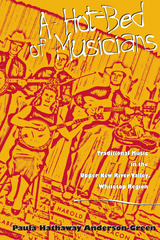 A Hot-Bed of Musicians: Traditional Music in the Upper New River Valley-Whitetop Region
Paula Hathaway Anderson-Green
University of Tennessee Press, 2002 In the Blue Ridge Mountains along the Virginia–North Carolina border, an extraordinarily rich musical heritage survives and flourishes. Even before the legendary Bill Monroe coined the term “bluegrass” in the mid-1950s, the traditional music of this area was coming into its own as a distinctive style. Early performers from the 1920s through the 1950s, many of whom migrated northward during the Great Depression, popularized the music they had grown up hearing, thereby preserving and celebrating the cultural legacy of their home region.
In A Hot-Bed of Musicians, Paula Anderson-Green tells the stories of several of these legendary performers and instrument makers from the Upper New River Valley–Whitetop Mountain region, including Ola Belle Campbell Reed, Albert Hash, and Dave Sturgill. These men and women began to bring the music of Appalachia to a wider audience well before Nashville became the center of country music. Making extensive use of interviews, the book reveals the fascinating experiences and enduring values behind the practice of old-time music. This musical heritage remains an indispensable component of Appalachian culture, and Anderson-Green traces the traditions down to the present generation of musicians there.
Written for anyone with an interest in mountain music, this book focuses on performers from Alleghany and Ashe Counties in North Carolina and Carroll County and Grayson County in Virginia. It includes a comprehensive appendix of place names and music venues as well as annotated lists of musicians and the songs they have performed.
The Author: Paula Hathaway Anderson-Green is an adjunct professor of English at Kennesaw State University and does research in Appalachian studies.
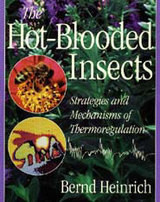 The Hot-Blooded Insects: Strategies and Mechanisms of Thermoregulation
Bernd Heinrich
Harvard University Press, 1993 Bernd Heinrich's widely praised Bumblebee Economics set a high standard for scientifically accurate yet gracefully articulate writing about nature's ingenious patterns, specifically thermoregulation. Hot-Blooded Insects takes a giant step forward by presenting an overview of what is now known about thermoregulation in all of the major insect groups, offering new insights on physiology, ecology, and evolution.
The book is richly illustrated by the author's exquisite sketches. By describing the environmental opportunities and challenges faced by moths and butterflies, grasshoppers and locusts, dungball rollers and other beetles, a wide range of bees, and other insects, Heinrich explains their dazzling variety of physiological and behavioral adaptations to what, for them, is a world of violent extremes of temperature. These mechanisms are apparent only through precise observations, but the small body size of insects poses large technical difficulties in whole-animal experiments, engendering controversy about the reliability of the data thus derived. Emphasizing an experimental approach, Heinrich pinpoints where he believes studies have gone astray, describing in detail both groundbreaking experiments and those which leave a reasonable doubt about the mechanism being interpreted. He reviews relevant work on the major taxa to show the underlying patterns that draw diversity together, opines on current controversies, and identifies questions that call for further study.
Physiologists, ecologists, entomologists, and zoologists—in fact, all biologists—will be stimulated and challenged to further research by this masterly synthesis of a new field; it will also appeal to informed readers interested in general science.
Hotel
Carl Adamshick
Four Way Books, 2021 Adamshick’s poems are characteristically accessible and navigable. From the political to the erotic and everywhere in between, these poems take us on a sometimes sober, sometimes raunchy ride.
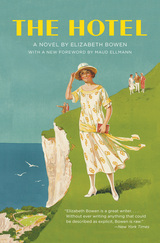 The Hotel: A Novel
Elizabeth Bowen
University of Chicago Press, 2012 In his introduction to a collection of criticism on the Anglo-Irish author Elizabeth Bowen, Harold Bloom wrote, “What then has Bowen given us except nuance, bittersweet and intelligent? Much, much more.” Born in 1899, Bowen became part of the famous Bloomsbury scene, and her novels have a much-deserved place in the modernist canon. In recent years, however, her work has not been as widely read or written about, and as Bloom points out, her evocative and sometimes enigmatic prose requires careful parsing. Yet in addition to providing a fertile ground for criticism, Bowen’s novels are both wonderfully entertaining, with rich humor, deep insight, and a tragic sense of human relationships.
Bowen’s first novel, The Hotel, is a wonderful introduction to her disarming, perceptive style. Following a group of British tourists vacationing on the Italian Riviera during the 1920s, The Hotel explores the social and emotional relationships that develop among the well-heeled residents of the eponymous establishment. When the young Miss Sydney falls under the sway of an older woman, Mrs. Kerr, a sapphic affair simmers right below the surface of Bowen’s writing, creating a rich story that often relies as much on what is left unsaid as what is written on the page. Bowen depicts an intense interpersonal drama with wit and suspense, while playing with and pushing the English language to its boundaries.
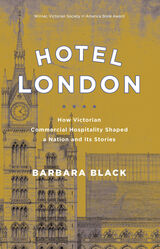 Hotel London: How Victorian Commercial Hospitality Shaped a Nation and Its Stories
Barbara Black
Ohio State University Press, 2019 Hotel London: How Victorian Commercial Hospitality Shaped a Nation and Its Stories examines Victorian London’s grand hotels as both an institution and a culture intimately connected to the urban landscape. In her new study, Barbara Black argues that London’s grand hotels provided an essential space for socializing, fashioned by concerns relating to class, gender, and nationality. Rooted in Walter Benjamin’s “new velocities” of the nineteenth century and Wayne Koestenbaum’s hotel theory, Hotel London explores how the emergence of the grand hotel as a physical and metaphorical space helped to construct a consumer economy that underscored London’s internationalism and, by extension, England’s global status.
Incorporating the works of Oscar Wilde, Henry James, Wilkie Collins, Arnold Bennett, Florence Marryat, and Marie Belloc Lowndes, as well as contemporary depictions of the hotels in Mad Men,American Horror Story, and The Grand Budapest Hotel, Black examines how the hotel supported a corporate identity that would ultimately assist in the rise of modern capitalist structures and the middle class. In this way, Hotel London exposes the aggravations of class stratifications through the operations of status inside hotel life, giving a unique perspective on Victorian London that could only come from the stories of a hotel.
Hotel Oblivion
Cynthia Cruz
Four Way Books, 2022 A specter, haunting the edges of society: because neoliberalism insists there are no social classes, thus, there is no working class, the main subject of Hotel Oblivion, a working class subject, does not exist. With no access to a past, she has no home, no history, no memory. And yet, despite all this, she will not assimilate. Instead, this book chronicles the subject’s repeated attempts at locating an exit from capitalist society via acts of negative freedom and through engagement with the death drive, whose aim is complete destruction in order to begin all over again. In the end, of course, the only true exit and only possibility for emancipation for the working class subject is through a return to one’s self. In Hotel Oblivion, through a series of fragments and interrelated poems, Cruz resists invisibilizing forces, undergoing numerous attempts at transfiguration in a concerted effort to escape her fate.
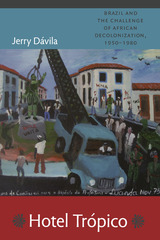 Hotel Trópico: Brazil and the Challenge of African Decolonization, 1950–1980
Jerry Dávila
Duke University Press, 2010 In the wake of African decolonization, Brazil attempted to forge connections with newly independent countries. In the early 1960s it launched an effort to establish diplomatic ties with Africa; in the 1970s it undertook trade campaigns to open African markets to Brazilian technology. Hotel Trópico reveals the perceptions, particularly regarding race, of the diplomats and intellectuals who traveled to Africa on Brazil’s behalf. Jerry Dávila analyzes how their actions were shaped by ideas of Brazil as an emerging world power, ready to expand its sphere of influence; of Africa as the natural place to assert that influence, given its historical slave-trade ties to Brazil; and of twentieth-century Brazil as a “racial democracy,” a uniquely harmonious mix of races and cultures. While the experiences of Brazilian policymakers and diplomats in Africa reflected the logic of racial democracy, they also exposed ruptures in this interpretation of Brazilian identity. Did Brazil share a “lusotropical” identity with Portugal and its African colonies, so that it was bound to support Portuguese colonialism at the expense of Brazil’s ties with African nations? Or was Brazil a country of “Africans of every color,” compelled to support decolonization in its role as a natural leader in the South Atlantic? Drawing on interviews with retired Brazilian diplomats and intellectuals, Dávila shows the Brazilian belief in racial democracy to be about not only race but also Portuguese ethnicity.
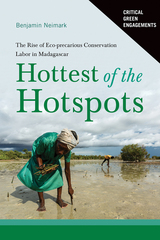 Hottest of the Hotspots: The Rise of Eco-precarious Conservation Labor in Madagascar
Benjamin Neimark
University of Arizona Press, 2023 Continually recognized as one of the “hottest” of all the world’s biodiversity hotspots, the island of Madagascar has become ground zero for the most intensive market-based conservation interventions on Earth.
This book details the rollout of market conservation programs, including the finding of drugs from nature—or “bioprospecting”—biodiversity offsetting, and the selling of blue carbon credits from mangroves. It documents the tensions that exist at the local level, as many of these programs incorporate populations highly dependent on the same biodiversity now turned into global commodities for purposes of saving it. Proponents of market conservation mobilize groups of ecologically precarious workers, or the local “eco-precariat,” who do the hidden work of collecting and counting species, monitoring and enforcing the vital biodiversity used in everything from drug discovery to carbon sequestration and large mining company offsets.
Providing a voice for those community workers many times left out of environmental policy discussions, this volume proposes critiques that aim to build better conservation interventions with perspectives of the local eco-precariat.
The Houghton Library, 1942–1967: A Selection of Color Reproductions
William H. Bond
Harvard University Press Celebrating Harvard’s Houghton Library’s twenty-fifth anniversary, this large and sumptuous volume highlights the diversity and value of the Houghton’s collections. It contains reproductions ranging from ancient and medieval manuscripts to the earliest printed books to the works of some of the twentieth-century’s most important and interesting authors, artists, and designers. This work is intended not merely to celebrate the achievement of the past, but also to suggest the exciting vistas of the future.
Houghton Library at 75: A Celebration of Its Collections
Heather Cole
Harvard University Press Houghton Library—the primary repository for Harvard University’s rare books, manuscripts, and much more—celebrates its 75th anniversary in 2017. Houghton’s holdings span nearly the entire history of the written word, from papyrus to the laptop. This anniversary volume presents a snapshot of the unique items that fill the library’s shelves.
From miniature books composed by a teenage Charlotte Brontë to a massive medieval manuscript hymnbook; from the plays of Shakespeare to costume designs for Star Trek; and from the discoveries of Copernicus to the laptops of twenty-first century writers, the selections celebrate great achievements in many and diverse fields of human endeavor. For the first time, readers will be able to tour the Houghton Library collection—which draws thousands of visitors from around the world each year—from home, with full-color illustrations.
Hound Dog: A Song by Big Mama Thornton and Interpreted by Elvis Presley and Others
Eric Weisbard
Duke University Press, 2023 Many listeners first heard “Hound Dog” when Elvis Presley’s single topped the pop, country, and R&B charts in 1956. But some fans already knew the song from Big Mama Thornton’s earlier recording, a giant but exclusively R&B hit. In Hound Dog Eric Weisbard examines the racial, commercial, and cultural ramifications of Elvis’s appropriation of a Black woman’s anthem. He rethinks the history and influences of rock music in light of Rolling Stone's replacement of Presley’s “Hound Dog” with Thornton’s version in its 2021 “500 Greatest Songs of All Time” list. Taking readers from Presley and Thornton to Patti Page’s “Doggie in the Window,” the Stooges’ “I Wanna Be Your Dog,” and other dog ditties, Weisbard uses “Hound Dog” to reflect on one of rock’s fundamental dilemmas: the whiteness of the wail.
The Hounds of Spring
Lucy Cummin
Tupelo Press, 2018 On a crisp April day in Philadelphia, Poppy Starkweather, in her mid-twenties, begins the rounds of her clients—Penelope, Fauna, Horatio, Bliss, and Chutney, accompanied by her own hound, Spock—assuming that this will be another ordinary day. Since abandoning a Ph.D. program in literature, Poppy has stumbled into walking dogs as a stopgap while she figures out what to do with her life. Although happy in a steady relationship, Poppy is leery of further commitment while in career limbo, fearing she might commit the age-old error of hiding from herself inside marriage. Shouldn’t she get it all figured out first? By noon her day will be careening off course, diverted by an unexpected visit from her brother, a scary medical appointment with her boyfriend, and an urgent request from a client. By the small hours of the night, Poppy will be questioning her assumptions about what it means to be truly adult.
Hounds of the Road: History of the Greyhound Bus Company
Carlton Jackson
University of Wisconsin Press, 1984 The bus system that came to be known as the Greyhound Bus Company was founded by Carl Eric Wickman, an enterprising Swede of Hibbing, Minnesota. The first bus was a seven-passenger Hupmobile touring car that was used to transport miners across the Mesaba Iron Range to and from work. Wickman was soon joined by another Swede, Andrew Anderson, and they began operating in earnest the route from a saloon in Hibbing to the fire-hall in Alice. From this lowly beginning grew the Greyhound Corporation, a multi-million dollar company which, through the years, has owned everything from a chain of hamburger restaurants to a soap company.
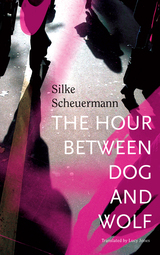 The Hour Between Dog and Wolf
Silke Scheuermann
Seagull Books, 2018 Now in paperback, Silke Scheuermann's portrayal of intimacy and estrangement between sisters as they navigate rivalries, addiction, and shared love interests.
A young woman who has been living abroad returns to her hometown of Frankfurt am Main in Germany. Her sister Ines—a beautiful, impetuous painter—who still lives there, soon appears and promptly asks for financial help. But the returning sister knew this was coming—it is how their relationship has always worked. And this time, she’s determined that that will change.
But our plans don’t always hold up to the surprises presented by life—and when the sister finds herself about to drift into an affair with Ines’s lover, the two women grow unexpectedly closer. The Hour Between Dog and Wolf is a tale of disorientation in a modern, fundamentally rootless society that has become increasingly erratic and self-absorbed—it is a powerful exploration of the difficulties of intimacy and addiction.
The Hour of All Things and Other Plays
Caridad Svich
Intellect Books, 2018 This book presents four plays by Caridad Svich that explore the rough waters of citizenship under the pressure of globalization and the threads of human connection—often tested, but never wholly severed—across multiple geographic landscapes. Featuring an introduction by Welsh playwright and director Ian Rowlands and essays by practitioners Zac Kline, Blair Baker, Neil Scharnick, Carla Melo, and Sherrine Azab, this wide-ranging, daring collection of plays refuses to pretend that the complex and thorny questions of existence are easily settled.
Hour of the Ox
Marci Calabretta Cancio-Bello
University of Pittsburgh Press, 2016 Winner of the 2015 Donald Hall Prize for Poetry
Hour of the Ox received the 2015 AWP Donald Hall Prize for Poetry, selected by Crystal Ann Williams, who called it “a timeless collection written by a poet of exceptional talent and grace, a voice as tough as it is tender.” Cancio-Bello examines the multiplicity of distance, wanderlust, and grief at the intersection between filial and cultural responsibility. Desires are sloughed off, replaced by new ones, re-cultivated as mythos. These poems offer a complex and necessary new perspective on the elegiac immigrant song.
Hourglass
Danilo Kis
Northwestern University Press, 1997 Danilo Kiš was one of the most artful and eloquent writers of postwar Europe. Of all his books, Hourglass, the account of the final months in one man's life before he is sent to a concentration camp, is considered to be his masterpiece.
 The Hours and the Minutes
Alfonz Bednár
Karolinum Press, 2025 With their courageous and engaging critique of Communism in the 1950s, these critically acclaimed Slovak classics demask one of the founding myths of modern Slovakia.
The Hours and The Minutes was first published in Bratislava in 1956, the year of Nikita Khrushchev’s “secret speech,” in which the Soviet leader formally acknowledged Stalin’s tyranny and opened the way for political reform throughout the Eastern Bloc. Alfonz Bednár’s writing was one of the first free of nationalist and communist propaganda, rejecting earlier ideologization of life by both the fascist right and Stalinist left and finding more empathetic ways to explore the complexity of human experience. His novellas defy traditional heroic depictions and portray the human individual, his relations, and morality as the subject of history rather than a utopian, collectivist ideology.
In these five novellas, Bednár is preoccupied with the insensitive, even inhuman, rootless, and amoral modernity that the war and Communist Party import into traditional Slovak life. The destruction of the traditional Slovak countryside during the twentieth century through modernization and urbanization, and with it a particular approach to life, forms his central theme. His spare, epic style and devotion to plot and dynamic narration render The Hours and The Minutes a genuine and gripping read.
The Hours Are Long, But the Pay Is Low: A Curious Life in Independent Music
Rob Miller
University of Illinois Press, 2025 “The music business is not a meritocracy: it is a crapshoot taking place in a septic tank balanced on the prow of the Titanic, a venal snake pit where innovation, creativity, and honest business practices are actively discouraged.”
Rob Miller arrived in Chicago wanting to escape the music industry. In short order, he co-founded a trailblazing record label revered for its artist-first approach and punk take on country, roots, and so much else. Miller’s gonzo memoir follows a music fan’s odyssey through a singular account of Bloodshot Records, the Chicago scene, and thirty years as part of a community sustaining independent artists and businesses.
Hilarious and hundred-proof, The Hours Are Long, But the Pay Is Low delivers a warm-hearted yet clear-eyed account of loving and living music on the edge, in the trenches, and without apologies.
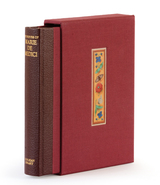 The Hours of Marie de Medici: A Facsimile
Marie de Medici
Bodleian Library Publishing, 2016 A stunning facsimile copy of an illuminated manuscript owned by the French queen Marie de Medici.
At the turn of the fifteenth century, private devotionals became a specialty of the renowned Ghent–Bruges illuminators. Wealthy patrons who commissioned work from these artists often spared no expense in the presentation of their personal prayer books, or “books of hours,” from detailed decoration to luxurious bindings and embroidery.
This manuscript owes its name to the French queen, Marie de Medici, widow of King Henri IV. The manuscript was painted by an artist known as the David Master, one of the renowned Flemish illuminators of the sixteenth century. Fine architectural interiors, gorgeous landscapes, and detailed city scenes form the subjects of three full-size illuminations and forty-two full-page miniatures. It is one of the finest examples of medieval illumination in a personal prayer book and the most copiously illustrated work of the David Master to survive.
Together with a scholarly introduction that gives an overview of Flemish illumination and examines each of the illustrations in detail, this full-color facsimile limited edition, bound in linen with a leather quarter binding and beautifully presented in a slipcase, faithfully reproduces all 176 leaves of the original manuscript.
House A
Jennifer S. Cheng
Omnidawn, 2016 House A investigates the tones and textures of immigrant home-building by asking: How is the body inscribed with a cosmology of home, and vice versa? With evocative and intellectual precision, House A weaves personal, discursive, and lyrical textures to invoke the immersive-obscured experience of an immigrant home’s entanglement while mapping a new poetics of American Home, steeped in longing and rooted by displacement.
House A is the winner of the 2015 Omnidawn 1st/2nd Poetry Book Prize, selected by Claudia Rankine.
 House and Home in Modern Japan: Architecture, Domestic Space, and Bourgeois Culture, 1880-1930
Jordan Sand
Harvard University Press, 2003 A house is a site, the bounds and focus of a community. It is also an artifact, a material extension of its occupants’ lives. This book takes the Japanese house in both senses, as site and as artifact, and explores the spaces, commodities, and conceptions of community associated with it in the modern era.
As Japan modernized, the principles that had traditionally related house and family began to break down. Even where the traditional class markers surrounding the house persisted, they became vessels for new meanings, as housing was resituated in a new nexus of relations. The house as artifact and the artifacts it housed were affected in turn. The construction and ornament of houses ceased to be stable indications of their occupants’ social status, the home became a means of personal expression, and the act of dwelling was reconceived in terms of consumption. Amid the breakdown of inherited meanings and the fluidity of modern society, not only did the increased diversity of commodities lead to material elaboration of dwellings, but home itself became an object of special attention, its importance emphasized in writing, invoked in politics, and articulated in architectural design. The aim of this book is to show the features of this culture of the home as it took shape in Japan.
 The House and Senate in the 1790s: Petitioning, Lobbying, and Institutional Development
Kenneth R. Bowling
Ohio University Press, 2002 Amid the turbulent swirl of foreign intrigue, external and internal threats to the young nation’s existence, and the domestic partisan wrangling of the 1790s, the United States Congress solidified its role as the national legislature. The ten essays in The House and Senate in the 1790s demonstrate the mechanisms by which this bicameral legislature developed its institutional identity. The first essay sets the scene for the institutional development of Congress by examining its constitutional origins and the efforts of the Founders to empower the new national legislature. The five following essays focus on two related mechanisms—petitioning and lobbying—by which citizens and private interests communicated with national lawmakers.
Although scholars tend to see lobbying as a later nineteenth-century development, the papers presented here clearly demonstrate the existence of lobbyists and lobbying in the 1790s. The final four papers examine other aspects of the institutional development of the House and the Senate, including the evolution of political parties and congressional leadership.
The essays in this collection, the third volume in the series Perspectives on the History of Congress, 1789-1801, originated in a series of conferences held by the United States Capitol Historical Society from 1994 to 2001.
House and Street: The Domestic World of Servants and Masters in Nineteenth-Century Rio de Janeiro
By Sandra Lauderdale Graham
University of Texas Press, 1992 During the later half of the nineteenth century, a majority of Brazilian women worked, most as domestic servants, either slave or free. House and Street re-creates the working and personal lives of these women, drawing on a wealth of documentation from archival, court, and church records. Lauderdale Graham traces the intricate and ambivalent relations that existed between masters and servants. She shows how for servants the house could be a place of protection—as well as oppression—while the street could be dangerous—but also more autonomous. She integrates her discoveries with larger events taking place in Rio de Janeiro during the period, including the epidemics of the 1850s, the abolition of slavery, the demolition of slums, and major improvements in sanitation during the first decade of the 1900s.
The House as Open Form: The Hansens' Summer Residence in Szumin: Dom jako Forma Otwarta. Szumin Hansenów
Aleksandra Kedziorek, Filip Springer, and Jan Smaga
Museum of Modern Art in Warsaw, 2014 This beautifully illustrated volume offers a photographic tour of the iconic house of Polish architect couple: Oskar Hansen, member of Team 10, and his wife, Zofia. Located in Szumin in central Poland and designed in 1968, the house serves as a spatial manifesto of Hansen’s theory of Open Form, an inspiring concept aimed at opening the architecture for its users’ participation and transforming it into a passe-partout for everyday life. An essay on the house and its conceptual underpinnings by journalist Filip Springer accompanies striking photographs by Jan Smaga, and the resulting book is both a portrait of a specific dwelling and a larger analysis of the very idea of architects’ houses and their relationship to their owners’ work.
The House at the Top of the Bottoms: A Depression-Era Story
Michael L. Lockett
Parkhurst Brothers, Inc., 2021 An 11 year-old boy moves with his parents who have been evicted from a family farm in Wisconsin to live near his maternal grandparents in central Illinois. There, he discovers abandoned mine shafts which he explores with his grandfather's dog that suffers from flatulence. A stranger in town, the narrator is keenly aware of his outsider status and takes refuge in family, the dog, and his secret place in one of the abandoned coal mine shafts cut into the bank of the river bottoms under his grandparent's house. His acumen as an explorer comes in handy when another student--son of the local banker--goes missing.
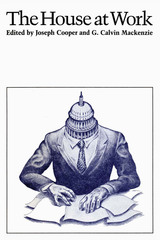 The House at Work
Edited by Joseph Cooper and G. Calvin Mackenzie
University of Texas Press, 1981 There exists a rich literature on the workings of the United States Congress, but The House at Work is the first book to focus on the institutional performance of the House of Representatives. A complete overview of the complex functioning and dynamics of Congress is presented by distinguished contributors, drawing upon both real-life experience and organization theory.
Each essay presents material on activities central to legislative work in the House, including the internal operations of member and committee offices, the administrative support system of the House, the impact of organizational structure and information resources on individual decision making, the expanding application of computer technology, the character of the personnel system, and the processing of constituent casework.
Nearly all contributors were professional staff members of the U.S. House Commission on Administrative Review in 1976 and 1977, whose analysis of the internal operations of the House was acomprehensive investigation. Their academic training, buttressed by significant practical experience on Capitol Hill, makes this book of great value to both students and scholars of the legislative process. In addition to the editors, the contributors include Glenn R. Parker, Thomas E. Cavanagh, Allan J. Katz, John R. Johannes, Thomas J. O'Donnell, David W. Brady, Louis Sandy Maisel, Susan Webb Hammond, Jarold A. Kieffer, James A. Thurber, and Jeffrey A. Goldberg.
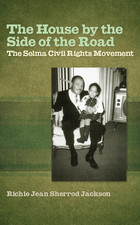 The House by the Side of the Road: The Selma Civil Rights Movement
Richie Jean Sherrod Jackson
University of Alabama Press, 2011 On Sunday, March 7, 1965, Martin Luther King Jr. and six hundred followers set out on foot from Selma, Alabama, bound for Montgomery to demand greater voting rights for African Americans. As they crossed the city’s Edmund Pettus Bridge, state and local policemen savagely set on the marchers with tear gas and billy clubs, an event now known as “Bloody Sunday” that would become one of the most iconic in American history.
King’s informal headquarters in Selma was the home of Dr. Sullivan and Richie Jean Sherrod Jackson and their young daughter, Jawana. The House by the Side of the Road is Richie Jean’s firsthand account of the private meetings King and his lieutenants, including Ralph David Abernathy and John Lewis, held in the haven of the Jackson home.
Sullivan Jackson was an African American dentist in Selma and a prominent supporter of the civil rights movement. Richie Jean was a close childhood friend of King’s wife, Coretta Scott King, a native of nearby Marion, Alabama. Richie Jean’s fascinating account narrates how, in the fraught months of 1965 that preceded the Voting Rights March, King and his inner circle held planning sessions and met with Assistant Attorney General John Doar to negotiate strategies for the event.
Just eight days after Bloody Sunday, President Lyndon Johnson made a televised addressed to a joint session of Congress on Monday, March 15. Jackson relates the intimate scene of King and his lieutenants watching as Johnson called the nation to dedicate itself to equal rights for all and ending his address with the words: “We shall overcome.” Five months later, Congress passed the 1965 Voting Rights Act on August 6.
The major motion picture Selma now commemorates the fiftieth anniversary of Bloody Sunday and the 1965 Voting Rights Act. In it, Niecy Nash and Kent Faulcon star as Sullivan and Richie Jean Jackson among a cast including Oprah Winfrey, Tom Wilkinson, and Cuba Gooding Jr. A gripping primary source, The House by the Side of the Road illuminates the private story whose public outcomes electrified the world and changed the course of American history.
The House Cross of the Mayo Indians of Sonora, Mexico
N. Ross Crumrine
University of Arizona Press, 1965 The Anthropological Papers of the University of Arizona is a peer-reviewed monograph series sponsored by the School of Anthropology. Established in 1959, the series publishes archaeological and ethnographic papers that use contemporary method and theory to investigate problems of anthropological importance in the southwestern United States, Mexico, and related areas.
A House Divided: A Study of Statehood Politics and the Copperhead Movement in West Virginia
Richard Orr Curry
University of Pittsburgh Press, 1964
In A House Divided, Richard Orr Curry investigates the political realities that led to the breakup of the Old Dominion and the emergence of a new state during the Civil War. Orr's analysis of the intra-state conflicts over political, economic, and social issues, party factions of Unionism and Secessionism and multiple layers of division within those factions, offer fascinating and original insights into the long debate that would lead to the ratification of the West Virginia state constitution in 1863.
A House Divided: Orthodoxy and Schism in Nineteenth-Century Central European Jewry
Jacob Katz
University Press of New England, 2005 Eminent social historian Jacob Katz examines the rise and transformation of Jewish communal leadership in Central Europe. It is a story of fragmentation and polarization that sheds light on the tensions within the 19th-century Jewish community in Central Europe as it struggled to respond to the promises and perils of modernization.
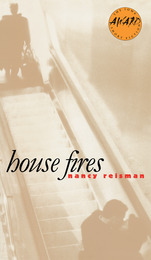 House Fires
Nancy Reisman
University of Iowa Press, 1999 These eleven stories travel from snowbound Buffalo in the 1940s to present-day Boston, Providence, and San Francisco and across the domestic terrain of desire's unruly claims to the nuances of grief. In the title story, a young woman whose sister has been killed in a fire reckons with her parents' silent suffering and finds transcendence through film. In a series of stories set in post-World War II Buffalo and Manhattan, the members of a close-knit Jewish family are caught up in a maze of clandestine desires—none of which can be fulfilled. The collection's final series turns to one family's complex generational links: a college student confronted by her own assumptions about race and sexuality; a grandmother slipping into mental decline; a middle-aged mother juggling bewilderment, love, and grief. Passion and heartbreak are often intertwined in these stories as Reisman reveals the ways in which women and men are inevitably shaped by their histories and the ways in which their bodies carry the legacy of loss.
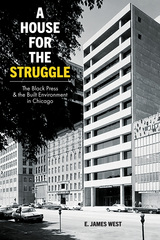 A House for the Struggle: The Black Press and the Built Environment in Chicago
E. James West
University of Illinois Press, 2022 Multiple Award-Winner! - Winner of the 2023 Michael Nelson Prize of International Association for Media and History (IAMHIST)
- Recipient of the 2022 Jane Jacobs Urban Communication Book Award
- Winner of the 2023 American Journalism Historians Association Book of the Year
- Winner of the 2023 ULCC’s (Union League Club of Chicago) Outstanding Book on the History of Chicago Award
- Recipient of a 2023 Best of Illinois History Superior Achievement award from the Illinois State Historical Society
- Winner of the 2023 BAAS Book Prize (British Association for American Studies)
- Winner of a 2023 The Brinck Book Award and Lecture series (University of New Mexico School of Architecture + Planning)
- Honorable Mention for the 2021-22 RSAP Book Prize (Research Society for American Periodicals)
Buildings once symbolized Chicago's place as the business capital of Black America and a thriving hub for Black media. In this groundbreaking work, E. James West examines the city's Black press through its relationship with the built environment. As a house for the struggle, the buildings of publications like Ebony and the Chicago Defender embodied narratives of racial uplift and community resistance. As political hubs, gallery spaces, and public squares, they served as key sites in the ongoing Black quest for self-respect, independence, and civic identity. At the same time, factors ranging from discriminatory business practices to editorial and corporate ideology prescribed their location, use, and appearance, positioning Black press buildings as sites of both Black possibility and racial constraint. Engaging and innovative, A House for the Struggle reconsiders the Black press's place at the crossroads where aspiration collided with life in one of America's most segregated cities.
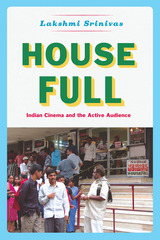 House Full: Indian Cinema and the Active Audience
Lakshmi Srinivas
University of Chicago Press, 2016 India is the largest producer and consumer of feature films in the world, far outstripping Hollywood in the number of movies released and tickets sold every year. Cinema quite simply dominates Indian popular culture, and has for many decades exerted an influence that extends from clothing trends to music tastes to everyday conversations, which are peppered with dialogue quotes.
With House Full, Lakshmi Srinivas takes readers deep into the moviegoing experience in India, showing us what it’s actually like to line up for a hot ticket and see a movie in a jam-packed theater with more than a thousand seats. Building her account on countless trips to the cinema and hundreds of hours of conversation with film audiences, fans, and industry insiders, Srinivas brings the moviegoing experience to life, revealing a kind of audience that, far from passively consuming the images on the screen, is actively engaged with them. People talk, shout, whistle, cheer; others sing along, mimic, or dance; at times audiences even bring some of the ritual practices of Hindu worship into the cinema, propitiating the stars onscreen with incense and camphor. The picture Srinivas paints of Indian filmgoing is immersive, fascinating, and deeply empathetic, giving us an unprecedented understanding of the audience’s lived experience—an aspect of Indian film studies that has been largely overlooked.
 House Garden
John Engels
University of Notre Dame Press, 2001 What happened to Adam and Eve after they were expelled from the Garden of Eden? In John Engels' beautiful new collection of poetry, House and Garden, they move to a town resembling Burlington, Vermont, and set up a home, complete with a deck and garden. In their new location, they continue to pursue the task of naming creation, with varying degrees of diligence and introspection.
In this series of richly textured monologues, Adam and Eve don't know quite how to speak to one another, though each remains obsessed with the other. Individual poems reflect their innermost thoughts as they go about the business of living through changing seasons and deep feelings of loss and yearning. Moving back and forth between the voices of Adam and Eve in a world now prey to time, change, and death, Engels' poems explore how the movement of seasons reflects nature's tendency to move independent of any human effort at order through the act of naming.
House and Garden brims with the unforgettable imagery of "great flowers of the garden alive to the memory of light," "the yellow dust of a dry sun," "nights like breath stopping," "the muddy fires of the Torment," and "the dense quiet of an October rain." This eloquent volume enlivens the senses as much as it challenges heart, mind, and spirit.
JOHN ENGELS is the author of ten volumes of poetry and is professor of English at St. Michael's College. A graduate of the Iowa Writer's Workshop, he has garnered numerous awards for his poetry, including being named a finalist for the Pulitzer Prize. Engels is a recipient of the Guggenheim Fellowship, two National Endowment for the Arts Fellowships, and was a Rockefeller Foundation resident at Bellagio. His poems have appeared in the Nation, the New Yorker, Harper's, and many other publications.
"Who but John Engels can make us ‘dance awobble / on the great circle of the ecliptic'? He's a poet of such power that the very planet itself whispers its secrets in his ear." --David Huddle
"I can think of no other poet writing today who can more tangibly describe the living world or express the joys and sorrows of living in it than John Engels." --R. H. W. Dillard
"I had a hand in the publication of John Engels's first book of poetry more than three decades ago. I thought then that he should receive honors and prizes for his work. Now with a publication of a tenth book of his poetry, I feel this even more strongly. His is an enduring, sonorous gift to American literature. We are fortunate that he has kept the faith in our tone deaf age. Bravo!" --Paul Zimmer
"It is a pleasure to read John Engels' House and Garden. I have long regarded him as one of the best American poets of his generation. Engels' capacity to amalgamate lyricism, craft, intelligence, and spirituality, all in the interest of creating a humanizing and humanized document, radiates in House and Garden, which should be a model for contemporary letters." --Sydney Lea
"With passion and precision, John Engels articulates a great love affair with what we know of life--and exile--in the east of Eden. He holds these poems ‘at the poise of limit' in order to examine what is most human: our ability to love in an imperfect world, our impulse to name--which originates in loss, and especially our ‘habitable' silences." --Judith Kitchen
"Who but John Engels can make us ‘dance awobble / on the great circle of the ecliptic'? He's a poet of such power that the very planet itself whispers its secrets in his ear." --David Huddle
"I can think of no other poet writing today who can more tangibly describe the living world or express the joys and sorrows of living in it than John Engels." --R. H. W. Dillard
"I had a hand in the publication of John Engels's first book of poetry more than three decades ago. I thought then that he should receive honors and prizes for his work. Now with a publication of a tenth book of his poetry, I feel this even more strongly. His is an enduring, sonorous gift to American literature. We are fortunate that he has kept the faith in our tone deaf age. Bravo!" --Paul Zimmer
"It is a pleasure to read John Engels' House and Garden. I have long regarded him as one of the best American poets of his generation. Engels' capacity to amalgamate lyricism, craft, intelligence, and spirituality, all in the interest of creating a humanizing and humanized document, radiates in House and Garden, which should be a model for contemporary letters." --Sydney Lea
"With passion and precision, John Engels articulates a great love affair with what we know of life--and exile--in the east of Eden. He holds these poems ‘at the poise of limit' in order to examine what is most human: our ability to love in an imperfect world, our impulse to name--which originates in loss, and especially our ‘habitable' silences." --Judith Kitchen
JOHN ENGELS is the author of ten volumes of poetry and is professor of English at St. Michael's College. A graduate of the Iowa Writer's Workshop, he has garnered numerous awards for his poetry, including being named a finalist for the Pulitzer Prize. Engels is a recipient of the Guggenheim Fellowship, two National Endowment for the Arts Fellowships, and was a Rockefeller Foundation resident at Bellagio. His poems have appeared in the Nation, the New Yorker, Harper's, and many other publications.
----------
"Engels has shown himself to be a thrillingly precise poet of domestic nature.... [H]ere he informs that capability with a theology of the word." -Booklist, October 1, 2001
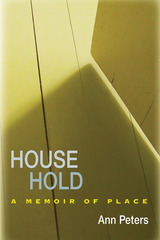 House Hold: A Memoir of Place
Ann Peters
University of Wisconsin Press, 2013 Like the house built by Ann Peters’s father on a hill in eastern Wisconsin, House Hold offers many views: cornfields and glacial lakes, fast food parking lots and rural highways, Manhattan apartments and Brooklyn brownstones. Peters revisits the modern split-level where she grew up in Wisconsin, remembering her architect father. Against the background of this formative space, she charts her roaming story through two decades of New York City apartments, before traveling to a cabin in the mountains of Colorado and finally purchasing an old farmhouse in upstate New York.
More than a memoir of remembered landscapes, House Hold is also an expansive contemplation of America, a meditation on place and property, and an exploration of how literature shapes our thinking about the places we live. A gifted prose stylist, Peters seamlessly combines her love of buildings with her love of books. She wanders through the rooms of her past but also through what Henry James called “the house of fiction,” interweaving personal narrative with musings on James, Willa Cather, William Dean Howells, Paule Marshall, William Maxwell, and others. Peters reflects on the romance of pastoral retreat, the hazards of nostalgia, America’s history of expansion and land ownership, and the conflicted desires to put down roots and to hit the road. Throughout House Hold, she asks how places make us who we are.
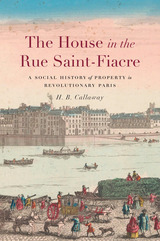 The House in the Rue Saint-Fiacre: A Social History of Property in Revolutionary Paris
H. B. Callaway
Harvard University Press, 2023 A bold account of property reform during the French Revolution, arguing that the lofty democratic ideals enshrined by revolutionary leaders were rarely secured in practice—with lasting consequences.
Property reform was at the heart of the French Revolution. As lawmakers proclaimed at the time, and as historians have long echoed, the Revolution created modern property rights. Under the new regime, property was redefined as an individual right to which all citizens were entitled. Yet as the state seized assets and prepared them for sale, administrators quickly found that realizing the dream of democratic property rights was far more complicated than simply rewriting laws.
H. B. Callaway sifts through records on Parisian émigrés who fled the country during the Revolution, leaving behind property that the state tried to confiscate. Immediately, officials faced difficult questions about what constituted property, how to prove ownership, and how to navigate the complexities of credit arrangements and family lineage. Mothers fought to protect the inheritances of their children, tenants angled to avoid rent payments, and creditors sought their dues. In attempting to execute policy, administrators regularly exercised their own judgment on the validity of claims. Their records reveal far more continuity between the Old Regime and revolutionary practices than the law proclaimed. Property ownership continued to depend on webs of connections beyond the citizen-state relationship, reinforced by customary law and inheritance traditions. The resulting property system was a product of contingent, on-the-ground negotiations as much as revolutionary law.
The House in the Rue Saint-Fiacre takes stock of the contradictions on which modern property rights were founded. As Callaway shows, the property confiscations of Parisian émigrés are a powerful, clarifying lens on the idea of ownership even as it exists today.
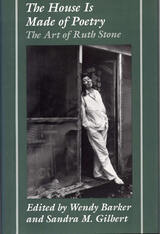 The House is Made of Poetry: The Art of Ruth Stone
Edited by Wendy Barker and Sandra M. Gilbert
Southern Illinois University Press, 1996 Ruth Stone has always eschewed self-promotion and, in the words of Leslie Fiedler, "has never been a member of any school or clique or gaggle of mutual admirers." But her poems speak so vibrantly for her that she cannot be ignored. In her preface to this volume, Sandra M. Gilbert declares that Stone’s "intense attention to the ordinary transforms it into (or reveals it as) the extraordinary. Her passionate verses evoke impassioned responses." At the same time, Gilbert continues, the essays collected here "consistently testify to Stone’s radical unworldliness, in particular her insouciant contempt for the ‘floor walkers and straw bosses’ who sometimes seem to control the poetry ‘factory’ both inside and outside the university." Wendy Barker and Sandra Gilbert have organized the book into three sections: "Knowing Ruth Stone," "A Life of Art," and "Reading Ruth Stone." In "Knowing Ruth Stone," writers of different generations who have known the poet over the years provide memoirs. Noting Stone’s singularity, Fiedler points out that "she resists all labels" and is "one of the few contemporaries whom it is possible to think of simply as a ‘poet.’" Sharon Olds defines her vitality ("A Ruth Stone poem feels alive in the hands"), and Jan Freeman praises her aesthetic intensity ("Everything in the life of Ruth Stone is integrated with poetry"). "A Life of Art" sketches the outlines of Stone’s career and traces her evolution as a poet. Barker and Norman Friedman, for example, trace her development from the "high spirits and elegant craft" of her first volume—Inan Iridescent Time— through the "deepening shadows," "poignant wit," and "bittersweet meditations" of her later work. In interviews separated by decades (one in the 1970s and one in the 1990s), Sandra Gilbert and Robert Bradley discuss with Stone her own sense of her aesthetic origins and literary growth. "Reading Ruth Stone" is an examination of Stone’s key themes and modes. Diane Wakoski and Diana O’Hehir focus on the tragicomic vision that colors much of her work; Kevin Clark and Elyse Blankley explore the political aspects of her poetry; Roger Gilbert analyzes her "often uncannily astute insights into the ‘otherness’ of other lives"; Janet Lowery and Kandace Brill Lombart draw on the biographical background of Stone’s "grief work"; and Sandra Gilbert studies her caritas, her empathic love that redeems pain.
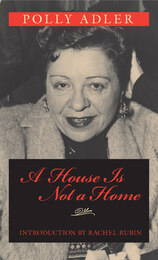 A House Is Not a Home
Polly Adler
University of Massachusetts Press, 2006 Polly Adler's "house"—the brothel that gave this best-selling 1953 autobiography its title—was a major site of New York City underworld activity from the 1920s through the 1940s. Adler's notorious Lexington Avenue house of prostitution functioned as a sort of social club for New York's gangsters and a variety of other celebrities, including Robert Benchley and his friend Dorothy Parker. According to one New York tabloid, it made Adler's name "synonymous with sin."
This new edition of Adler's autobiography brings back into print a book that was a mass phenomenon, in both hardback and paperback, when it was first published. A self-consciously literary work, A House Is Not a Home provides an informal social history of immigrant mobility, prostitution, Jewish life in New York, police dishonesty, the "white slavery" scare of the early twentieth century, and political corruption.
Adler's story fills an important gap in the history of immigrant life, urban experience, and organized crime in New York City. While most other accounts of the New York underworld focus on the lives of men, from Herbert Asbury's Gangs of New York through more recent works on Jewish and Italian gangsters, this book brings women's lives and problems to the forefront.
A House Is Not a Home is compellingly readable and was popular enough to draw Hollywood's attention in the early 1960s—leading to a film starring Shelley Winters as Adler. The book has been largely forgotten in the ensuing decades, lost both to its initial audience of general readers and to scholars in women's studies, immigration history, and autobiography who are likely to find it a treasure trove. Now, with a new introduction by Rachel Rubin that contextualizes Adler's life and literary achievement, A House Is Not a Home is again available to the many readers who have come to understand such "marginal" life stories as a special refraction of the more typical American success narrative.
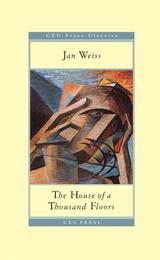 The House of a Thousand Floors
Jan Weiss
Central European University Press, 2017 The House of a Thousand Floors is one of the earliest science-fiction novels in European literature, published first in 1929. Besides being a pioneer in its genre, the book is highly regarded for its general merits as psychological literature. The novel tells the story of a dream in fever of a soldier wounded in World War I. He finds himself in the stairway of a gigantic (and kafkaesque) tower-like building, which is a metaphor for modern society. He learns that his task is to rescue Princess Tamara from Muller, the lord of the edifice. After a number of surrealistic encounters in the building, during which he is hailed as a liberator by many and is hunted by the cruel security guards, the main character finds Tamara and faces the cruel lord of Mullerdom. The novel makes fine use of a range of experimental styles and techniques. At times, linear storytelling gives way to a collage of incongruous elements: excerpts from fictitious books, encyclopedia articles, radio broadcast transcripts are used as a shortcut to describe places or events; other narrative ingredients include fanciful advertisements, ludicrous administrative documents or political slogans which highlight the idiosyncrasies of this decadent world.
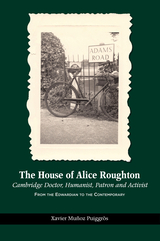 The House of Alice Roughton: Cambridge Doctor, Humanist, Patron and Activist: From the Edwardian to the Contemporary
Xavier Munoz Puiggros
Sussex Academic Press, 2022 From her home at 9 Adams Road in the university city of Cambridge, Alice Roughton (1900–1995) demonstrated a strongly altruistic lifestyle, housing young students, the mentally ill, artists, intellectuals, friends, persecuted homosexuals and refugees (German Jews in 1939, Hungarians in 1956 and Chileans in 1973). She practiced psychiatry and general medicine alongside personal activism such as medics against nuclear warfare and opposing the financing of urbanisation – the latter related to the destruction of the historical centres of English cities.
Alice was a patron of artists and intellectuals, including the Catalan musician Robert Gerhard and the German dancer Kurt Jooss. She befriended the economists J. M. Keynes and Joan Robinson, the philosopher Bertrand Russell, the astrophysicist Stephen Hawking, the molecular biologist James Watson, as well as the composer Benjamin Britten, who held memorable concerts at her house, as well as many other dignitaries of science and the humanities.
The House of Alice Roughton locates her professional medical work and private life activities and relationships within the sociological circumstances within which she lived – circumstances that reveal the historical and cultural changes of a century that experienced two world wars, the advance of science and the overturning of lifestyle prejudices. The biography revolves around one location – 9 Adams Road. Alice and her family’s lived experiences act as a window onto the profound global transformations which took place from the second industrial revolution to the discovery of the structure of DNA – From the Edwardian to the Contemporary. Her family’s life story moves through tragic events in Switzerland to her husband's war years in America. Her biographer’s engagement with Alice begins in 1978, on a student holiday trip from his native Catalonia.
 The House of Atreus
John Lewin
University of Minnesota Press, 1966
The House of Atreus, adapted by John Lewin was first published in 1966. Minnesota Archive Editions uses digital technology to make long-unavailable books once again accessible, and are published unaltered from the original University of Minnesota Press editions.This adaptation of the classic Greek trilogy is designed for contemporary stage presentation and is the version to be used by the Minnesota Theatre Company or its production of the work at the Tyrone Guthrie Theatre in Minneapolis. The volume provides the texts of the three plays, Agamemnon, The Libation Bearers, and The Furies, and, in addition, a director’s introduction by Sir Tyrone Guthrie and an adapter’s introduction by John Lewin.In his introduction, Guthrie points out that fidelity neither to the literal meaning of the original nor to the distinctive spirit of the Oresteia is necessarily the supreme virtue for a stage version of this work. In performance, he explains, the music of verse is almost as important in conveying its meaning as is the syntax, and thus this version, The House of Atreus, with its simple and lyrical choruses, has been created to provide an interesting and vivid dramatic vehicle.In a perceptive and illuminating discussion of the plays in his introduction, John Lewin demonstrates the need for the kinds of changes he has made in the scripts.
The House of Breath
William Goyen
Northwestern University Press, 1999 Readers can now rediscover one of William Goyen's most important works in this restoration of the original text. The House of Breath eschews traditional conventions of plot and character presentation. The book is written as an ethereal address to the people and places the narrator remembers from his childhood in a small Texas town. More than a story, it is a meditation on the nature of identity, origins, and memory.
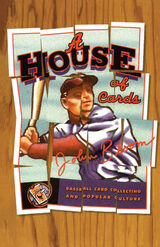 House Of Cards: Baseball Card Collecting and Popular Culture
John Bloom
University of Minnesota Press, 1997 Explores the connection between baseball card collecting and nostalgia among men of the baby boom. Baseball card collecting carries with it images of idealized boyhoods in the sprawling American suburbs of the postwar era. Yet in the past twenty years, it has grown from a pastime for children to a big-money pursuit taken seriously by adults. In A House of Cards, John Bloom uses interviews with collectors, dealers, and hobbyists as well as analysis of the baseball card industry and extensive firsthand observations to ask what this hobby tells us about nostalgia, work, play, masculinity, and race and gender relations among collectors. Beginning in the late 1970s and into the early 1990s, baseball card collecting grew into a business that embodied traditional masculine values such as competition, savvy, and industry. In A House of Cards, Bloom interviews collectors who reveal ambivalence about the hobby’s emphasis on these values, often focusing on its alienating, lonely, and unfulfilling aspects. They express nostalgia for the ideal childhood world many middle-class white males experienced in the postwar years, when they perceived baseball card collecting as a form of play, not a moneymaking enterprise. Bloom links this nostalgia to anxieties about deindustrialization and the rise of the civil rights, feminist, and gay rights movements. He examines the gendered nature of swap meets as well as the views of masculinity expressed by the collectors: Is the purpose of baseball card collecting to form a community of adults to reminisce or to inculcate young men with traditional masculine values? Is it to establish “connectedness” or to make money? Are collectors striving to reinforce the dominant culture or question it through their attempts to create their own meaning out of what are, in fact, mass-produced commercial artifacts? Bloom provides a fascinating exploration of male fan culture, ultimately providing insight into the ways white men of the baby boom view themselves, masculinity, and the culture at large. [Excerpt:]“Collectors often decried how money had ruined their hobby, making it hard for them to form meaningful friendships through their cards. Money, however, made the hobby not only profitable but also more serious, more instrumental, and therefore more manly. The same collectors who complained about greed often bragged in the same interview about the value of their cards. Yet money, in turn, made the hobby less akin to child’s play and more like work: lonely, competitive, unfulfilling, and alienating.”
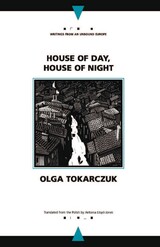 House of Day, House of Night
Olga Tokarczuk
Northwestern University Press, 2003 The English translation of the prize-winning international bestseller
Winner of the Gunter Grass Prize
Nowa Ruda is a small town in Silesia, an area that has been a part of Poland, Germany, and the former Czechoslovakia in the past. When the narrator moves into the area, she and discovers everyone-and everything-has its own story. With the help of Marta, her enigmatic neighbor, the narrator accumulates these stories, tracing the history of Nowa Ruda from the founding of the town to the lives of its saints, from the caller who wins the radio quiz every day to the tale of the man who causes international tension when he dies on the border, one leg on the Polish side, the other on the Czech side. Each of the stories represents a brick and they interlock to reveal the immense monument that is the town. What emerges is the message that the history of any place--no matter how humble--is limitless, that by describing or digging at the roots of a life, a house, or a neighborhood, one can see all the connections, not only with one's self and one's dreams but also with all of the universe.
Richly imagined, weaving in anecdote with recipes and gossip, Tokarczuk's novel is an epic of a small place. Since its original publication in 1998 it has remained a bestseller in Poland. House of Day, House of Night is the English-language debut of one of Europe's best young writers.
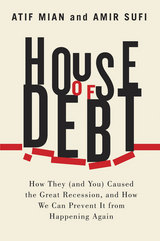 House of Debt: How They (and You) Caused the Great Recession, and How We Can Prevent It from Happening Again
Atif Mian and Amir Sufi
University of Chicago Press, 2014 The Great American Recession resulted in the loss of eight million jobs between 2007 and 2009. More than four million homes were lost to foreclosures. Is it a coincidence that the United States witnessed a dramatic rise in household debt in the years before the recession—that the total amount of debt for American households doubled between 2000 and 2007 to $14 trillion? Definitely not. Armed with clear and powerful evidence, Atif Mian and Amir Sufi reveal in House of Debt how the Great Recession and Great Depression, as well as the current economic malaise in Europe, were caused by a large run-up in household debt followed by a significantly large drop in household spending.
Though the banking crisis captured the public’s attention, Mian and Sufi argue strongly with actual data that current policy is too heavily biased toward protecting banks and creditors. Increasing the flow of credit, they show, is disastrously counterproductive when the fundamental problem is too much debt. As their research shows, excessive household debt leads to foreclosures, causing individuals to spend less and save more. Less spending means less demand for goods, followed by declines in production and huge job losses. How do we end such a cycle? With a direct attack on debt, say Mian and Sufi. More aggressive debt forgiveness after the crash helps, but as they illustrate, we can be rid of painful bubble-and-bust episodes only if the financial system moves away from its reliance on inflexible debt contracts. As an example, they propose new mortgage contracts that are built on the principle of risk-sharing, a concept that would have prevented the housing bubble from emerging in the first place.
Thoroughly grounded in compelling economic evidence, House of Debt offers convincing answers to some of the most important questions facing the modern economy today: Why do severe recessions happen? Could we have prevented the Great Recession and its consequences? And what actions are needed to prevent such crises going forward?
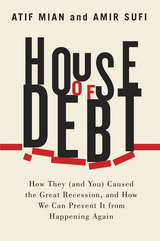 House of Debt: How They (and You) Caused the Great Recession, and How We Can Prevent It from Happening Again
Atif Mian and Amir Sufi
University of Chicago Press, 2014 The Great American Recession resulted in the loss of eight million jobs between 2007 and 2009. More than four million homes were lost to foreclosures. Is it a coincidence that the United States witnessed a dramatic rise in household debt in the years before the recession—that the total amount of debt for American households doubled between 2000 and 2007 to $14 trillion? Definitely not. Armed with clear and powerful evidence, Atif Mian and Amir Sufi reveal in House of Debt how the Great Recession and Great Depression, as well as the current economic malaise in Europe, were caused by a large run-up in household debt followed by a significantly large drop in household spending.
Though the banking crisis captured the public’s attention, Mian and Sufi argue strongly with actual data that current policy is too heavily biased toward protecting banks and creditors. Increasing the flow of credit, they show, is disastrously counterproductive when the fundamental problem is too much debt. As their research shows, excessive household debt leads to foreclosures, causing individuals to spend less and save more. Less spending means less demand for goods, followed by declines in production and huge job losses. How do we end such a cycle? With a direct attack on debt, say Mian and Sufi. More aggressive debt forgiveness after the crash helps, but as they illustrate, we can be rid of painful bubble-and-bust episodes only if the financial system moves away from its reliance on inflexible debt contracts. As an example, they propose new mortgage contracts that are built on the principle of risk-sharing, a concept that would have prevented the housing bubble from emerging in the first place.
Thoroughly grounded in compelling economic evidence, House of Debt offers convincing answers to some of the most important questions facing the modern economy today: Why do severe recessions happen? Could we have prevented the Great Recession and its consequences? And what actions are needed to prevent such crises going forward?
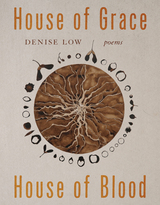 House of Grace, House of Blood: Poems
Denise Low
University of Arizona Press, 2024 Intertwining a lyrical voice with historical texts, poet Denise Low brings fresh urgency to the Gnadenhutten Massacre. In 1782, a renegade Pennsylvania militia killed ninety-six pacificist Christian Delawares (Lenapes) in Ohio. Those who escaped, including Indigenous eyewitnesses, relayed their accounts of the atrocity. Like Layli Longsoldier’s Whereas and Simon Ortiz’s from Sand Creek, Low delves into a critical incident of Indigenous peoples’ experiences. Readers will explore with the poet how trauma persists through hundreds of years, and how these peoples have survived and flourished in the subsequent generations.
In a personal poetic treatment of documents, oral tradition, and images, the author embodies the contradictions she unravels. From a haunting first-person perspective, Low’s formally inventive archival poetry combines prose and lyric, interweaving verse with historical voices in a dialogue with the source material. Each poem builds into a larger narrative on American genocide, the ways in which human loss corresponds to ecological destruction, and how intimate knowledge of the past can enact healing.
Ultimately, these poems not only reconstruct an important historical event, but they also put pressure on the gaps, silences, and violence of the archive. Low asks readers to question not only what is remembered, but how history is remembered—and who is forgotten from it. Reflecting on the injustice of the massacre, the Shawnee leader Tecumseh lamented that though “the Americans murdered all the men, women, and children, even as they prayed to Jesus . . . no American ever was punished, not one.” These poems challenge this attempted erasure.
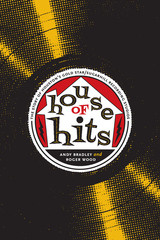 House of Hits: The Story of Houston's Gold Star/SugarHill Recording Studios
By Andy Bradley and Roger Wood
University of Texas Press, 2010 Founded in a working-class neighborhood in southeast Houston in 1941, Gold Star/SugarHill Recording Studios is a major independent studio that has produced a multitude of influential hit records in an astonishingly diverse range of genres. Its roster of recorded musicians includes Lightnin' Hopkins, George Jones, Willie Nelson, Bobby "Blue" Bland, Junior Parker, Clifton Chenier, Sir Douglas Quintet, 13th Floor Elevators, Freddy Fender, Kinky Friedman, Ray Benson, Guy Clark, Lucinda Williams, Beyoncé and Destiny's Child, and many, many more. In House of Hits, Andy Bradley and Roger Wood chronicle the fascinating history of Gold Star/SugarHill, telling a story that effectively covers the postwar popular music industry. They describe how Houston's lack of zoning ordinances allowed founder Bill Quinn's house studio to grow into a large studio complex, just as SugarHill's willingness to transcend musical boundaries transformed it into of one of the most storied recording enterprises in America. The authors offer behind-the-scenes accounts of numerous hit recordings, spiced with anecdotes from studio insiders and musicians who recorded at SugarHill. Bradley and Wood also place significant emphasis on the role of technology in shaping the music and the evolution of the music business. They include in-depth biographies of regional stars and analysis of the various styles of music they represent, as well as a list of all of Gold Star/SugarHill's recordings that made the Billboard charts and extensive selected historical discographies of the studio's recordings.
House of Houses
Pat Mora
University of Arizona Press, 1997 Combining poetic language and the traditions of magic realism to paint a vivid portrait of her family, Pat Mora’s House of Houses is an unconventional memoir that reads as if every member, death notwithstanding, is in one room talking, laughing, and crying. In a salute to the Day of the Dead, the story begins with a visit to the cemetery in which all of her deceased relatives come alive to share stories of the family, literally bringing the food to their own funerals. From there the book covers a year in the life of her clan, revealing the personalities and events that Mora herself so desperately yearns to know and understand.
 House Of Incest
Anaïs Nin
Ohio University Press, 1958
With an introduction by Allison Pease, this new edition of House of Incest is a lyrical journey into the subconscious mind of one of the most celebrated feminist writers of the twentieth-century.
Originally published in 1936, House of Incest is Anaïs Nin’s first work of fiction. Based on Nin’s dreams, the novel is a surrealistic look within the narrator’s subconscious as she attempts to distance herself from a series of all-consuming and often taboo desires she cannot bear to let go. The incest Nin depicts is a metaphor—a selfish love wherein a woman can appreciate only qualities in a lover that are similar to her own. Through a descriptive exploration of romances and attractions between women, between a sister and her beloved brother, and with a Christ-like man, Nin’s narrator discovers what she thinks is truth: that a woman’s most perfect love is of herself. At first, this self-love seems ideal because it is attainable without fear and risk of heartbreak. But in time, the narrator’s chosen isolation and self-possessed anguish give way to a visceral nightmare from which she is unable to wake.
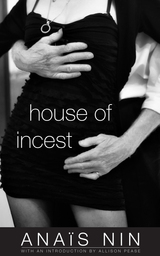 House of Incest
Anaïs Nin
Ohio University Press, 1958 With an introduction by Allison Pease, this new edition of House of Incest is a lyrical journey into the subconscious mind of one of the most celebrated feminist writers of the twentieth-century. Originally published in 1936, House of Incest is Anaïs Nin’s first work of fiction. Based on Nin’s dreams, the novel is a surrealistic look within the narrator’s subconscious as she attempts to distance herself from a series of all-consuming and often taboo desires she cannot bear to let go. The incest Nin depicts is a metaphor—a selfish love wherein a woman can appreciate only qualities in a lover that are similar to her own. Through a descriptive exploration of romances and attractions between women, between a sister and her beloved brother, and with a Christ-like man, Nin’s narrator discovers what she thinks is truth: that a woman’s most perfect love is of herself. At first, this self-love seems ideal because it is attainable without fear and risk of heartbreak. But in time, the narrator’s chosen isolation and self-possessed anguish give way to a visceral nightmare from which she is unable to wake.
The House of Make-Believe: Children’s Play and the Developing Imagination
Dorothy G. Singer and Jerome L. Singer
Harvard University Press, 1990 In the most thorough attempt to cover all aspects of children’s make-believe, Dorothy and Jerome Singer examine how imaginative play begins and develops, from the infant’s first smiles to the toddler’s engagement in social pretend play. They provide intriguing examples and research evidence on the young child’s invocation of imaginary friends, the adolescent’s daring, rule-governed games, and the adult’s private imagery and inner thought. In chapters that will be important to parents and policymakers, the authors discuss television and the imagination, the healing function of play, and the effects of playfulness and creativity throughout the life span.
House of McQueen
Valerie Wallace
Four Way Books, 2018 Winner of the Four Way Books Intro Prize as selected by Vievee Francis, Valerie Wallace’s House of McQueen is a fascinating, glittering debut by an assured new voice. Inhabiting the life and work of Alexander McQueen, Wallace builds a fantastical world using both original language and excerpts drawn from interviews, supermodels, Shakespeare, Poe, and more. At turns fierce and vulnerable, precise and decadent, here is a collection that leaps from runway to fairytale to street with wild, brilliant grace.
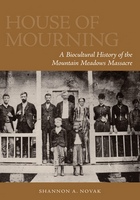 House of Mourning: A Biocultural History of the Mountain Meadows Massacre
Shannon A Novak
University of Utah Press, 2008 On September 11, 1857, some 120 men, women, and children from the Arkansas hills were murdered in the remote desert valley of Mountain Meadows, Utah. This notorious massacre was, in fact, a mass execution: having surrendered their weapons, the victims were bludgeoned to death or shot at point-blank range. The perpetrators were local Mormon militiamen whose motives have been fiercely debated for 150 years. In House of Mourning, Shannon A. Novak goes beyond the question of motive to the question of loss. Who were the victims at Mountain Meadows? How had they settled and raised their families in the American South, and why were they moving west once again? What were they hoping to find or make for themselves at the end of the trail? By integrating archival records and oral histories with the first analysis of skeletal remains from the massacre site, Novak offers a detailed and sensitive portrait of the victims as individuals, family members, cultural beings, and living bodies. The history of the massacre has often been treated as a morality tale whose chief purpose was to vilify (or to glorify) some collective body. Resisting this tendency to oversimplify the past, Novak explores Mountain Meadows as a busy and dangerous intersection of cultural and material forces in antebellum America. House of Mourning is a bold experiment in a new kind of history, the biocultural analysis of complex events.
Winner of the Society for Historical Archaeology James Deetz Book Award.
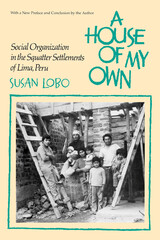 A House of My Own: Social Organization in the Squatter Settlements of Lima, Peru
Susan Lobo
University of Arizona Press, 1982 "A fairly comprehensive monograph, highly suitable for classroom use, that offers a wide range of information fit into traditional anthropological categories. . . . an interesting study of cultural integrity and pattern in a setting of what appears to be complex sociopolitical chaos." —American Anthropologist
"Whether or not one accepts Susan Lobo's optimistic analysis, her ability to translate the apparent chaos of shanty-town lives into such neat patterns and to help outsiders view life as the inhabitants do are important contributions." —Inter-American Review of Bibliography
"An extremely competent ethnography, simple and straightforward." —Anthropos
"A pleasure to read, a mine of information which will be useful in teaching students to formulate their own hypotheses." —International Journal of Urban & Regional Research
"Very well written and provides a great wealth of the liveliest sort of ethnographic detail." —Latin American Research Review
"Lobo's study of two squatter settlements in Lima provides a solid, well-written, detailed, traditional ethnography of poor families in a Third World urban setting." —Hispanic American Historical Review
"This well-written account . . . has a lot of heart and feeling for the human face of the urban poor." —International Migration Review
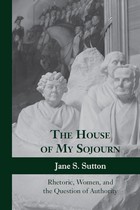 The House of My Sojourn: Rhetoric, Women, and the Question of Authority
Jane S. Sutton
University of Alabama Press, 2010 Employing the trope of architecture, Jane Sutton envisions the relationship between women and rhetoric as a house: a structure erected in ancient Greece by men that, historically, has made room for women but has also denied them the authority and agency to speak from within. Sutton’s central argument is that all attempts to include women in rhetoric exclude them from meaningful authority in due course, and this exclusion has been built into the foundations of rhetoric. Drawing on personal experience, the spatial tropes of ancient Greek architecture, and the study of women who attained significant places in the house of rhetoric, Sutton highlights a number of decisive turns where women were able to increase their rhetorical access but were not able to achieve full authority, among them the work of Frances Wright, Lucy Stone, and suffragists Mott, Anthony, and Stanton; a visit to the 1893 World’s Columbian Exposition in Chicago, where the busts that became the Portrait Monument were displayed in the Woman’s Building (a sideshow, in essence); and a study of working-class women employed as telephone operators in New York in 1919. With all the undeniable successes—socially, politically, and financially— of modern women, it appears that women are now populating the house of rhetoric as never before. But getting in the house and having public authority once inside are not the same thing. Sutton argues that women “can only act as far as the house permits.” Sojourn calls for a fundamental change in the very foundations of rhetoric.
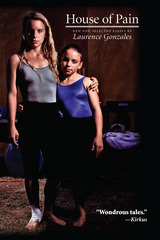 House of Pain: New and Selected Essays
Laurence Gonzales
University of Arkansas Press, 2013 Laurence Gonzales began his successful publishing career in 1989 with the publication of The Still Point and later The Hero’s Apprentice (1994), both with the University of Arkansas Press. From these collections of essays he went on to write for renowned magazines in addition to publishing several books, including the best selling Deep Survival. His journalism garnered two National Magazine Awards, and his latest nonfiction book, Surviving Survival, was named by Kirkus as one of the best books of 2012. This new collection of essays shows us the sometimes hair-raising, sometimes heart-wrenching writing that Gonzales has become known for. This “compelling and trustworthy guide” (Booklist) takes us from a maximum-security prison to a cancer ward, from a mental institution to the World Trade Center. Among the essays included is “Marion Prison,” a National Magazine Award finalist, with its intimate view inside the most maximum security prison in America. “House of Pain” takes the reader into the life of a brain surgeon at Chicago’s Cook County Hospital, a grim world that few ever see. “Rites of Spring,” another National Magazine Award finalist, follows Gonzales and his wife on their journey through cancer, not once, but twice. Other stories venture above the Arctic Circle, flying deep into the Alaskan wilderness among grizzly bears and trumpeter swans; explore aerobatics in high-performance aircraft; and eulogize Memphis and Miami as American cities that mourn their fates in uniquely different ways.
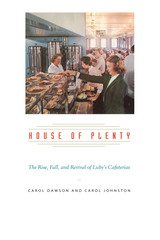 House of Plenty: The Rise, Fall, and Revival of Luby's Cafeterias
By Carol Dawson and Carol Johnston
University of Texas Press, 2006 Violet Crown Award, Writers League of Texas, 2007
Citation, San Antonio Conservation Society, 2009 Scarred by the deaths of his mother and sisters and the failure of his father's business, a young man dreamed of making enough money to retire early and retreat into the secure world that his childhood tragedies had torn from him. But Harry Luby refused to be a robber baron. Turning totally against the tide of avaricious capitalism, he determined to make a fortune by doing good. Starting with that unlikely, even naive, ambition in 1911, Harry Luby founded a cafeteria empire that by the 1980s had revenues second only to McDonald's. So successfully did Luby and his heirs satisfy the tastes of America that Luby's became the country's largest cafeteria chain, creating more millionaires per capita among its employees than any other corporation of its size. Even more surprising, the company stayed true to Harry Luby's vision for eight decades, making money by treating its customers and employees exceptionally well. Written with the sweep and drama of a novel, House of Plenty tells the engrossing story of Luby's founding and phenomenal growth, its long run as America's favorite family restaurant during the post-World War II decades, its financial failure during the greed-driven 1990s when non-family leadership jettisoned the company's proven business model, and its recent struggle back to solvency. Carol Dawson and Carol Johnston draw on insider stories and company records to recapture the forces that propelled the company to its greatest heights, including its unprecedented practices of allowing store managers to keep 40 percent of net profits and issuing stock to all employees, which allowed thousands of Luby's workers to achieve the American dream of honestly earned prosperity. The authors also plumb the depths of the Luby's drama, including a hushed-up theft that split the family for decades; the 1991 mass shooting at the Killeen Luby's, which splattered the company's good name across headlines nationwide; and the rapacious over-expansion that more than doubled the company's size in nine years (1987-1996), pushed it into bankruptcy, and drove president and CEO John Edward Curtis Jr. to violent suicide. Disproving F. Scott Fitzgerald's adage that "there are no second acts in American lives," House of Plenty tells the epic story of an iconic American institution that has risen, fallen, and found redemption—with no curtain call in sight.
HOUSE OF POURED OUT WATERS: POEMS
Jane Mead
University of Illinois Press, 2001 In House of Poured-Out Waters, Jane Mead's substantial new collection, she continues to grapple with a world both personal and cultural. Poised in the slender moment between too early and too late, between the difficult past and the unimaginable future, Mead's poems remind us that the old debates about fate and free will, nature and nurture, are also matters of personal urgency.
More than anything, it is her spiritual dimension that offers Mead a way into the future--but that way must be paved, image by image, with the world before her. Simultaneously conversational and lyrical, these fearless poems extend the possibilities of narrative verse.
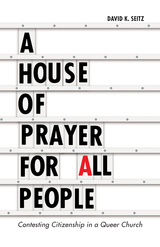 A House of Prayer for All People: Contesting Citizenship in a Queer Church
David K. Seitz
University of Minnesota Press, 2017 Perhaps an unlikely subject for an ethnographic case study, the Metropolitan Community Church of Toronto in Canada is a large predominantly LGBT church with a robust, and at times fraught, history of advocacy. While the church is often riddled with fault lines and contradictions, its queer and faith-based emphasis on shared vulnerability leads it to engage in radical solidarity with asylum-seekers, pointing to the work of affect in radical, coalition politics. A House of Prayer for All People maps the affective dimensions of the politics of citizenship at this church. For nearly three years, David K. Seitz regularly attended services at MCCT. He paid special attention to how community and citizenship are formed in a primarily queer Christian organization, focusing on four contemporary struggles: debates on race and gender in religious leadership, activism around police–minority relations, outreach to LGBT Christians transnationally, and advocacy for asylum seekers. Engaging in debates in cultural geography, queer of color critique, psychoanalysis, and affect theory, A House of Prayer for All People stages innovative, reparative encounters with citizenship and religion. Building on queer theory’s rich history of “subjectless” critique, Seitz calls for an “improper” queer citizenship—one that refuses liberal identity politics or national territory as the ethical horizon for sympathy, solidarity, rights, redistribution, or intimacy. Improper queer citizenship, he suggests, depends not only on “good politics” but also on people’s capacity for empathy, integration, and repair.
The House of Returned Echoes
Arnost Lustig
Northwestern University Press, 2001 Arnošt Lustig's fiction has always been too close to the facts for comfort. In The House of Returned Echoes, he pays tribute to the life of his father, who died in Auschwitz in 1944. In Prague in the difficult time between the wars, a man fights to keep his family and his business alive despite anti-Semitism and economic hardship. Emil Ludvig has always relied on the simple rules of his family and the basic laws of civilization to counteract his misfortunes, and being a decent man himself, he refuses to believe that the Nazi threats will be carried out. Yet, he also becomes a victim of the camps, and his story resonates with both Lustig's personal experiences and the shared memories of the Holocaust.
The HOUSE OF SONG: POEMS
David Wagoner
University of Illinois Press, 2002 As a recipient of Poetry's Levinson Prize and the Ruth Lilly Prize and a nominee for the American Book Award and National Book Award, David Wagoner is one of this country's most celebrated poets.
In The House of Song, he offers a hundred new poems in six parts. At turns elegiac, comic, and nostalgic, these poems venture to the seemingly infinitesimal points where people, legends, and culture collide with nature, memory, and action.
With characteristic wit and brevity, Wagoner chronicles the material invasions of the natural world, reconsidering Thoreau amid ruminations on voyeurs and destroyers, slug watchers and moth collectors.
The House of Song asserts Wagoner's place among the finest of American poets, past and present.
House of Sparrows: New and Selected Poems
Betsy Sholl
University of Wisconsin Press, 2019 The bluesy, rich, and vital poems in House of Sparrows look for grace and beauty not outside of the suffering world but within it. Betsy Sholl explores the shifting ironies and contradictions in the stories we tell—how the apple is both medicinal and poison, and how the poor are spiritually rich. Her language mines the landscapes of Appalachia, New England, and the works of Dante and St. Francis, seeking music and moral clarity in the breakages and noisy contradictions of life. By turns meditative and vivid, these poems suggest that all journeys are in part journeys of the spirit.
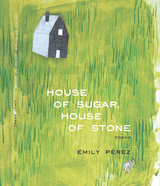 House of Sugar, House of Stone
Emily Pérez
University Press of Colorado, 2016 Emily Pérez’s House of Sugar, House of Stone weaves Grimm’s Fairy Tales into the business of modern life—laptops and late nights with sleepless children—to explore an undercurrent of terror about living in a family. These poems slip between the worlds of the wolf-haunted forest and the harried house of the contemporary artist/parent, until the two blend and bleed into each other. Children learn not to trust their parents, while simultaneously yearning to win back their affections. Parents similarly question their own trustworthiness as protectors. They are devoured by children, which leaves them equally apt to dismember a lion to protect their young as they are to leave those children alone in the woods. These musical, emotionally ruthless pieces occasionally find respite, but Perez reminds us that despite our best efforts to map our way to safety: “Either way / you’re lost. Either way / you’ll wander into deeper woods.”
The House of the Bacabs, Copan, Honduras
David Webster
Harvard University Press, 1989 Claude Baudez, William L. Fash, Jr., Berthold Riese, William T. Sanders, and David Webster contribute to this monograph, and using an integrated art historical and anthropological approach, consider the House of the Bacabs’ context as an elite Maya structure, its excavation and restoration, and its iconographic and epigraphic reconstruction and interpretation, to establish models for understanding Classic Maya social and political life.
The House of the Seven Gables
Nathaniel Hawthorne
Harvard University Press, 2009 Following on the heels of The Scarlet Letter, The House of the Seven Gables was intended to be a far sunnier book than its predecessor and one that would illustrate “the folly” of tumbling down on posterity “an avalanche of ill-gotten gold, or real estate.” Many critics have faulted the novel for its explaining away of hereditary guilt or its contradictory denial of it. Denis Donoghue instructs the reader in a fresh appreciation of the novel.
The John Harvard Library edition reproduces the authoritative text of The House of the Seven Gables in the Centenary Edition of the Works of Nathaniel Hawthorne.
The House of the Singing Winds: The Life and Work of T. C. Steele
Rachel Berenson Perry
Indiana Historical Society Press, 2016 First published in 1966, this account of the life and work of T.C. Steele, one of Indiana's most renowned artists, has become a much-sought-after classic. For this reissue, sixty-two of the book's seventy-six illustrations, including all ten color plates, have been newly photographed and reproduced according to the highest modern standards. The text, unchanged from the first edition, includes a brief biography by the painter's grandson, Theodore L. Steele; a poetic memoir of Steele's last Brown County years by Selma N. Steele; and an appreciation of Steele's work by art historian Wilbur D. Peat.
The House On Breakaheart Road: Poems
Gailmarie Pahmeier
University of Nevada Press, 1998 This breathtaking collection of poems by award-winning Nevada poet Gailmarie Pahmeier explores the many facets of a woman's experience. Told largely through the voice of a fictional character, "Emma," the poems display a range of moods, from tender to wry, ironic, tough, lyrical, reckless. Pahmeier's voice is uniquely her own—strong, profoundly wise, rich in humor and subtlety, utterly feminine. She understands how women live, how they love, and what they need. Ultimately, she teaches us "what comes of it, of love."
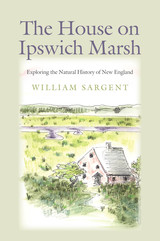 The House on Ipswich Marsh: Exploring the Natural History of New England
William Sargent
University Press of New England, 2015 In 2003, Bill Sargent bought a big pink house in Ipswich, Massachusetts. His home sits on what is known as the Great Marsh, a fascinating patch of wetland shared by Massachusetts and New Hampshire. Sargent received a grant to study some of the rare and endangered ground-nesting birds that inhabit the public land adjacent to his property. Ipswich Marsh is about these birds, but much else as well. Organized by the seasons of the year, The House on Ipswich Marsh features Sargent’s trademark interplay of information about the natural world, ecology, and politics. In “Spring,” the reader learns about the geological history of the Marsh; the migration patterns of bobolinks; the courtship flights of woodcocks; ticks and Lyme disease; the mating of horseshoe crabs and the underwater arrival of zooplankton, fish eggs, and moon jellyfish. “Summer” introduces plate tectonics and glaciers; sea level rise and glacial rebound; diving at night among lobsters and stone crabs; a day on Crane’s Beach; and a bike trip on Argilla Road. “Autumn” illuminates fishing; the natural and cultural history of Hog Island; harvest time on Appelton Farm; and a Native American Thanksgiving. “Winter” describes the formation of dunes and sandbars; the mating behavior of seals; coyote hunting deer at night; and a late-winter blizzard in which Sargent spies a red-tailed hawk, waiting, like the author, for the return of spring.
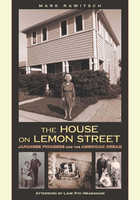 The House on Lemon Street: Japanese Pioneers and the American Dream
Mark Rawitsch
University Press of Colorado, 2013 In 1915, Jukichi and Ken Harada purchased a house on Lemon Street in Riverside, California. Close to their restaurant, church, and children's school, the house should have been a safe and healthy family home. Before the purchase, white neighbors objected because of the Haradas' Japanese ancestry, and the California Alien Land Law denied them real-estate ownership because they were not citizens. To bypass the law Mr. Harada bought the house in the names of his three youngest children, who were American-born citizens. Neighbors protested again, and the first Japanese American court test of the California Alien Land Law of 1913- The People of California v. Jukichi Harada-was the result. Bringing this little-known story to light, The House on Lemon Street details the Haradas' decision to fight for the American dream. Chronicling their experiences from their immigration to the United States through their legal battle over their home, their incarceration during World War II, and their lives after the war, this book tells the story of the family's participation in the struggle for human and civil rights, social justice, property and legal rights, and fair treatment of immigrants in the United States.
The Harada family's quest for acceptance illuminates the deep underpinnings of anti-Asian animus, which set the stage for Executive Order 9066, and recognizes fundamental elements of our nation's anti-immigrant history that continue to shape the American story. It will be worthwhile for anyone interested in the Japanese American experience in the twentieth century, immigration history, public history, and law. This publication was made possible with the support of Naomi, Kathleen, Ken, and Paul Harada, who donated funds in memory of their father, Harold Shigetaka Harada, honoring his quest for justice and civil rights. Additional support for this publication was also provided, in part, by UCLA's Aratani Endowed Chair as well as Wallace T. Kido, Joel B. Klein, Elizabeth A. Uno, and Rosalind K. Uno.
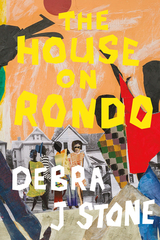 The House on Rondo
Debra J Stone
University of Minnesota Press, 2025 A young girl reckons with the demolition of a Black Saint Paul neighborhood to make way for the Interstate in the early 1960s
When thirteen-year-old Zenobia has to leave her friends and spend the summer at Grandma’s while Mama recovers from a stroke, life seems so unfair. But then the eviction letters start arriving throughout her grandparents’ neighborhood, and white men chalk arrows to mark the gas and water lines, and a new world of unfairness unfolds before her. It’s 1963, and Zenobia’s grandparents’ house on Rondo Avenue in Saint Paul—like all the homes in this thriving Black community—is targeted for demolition to make way for the new Interstate Highway 94. As Zenobia gradually learns about what’s planned for the Rondo neighborhood and what this means for everyone who lives there, she discovers how her story is intertwined with the history of her family, all the way back to Great Grandma Zenobia and the secrets Grandma Essie held close about the reason for her light skin. With the destruction of the neighborhood looming, Zenobia takes a stand on behalf of her community, joining her no-nonsense neighbor, onetime cowgirl Mrs. Ruby Pearl, in a protest and ultimately getting arrested. Though Zenobia is grounded for a month, her punishment seems of little consequence in comparison to what is happening all around her. Even though the demolition continues, she is proud to discover the power and connection in protesting injustice. The House on Rondo captures the heartbreak, resistance, and resilience that marks a community sacrificed in the name of progress—a “progress” that never seems to favor Black families and neighborhoods and that haunts cities like Saint Paul to this day. As Zenobia learns what can be destroyed and what cannot, her story teaches us that joy, community, and love persist, even amid violence and loss.
A House on Stilts: Mothering in the Age of Opioid Addiction
Paula Becker
University of Iowa Press, 2019 A House on Stilts tells the story of one woman’s struggle to reclaim wholeness while mothering a son addicted to opioids. Paula Becker’s son Hunter was raised in a safe, nurturing home by his writer/historian mom and his physician father. He was a bright, curious child. And yet, addiction found him.
More than 2.5 million Americans are addicted to opioids, some half-million of these to heroin. For many of them, their drug addiction leads to lives of demoralization, homelessness, and constant peril. For parents, a child’s addiction upends family life, catapulting them onto a path no longer prescribed by Dr. Spock, but by Dante’s Inferno. Within this ten-year crucible, Paula is transformed by an excruciating, inescapable truth: the difference between what she can do and what she cannot do.
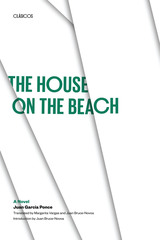 The House on the Beach: A Novel
By Juan García Ponce
University of Texas Press, 1994 Like waves ebbing and flowing, love surges and subsides among four friends who share a vacation at the house on the beach. As they navigate the seas of love and friendship, jealousy and unfaithfulness, Elena, Marta, Eduardo, and Rafael are swept up in the opposing currents that flow between security and personal freedom, marriage and sexual liberation, family and work, provincial and city life, and traditional and unconventional gender roles. This deceptively simple novel, published in Mexico in 1966 as La casa en la playa and here translated into English for the first time, is an important work by one of Mexico's, and indeed Latin America's, major writers of the twentieth century. Juan García Ponce helped Mexican arts and letters break out of the ossified styles and themes of the post-Revolutionary "Mexican School" with works that explore the conflict between individual desire and the demands of family and work. Written at a turning point in his career, The House on the Beach foreshadows his embrace of the erotic encounter as a means of undermining rigid, socially constructed personal identity. It supports feminist views and probes deeply into the contradictions, backwardness, and progress of modern Mexican society.
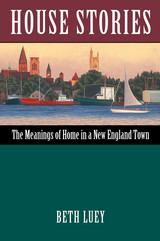 House Stories: The Meanings of Home in a New England Town
Beth Luey
University of Massachusetts Press, 2017 Historic houses adorned with plaques populate New England like nowhere else in the country. These plaques note the construction year and original owner of the house, but they tell nothing about the rich lives of the people who lived there. In House Stories, Beth Luey takes readers on a virtual walking tour of several historic houses in Fairhaven, Massachusetts, a small New England coastal town, inviting us in to learn each house's secrets.
Through letters and diaries, church and business records, newspaper accounts, legal documents, and the recollections of neighbors who knew them, Luey introduces the diverse cast of historical characters who lived in these houses at various times from 1800 to the 2000s, including a Japanese castaway and his rescuer, a self-made millionaire, a seagoing adventurer, a religious pioneer, and an entrepreneurial immigrant. All of the houses are still standing and all but a lighthouse are still called home. In House Stories, Luey asks readers to join her as she considers the multiple meanings of “home” for these people and their families.
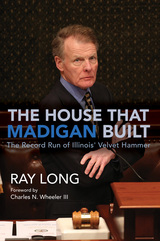 The House That Madigan Built: The Record Run of Illinois' Velvet Hammer
Ray Long. Foreword by Charles N. Wheeler III
University of Illinois Press, 2022 Michael Madigan rose from the Chicago machine to hold unprecedented power as Speaker of the Illinois House of Representatives. In his thirty-six years wielding the gavel, Madigan outlasted governors, passed or blocked legislation at will, and outmaneuvered virtually every attempt to limit his reach. Veteran reporter Ray Long draws on four decades of observing state government to provide the definitive political analysis of Michael Madigan. Secretive, intimidating, shrewd, power-hungry--Madigan mesmerized his admirers and often left his opponents too beaten down to oppose him. Long vividly recreates the battles that defined the Madigan era, from stunning James Thompson with a lightning-strike tax increase, to pressing for a pension overhaul that ultimately failed in the courts, to steering the House toward the Rod Blagojevich impeachment. Long also shines a light on the machinery that kept the Speaker in power. Head of a patronage army, Madigan ruthlessly used his influence and fundraising prowess to reward loyalists and aid his daughter’s electoral fortunes. At the same time, he reshaped bills to guarantee he and his Democratic troops shared in the partisan spoils of his legislative victories. Yet Madigan’s position as the state’s seemingly invulnerable power broker could not survive scandals among his close associates and the widespread belief that his time as Speaker had finally reached its end. Unsparing and authoritative, The House That Madigan Built is the page-turning account of one the most powerful politicians in Illinois history.
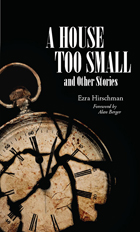 A House Too Small: And Other Stories
Ezra Hirschmann, with foreword by Alan Berger
Texas Tech University Press, 2013 In this unique collection of short stories, the central link is the profound impact of the Holocaust on the lives of first and subsequent generation survivors. Each story has roots in World War II, but all end in the present. Extending into Europe, the Middle East, Africa, and the Americas, the stories demonstrate that the shards of Holocaust evil are scattered far and wide and that the passage of time may, or may not, bring closure. The characters are diverse, from the fragile and frail to the courageous in the face of brutality. Through the unfolding of events long after their traumatic occurrence, some protagonists are relieved of their debilities, while others are rendered desperate by them. For readers interested in post-Holocaust literature, the damaged human condition, and family sagas, this book is a must. Reaching far beyond events that concluded in 1945, A House Too Small carries the aftermath of the Shoah forward, deftly unfolding its powerful personal consequences through remembrance, forgiveness, retribution, tragedy, intrigue, devotion, and redemption.
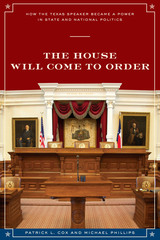 The House Will Come To Order: How the Texas Speaker Became a Power in State and National Politics
By Patrick L. Cox and Michael Phillips
University of Texas Press, 2010 In a state assumed to have a constitutionally weak governor, the Speaker of the Texas House wields enormous power, with the ability to almost single-handedly dictate the legislative agenda. The House Will Come to Order charts the evolution of the Speaker's role from a relatively obscure office to one of the most powerful in the state. This fascinating account, drawn from the Briscoe Center's oral history project on the former Speakers, is the story of transition, modernization, and power struggles. Weaving a compelling story of scandal, service, and opportunity, Patrick Cox and Michael Phillips describe the divisions within the traditional Democratic Party, the ascendance of Republicans, and how Texas business, agriculture, and media shaped perceptions of officeholders. While the governor and lieutenant governor wielded their power, the authors show how the modern Texas House Speaker built an office of equal power as the state became more complex and diverse. The authors also explore how race, class, and gender affected this transition as they explain the importance of the office in Texas and the impact the state's Speakers have had on national politics. At the apex of its power, the Texas House Speaker's role at last receives the critical consideration it deserves.
The Houseboat Veronica: A Novel
Josh Bell
University of Alabama Press, 2024 A witch, a ward, and a houseboat adrift in time—where beauty and terror share the helm. The mysterious houseboat Veronica motors across a postapocalyptic freshwater lake, inhabited by a black-haired witch and her young male ward. They explore an unfolding world of shape-shifting moons, vampire moths, and submerged witch cemeteries—a world where voluntary imprisonment holds its own appeal and the heart yearns for the delicate dance between blood and power, beauty and terror. Neither a pirate nor a mere witch, she is an artist, a master of water and time who shapes reality with her baffling powers. This lyrical and compelling novel beckons readers to explore the enigmatic depths of its prose, inviting them to traverse the waters of wonder and bewilderment. Embrace the bewitching allure of The Houseboat Veronica and lose yourself in its enchanting embrace.
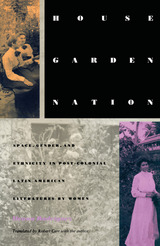 House/Garden/Nation: Space, Gender, and Ethnicity in Post-Colonial Latin American Literatures by Women
Ileana Rodriguez
Duke University Press, 1994 How ironic, the author thought on learning of the Sandinista’s electoral defeat, that at its death the Revolutionary State left Woman, Violeta Chamorro, located at the center. The election signaled the end of one transition and the beginning of another, with Woman somewhere on the border between the neo-liberal and marxist projects. It is such transitions that Ileana Rodríguez takes up here, unraveling their weave of gender, ethnicity, and nation as it is revealed in literature written by women.
In House/Garden/Nation the narratives of five Centro-Caribbean writers illustrate these times of transition: Dulce María Loynáz, from colonial rule to independence in Cuba; Jean Rhys, from colony to commonwealth in Dominica; Simone Schwarz-Bart, from slave to free labor in Guadeloupe; Gioconda Belli, from oligarchic capitalism to social democratic socialism in Nicaragua; and Teresa de la Parra, from independence to modernity in Venezuela. Focusing on the nation as garden, hacienda, or plantation, Rodríguez shows us these writers debating the predicament of women under nation formation from within the confines of marriage and home.
In reading these post-colonial literatures by women facing the crisis of transition, this study highlights urgent questions of destitution, migration, exile, and inexperience, but also networks of value allotted to women: beauty, clothing, love. As a counterpoint on issues of legality, policy, and marriage, Rodriguez includes a chapter on male writers: José Eustacio Rivera, Omar Cabezas, and Romulo Gallegos. Her work presents a sobering picture of women at a crossroads, continually circumscribed by history and culture, writing their way.
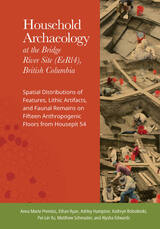 Household Archaeology at the Bridge River Site (EeRl4), British Columbia: Spatial Distributions of Features, Lithic Artifacts, and Faunal Remains on Fifteen Anthropogenic Floors from Housepit 54
Anna Marie Prentiss, Ethan Ryan, Ashley Hampton, Kathryn Bobolinski, Pei-Lin Yu, Matthew Schmader, and Alysha Edwards
University of Utah Press, 2022 Household Archaeology at Bridge River offers a unique contribution to the study of household archaeology, providing unprecedented insights into the history of a long-lived house in the Interior Pacific Northwest. With fifteen intact anthropogenic floors dating to pre-Colonial times, Bridge River’s Housepit 54 provides an extraordinary archaeological record—the first to allow researchers to adequately test for relationships between occupational variation and social change.
The authors take a methodological approach that integrates the study of household spatial organization with consideration of archaeological formation processes. Repeating the same set of analyses for each floor, they examine stability from standpoints of occupation and abandonment cycles, structure and organization of activity areas, and variation in positioning of wealth-related items. This volume is an outstanding example of research undertaken through a collaborative partnership between scholars from the University of Montana and the community of the St’át’imc Nation.
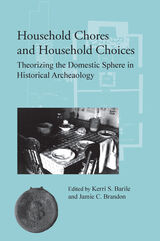 Household Chores and Household Choices: Theorizing the Domestic Sphere in Historical Archaeology
Edited by Kerri S. Barile and James C. Brandon
University of Alabama Press, 2004 Discusses the concepts of “home,” “house,” and “household” in past societies
Because archaeology seeks to understand past societies, the concepts of "home," "house," and "household" are important. Yet they can be the most elusive of ideas. Are they the space occupied by a nuclear family or by an extended one? Is it a built structure or the sum of its contents? Is it a shelter against the elements, a gendered space, or an ephemeral place tied to emotion? We somehow believe that the household is a basic unit of culture but have failed to develop a theory for understanding the diversity of households in the historic (and prehistoric) periods. In an effort to clarify these questions, this volume examines a broad range of households—a Spanish colonial rancho along the Rio Grande, Andrew Jackson's Hermitage in Tennessee, plantations in South Carolina and the Bahamas, a Colorado coal camp, a frontier Arkansas farm, a Freedman's Town eventually swallowed by Dallas, and plantations across the South—to define and theorize domestic space. The essays devolve from many disciplines, but all approach households from an archaeological perspective, looking at landscape analysis, excavations, reanalyzed collections, or archival records. Together, the essays present a body of knowledge that takes the identification, analysis, and interpretation of households far beyond current conceptions.
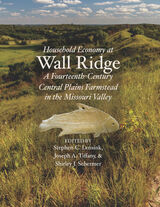 Household Economy at Wall Ridge: A Fourteenth-Century Central Plains Farmstead in the Missouri Valley
Edited by Stephen C. Lensink, Joseph A. Tiffany, and Shirley J. Schermer
University of Utah Press, 2020 Household Economy at Wall Ridge tells the story of a Native American household that occupied a lodge on the eastern Plains border during the early 1300s AD. Contributors use cutting-edge methods and the site’s unparalleled archaeological record to shed light on the daily technological, subsistence, and dietary aspects of the occupants’ lives. This work represents the first comprehensive study of a prehistoric Central Plains household in over half a century. The research covers archaeobotany, zooarchaeology, dating, ceramics, lithics, bone and shell tools, diet, climate, ecology, and more. The study of plant and animal usage from the lodge stands as a tour de force of analytical methods, including stable isotope data that permit the discovery of dietary items missed by traditional studies. Many of these items have never been reported before from Central Plains sites. The book firmly sets the site’s occupancy at AD 1305, with a margin of error of only a few years. This result, based on high-precision dating methods, exceeds in accuracy all previously dated Plains lodges and provides a temporal backdrop for evaluating household activities.
 Householders: The Reizei Family in Japanese History
Steven D. Carter
Harvard University Press, 2007 As direct descendants of the great courtier-poets Fujiwara no Shunzei (1114–1204) and his son Teika (1162–1244), the heirs of the noble Reizei house can claim an unbroken literary lineage that spans over eight hundred years. During all that time, their primary goal has been to sustain the poetic enterprise, or michi (way), of the house and to safeguard its literary assets.
Steven D. Carter weaves together strands of family history, literary criticism, and historical research into a coherent narrative about the evolution of the Reizei Way. What emerges from this innovative approach is an elegant portrait of the Reizei poets as participants in a collective institution devoted more to the continuity of family poetic practices and ideals than to the concept of individual expression that is so central to more modern poetic culture.
In addition to the narrative chapters, the book also features an extensive appendix of one hundred poems from over the centuries, by poets who were affiliated with the Reizei house. Carter’s annotations provide essential critical context for this selection of poems, and his deft translations underscore the rich contributions of the Reizei family and their many disciples to the Japanese poetic tradition.
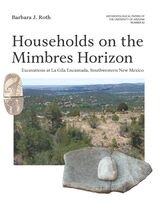 Households on the Mimbres Horizon: Excavations at La Gila Encantada, Southwestern New Mexico
Barbara J. Roth
University of Arizona Press, 2023 Pithouse sites represent the basic form of occupation in the Mimbres Mogollon region of southwestern New Mexico from AD 200 to the late 900s. This study presents the results of excavations of one such site, called La Gila Encantada.
Little is known about the variability present at pithouse sites away from the major Mimbres and Gila River Valleys. Nonriverine occupations have been understudied until now. This book describes subsistence and settlement practices and compares the results with recent research conducted at the larger villages in the Mimbres River Valley. Despite basic similarities in material culture, households at La Gila Encantada appear to have followed different trajectories than those along the rivers. Examining these differences, archaeologist Barbara J. Roth provides insights into some of the reasons why they existed and shows that the variability present in pithouse occupations over the years was tied to multiple factors, including environmental differences, economic practices, and the social composition of groups occupying the sites. With chapters assessing ceramic data, chipped and groundstone analysis, shell and mineral jewelry, and regional context, this look at the past offers relevant insights into current issues in Southwest archaeology, including identity, interaction, and household organization.
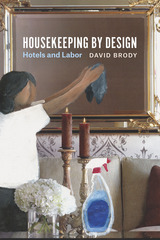 Housekeeping by Design: Hotels and Labor
David Brody
University of Chicago Press, 2016 One of the great pleasures of staying in a hotel is spending time in a spotless, neat, and organized space that you don’t have to clean. That doesn’t, however, mean the work disappears—when we’re not looking, someone else is doing it.
With Housekeeping by Design, David Brody introduces us to those people—the housekeepers whose labor keeps the rooms clean and the guests happy. Through unprecedented access to staff at several hotels, Brody shows us just how much work goes on behind the scenes—and how much management goes out of its way to make sure that labor stays hidden. We see the incredible amount of hard physical work that is involved in cleaning and preparing a room, how spaces, furniture, and other objects are designed to facilitate a smooth flow of hidden labor, and, crucially, how that design could be improved for workers and management alike if front-line staff were involved in the design process. After reading this fascinating exposé of the ways hotels work—or don’t for housekeepers—one thing is certain: checking in will never be the same again.
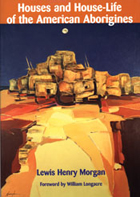 Houses and House-Life of the American Aborigines
Lewis Henry Morgan
University of Utah Press, 2003 A classic, available again. Lewis Henry Morgan (1818–1881) was trained as a lawyer, but in the second part of his life he focused his attention on the emerging science of ethnography. Covering areas of North and Central America, Morgan’s last book, Houses and House-Life of the American Aborigines was the first to regard a set of problems that is still currently debated: what does domestic architecture show anthropologists and archaeologists about social organization, and how does social organization combine with a system of production technology and ecological adjustment to influence domestic and public architecture? As William Longacre makes clear in the new introduction, the development of anthropological archaeology was profoundly affected by this book, and its impact continues to resonate. Demonstrating a lack of ethnocentrism rare for his day, Morgan gathered most of his own data from the field and from a gigantic correspondence. The result is a lively, readable work that is still fascinating and instructive today.
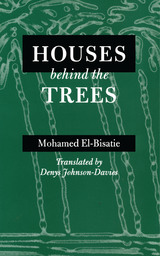 Houses behind the Trees
By Mohamed El-Bisatie
University of Texas Press, 1998 Set in a small village in the Egyptian Delta, El-Bisatie's finely tuned novella illustrates the social and sexual tensions in a community in which nothing is secret and where people's pasts haunt their present. When Mussad catches the butcher's son Amer with his wife, the whole village knows and waits with bated breath for Mussad to exact his revenge. But something goes wrong. Mussad's ill-planned schemes are choked by an opaque veil of history—his wife's sexual past, the war-torn lives of their families, and the personal allegiances of his friends and enemies. The village women relive private desires and inner fears as the men take sides in the struggle, either to protect Amer from Mussad's wrath or to help Mussad track down and confront his nemesis. In the words of Denys Johnson-Davies, "El-Bisatie is a writer's writer, which is to say a writer who makes no concession to the lazy reader. El-Bisatie stands back from his canvas and sketches his characters and events with a studied detachment. While there is drama in his stories it is never highlighted. The menace lurks almost unseen between the lines."
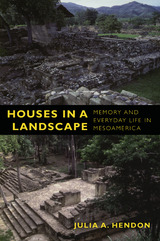 Houses in a Landscape: Memory and Everyday Life in Mesoamerica
Julia A. Hendon
Duke University Press, 2010 In Houses in a Landscape, Julia A. Hendon examines the connections between social identity and social memory using archaeological research on indigenous societies that existed more than one thousand years ago in what is now Honduras. While these societies left behind monumental buildings, the remains of their dead, remnants of their daily life, intricate works of art, and fine examples of craftsmanship such as pottery and stone tools, they left only a small body of written records. Despite this paucity of written information, Hendon contends that an archaeological study of memory in such societies is possible and worthwhile. It is possible because memory is not just a faculty of the individual mind operating in isolation, but a social process embedded in the materiality of human existence. Intimately bound up in the relations people develop with one another and with the world around them through what they do, where and how they do it, and with whom or what, memory leaves material traces. Hendon conducted research on three contemporaneous Native American civilizations that flourished from the seventh century through the eleventh CE: the Maya kingdom of Copan, the hilltop center of Cerro Palenque, and the dispersed settlement of the Cuyumapa valley. She analyzes domestic life in these societies, from cooking to crafting, as well as public and private ritual events including the ballgame. Combining her findings with a rich body of theory from anthropology, history, and geography, she explores how objects—the things people build, make, use, exchange, and discard—help people remember. In so doing, she demonstrates how everyday life becomes part of the social processes of remembering and forgetting, and how “memory communities” assert connections between the past and the present.
The Houses of Belgrade
Borislav Pekic
Northwestern University Press, 1994 The Houses of Belgrade, first published in 1970, draws a parallel between the unrest culminating in the Belgrade student riots of 1968 and that at two earlier points in the history of Yugoslavia: the riots which preceded Germany's 1941 attack on Belgrade and the turmoil of Serbia's entry into WWI. Pekic relates his tale through Negovan, one of Belgrade's prime builders of houses, and through the metaphor of the gradual decline of the builder's mind presents a compelling look at the fear of loss and destruction in a chronically disrupted society.
 Houses of Boston’s Back Bay: An Architectural History, 1840–1917
Bainbridge Bunting
Harvard University Press This superbly illustrated book records the development of Boston's Back Bay during the period of its greatest growth. Bainbridge Bunting focuses his study on one particularly significant architectural form—the town house. He chronicles, both pictorially and verbally, the first appearance, evolution, and eventual discard, during the era, of every local architectural style, all of which later gained national acceptance. He shows how architectural styles were affected by such developments as the electric light, changing preferences in materials, machine production of such interior parts as woodwork and mantels, new fire laws and building restrictions, and rising labor costs. He also provides an extensive account of the pivotal role played by members of the Boston Society of Architects in the growth of the profession throughout the country during this formative period. These Back Bay homes, Bunting points out, reflect to a striking degree the social and cultural attitudes of the community and, in the process of reconstructing the life that was led in them, he offers an absorbing and perceptive commentary on Boston society and its mores.
Houses of God: Region, Religion, and Architecture in the United States
Peter W. Williams
University of Illinois Press, 1997 Houses of God is the first broad survey of American religious architecture, a cultural cross-country expedition that will benefit travelers as much as scholars. Beautifully illustrated with over 100 photographs — some by well-known photographers such as Walker Evans and Dorothea Lange — this handsome book provides a highly accessible look at how Americans shape their places of worship into multifaceted reflections of their culture, beliefs, and times.
HOUSES WITH NAMES: "THE ITALIAN IMMIGRANTS OF HIGHWOOD, ILL
Adria Bernardi
University of Illinois Press, 1990 Combining her other research with interviews of nearly fifty Italian immigrants of her grandparents' generation, Adria Bernardi has crafted a memorable oral history of a community of working-class immigrants. Bernardi tells their story clearly and with care, interspersing transcriptions and translations with her own recollections and interpretations of life among the Italian immigrants of Highwood.
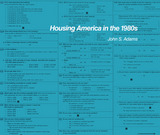 Housing America in the 1980s
John S. Adams
Russell Sage Foundation, 1987 Housing provides shelter, in a variety of forms, but it is also resonant with meaning on many other levels--as a financial asset, a status symbol, an expression of private aspirations and identities, a means of inclusion or exclusion, and finally as a battleground for social change. John Adams' impressive new study explores this complex topic in all its dimensions. Using census data and other housing surveys, Adams describes the recent history of housing in America; the nature of housing supply and demand; patterns of housing use; and selected housing policy questions. Adams supplements this national and regional analysis with a remarkable set of small-area analyses, revealing how neighborhood settings affect housing use and how market forces and other trends interact to shape a neighborhood. These analyses focus on a sample of over fifty urbanized areas, including the nation's three largest cities (New York, Los Angeles, and Chicago). Special two-color maps illustrate the dynamics of housing use in each of these communities. Clearly and insightfully, this volume paints a unique picture of the American "housing landscape," a landscape that reflects and regulates significant aspects of our national life. A Volume in the Russell Sage Foundation Census Series
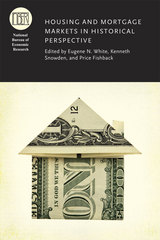 Housing and Mortgage Markets in Historical Perspective
Edited by Eugene N. White, Kenneth Snowden, and Price V. Fishback
University of Chicago Press, 2014 The central role of the housing market in the recent recession raised a series of questions about similar episodes throughout economic history. Were the underlying causes of housing and mortgage crises the same in earlier episodes? Has the onset and spread of crises changed over time? How have previous policy interventions either damaged or improved long-run market performance and stability?
This volume begins to answer these questions, providing a much-needed context for understanding recent events by examining how historical housing and mortgage markets worked—and how they sometimes failed. Renowned economic historians Eugene N. White, Kenneth Snowden, and Price Fishback survey the foundational research on housing crises, comparing that of the 1930s to that of the early 2000s in order to authoritatively identify what contributed to each crisis. Later chapters explore notable historical experiences with mortgage securitization and the role that federal policy played in the surge in home ownership between 1940 and 1960. By providing a broad historical overview of housing and mortgage markets, the volume offers valuable new insights to inform future policy debates.
 Housing and Neighborhood Dynamics: A Simulation Study
John F. Kain and William C. Apgar, Jr.
Harvard University Press, 1985 This book assesses the effects of spatially concentrated programs for housing and neighborhood improvement. These programs provide direct assistance to low–income property owners in an attempt to arrest neighborhood decline and encourage revitalization.
The authors used the Harvard Urban Development Simulation Model (HUDS) in evaluating these programs. HUDS, a large–scale computer model, represents the process of housing rehabilitation, the production and consumption of housing services, household moving decisions, and other determinant of neighborhood change. The model simulates the behavior of approximately 80,000 individual households in two hundred residential neighborhoods of various quality levels. Unlike more aggregate models of urban development, HUDS has the capacity to identify how specific housing policies affect individual households as well as particular neighborhoods.
Since program evaluations are no better than the models on which they are based, the authors provide sufficient detail to permit those readers primarily interested in the policy analysis to assess the methodology and to understandhow the policies are represented in the model; a more technical discussion of the model is then presented in appendixes.
Although the simulations focus on policies that induce central–city property owners to upgrade their properties and thus stimulate revitalization, many of the authors' findings are relevant to larger issues of urban development. For example, the analysis of how housing rehabilitation subsidies affect the investment behavior of nonsubsidized property owners provides insights about the link between initial upgrading and sustained neighborhood improvement. The analysis also demonstrates how differences in location, household, and housing stock characteristics affect a particular neighborhood’s responsiveness to a common policy initiative.
Housing and the Financial Crisis
Edited by Edward L. Glaeser and Todd Sinai
University of Chicago Press, 2013 Conventional wisdom held that housing prices couldn’t fall. But the spectacular boom and bust of the housing market during the first decade of the twenty-first century and millions of foreclosed homeowners have made it clear that housing is no different from any other asset in its ability to climb and crash.
Housing and the Financial Crisis looks at what happened to prices and construction both during and after the housing boom in different parts of the American housing market, accounting for why certain areas experienced less volatility than others. It then examines the causes of the boom and bust, including the availability of credit, the perceived risk reduction due to the securitization of mortgages, and the increase in lending from foreign sources. Finally, it examines a range of policies that might address some of the sources of recent instability.
 Housing Design and Society in Amsterdam: Reconfiguring Urban Order and Identity, 1900-1920
Nancy Stieber
University of Chicago Press, 1998 Winner of the 1999 Spiro Kostof Book Award from the Society of Architectural
Historians.
During the early 1900s, Amsterdam developed an international reputation as an urban mecca when invigorating reforms gave rise to new residential neighborhoods encircling the city's dispirited nineteenth-century districts. This new housing, built primarily with government subsidy, not only was affordable but also met rigorous standards of urban planning and architectural design. Nancy Stieber explores the social and political developments that fostered this innovation in public housing.
Drawing on government records, professional journals, and polemical writings, Stieber examines how government supported large-scale housing projects, how architects like Berlage redefined their role as architects in service to society, and how the housing occupants were affected by public debates about working-class life, the cultural value of housing, and the role of art in society.
Stieber emphasizes the tensions involved in making architectural design a social practice while she demonstrates the success of this collective enterprise in bringing about effective social policy and aesthetic progress.
 Housing in the Twenty-First Century: Achieving Common Ground
Kent W. Colton
Harvard University Press The Housing Act of 1949 called for a “decent home and suitable living environment” for every American. The progress toward this goal over the last fifty years is generally a story of success. Kent Colton documents the remarkable progress in the areas of housing production, homeownership, and rental housing, the transformation of the nation’s housing finance system, the role of government, and the place of housing in the economy. However, significant challenges remain and new issues have arisen.
This work looks to the future using case studies developed during the author’s fifteen-year tenure as head of the National Association of Home Builders and includes discussions of real-world problems and the people involved. Highlighting the process of developing and implementing housing policy given the great challenges of working with many diverse interests, the author outlines a housing policy framework based on a set of principles for achieving common ground.
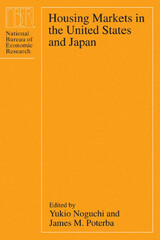 Housing Markets in the United States and Japan
Edited by Yukio Noguchi and James M. Poterba
University of Chicago Press, 1994 Although Japan and the United States are the world's leading economies, there are significant differences in the ways their wealth is translated into living standards. A careful comparison of housing markets illustrates not only how living standards in the two countries differ, but also reveals much about saving patterns and how they affect wealth accumulation.
In this volume, ten essays discuss the evolution of housing prices, housing markets and personal savings, housing finance, commuting, and the impact of public policy on housing markets. The studies reveal surprising differences in housing investment in the two countries. For example, because down payments in Japan are much higher than in the United States, Japanese tend to delay home purchases relative to their American counterparts. In the United States, the advent of home equity credit may have reduced private saving overall.
This book is the first comparison of housing markets in Japan and the United States, and its findings illuminate the effects of housing markets on productivity growth, business investment, and trade.
Housing Needs and Policy Approaches: Trends in Thirteen Countries
Willem Van Vliet , Elizabeth Huttman, and Sylvia Fava, eds.
Duke University Press, 1985 Drawing upon research from six continents, Housing Needs and Policy Approaches analyzes the social problems involved with providing housing in the industrialized nations and in the Third World. The book focuses on four areas of concern: current trends in housing in specific Western countries, the role of Western governments in creating this housing, housing provisions in less developed nations, and the relationship of societal structure and housing, particularly with respect to the decentralization of population occurring in many regions.
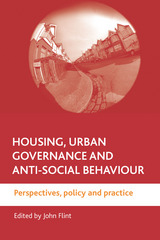 Housing, urban governance and anti-social behaviour: Perspectives, policy and practice
Edited by John Flint
Bristol University Press, 2006 This book is the first comprehensive volume exploring an issue of growing importance to policy makers, academics, housing practitioners and students. It brings together contributions from the most prominent scholars in the field to provide a range of theoretical perspectives, critical analysis and empirical research findings about the role of housing and urban governance in addressing anti-social behaviour.Contributors assess constructions of anti-social behaviour in policy discourse, identify how housing is increasingly central to the governance of anti-social behaviour and critically evaluate a wide range of measures used by housing and other agencies to tackle what is perceived to be a growing social problem. Although the book focuses on the UK, comparative international perspectives are provided from France, Australia and the United States.The book covers definitions of anti-social behaviour and policy responses including key new legislation and the legal role of social landlords in governing anti-social behaviour. There is comprehensive coverage of key measures including eviction, probationary tenancies, Anti-social Behaviour Orders, mediation and Acceptable Behaviour Contracts, and of innovative developments such as gated communities, intensive support services and the use of private security."Housing, urban governance and anti-social behaviour" will be of interest to academics, policy-makers, practitioners and students in the fields of housing, urban studies, social policy, legal studies and criminology.
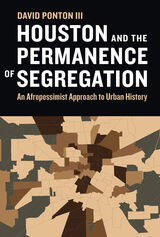 Houston and the Permanence of Segregation: An Afropessimist Approach to Urban History
David Ponton
University of Texas Press, 2024 2025 Most Significant Scholarly Book, Texas Institute of Letters A history of racism and segregation in twentieth-century Houston and beyond. Through the 1950s and beyond, the Supreme Court issued decisions that appeared to provide immediate civil rights protections to racial minorities as it relegated Jim Crow to the past. For black Houstonians who had been hoping and actively fighting for what they called a “raceless democracy,” these postwar decades were often seen as decades of promise. In Houston and the Permanence of Segregation, David Ponton argues that these were instead “decades of capture”: times in which people were captured and constrained by gender and race, by faith in the law, by antiblack violence, and even by the narrative structures of conventional histories. Bringing the insights of Black studies and Afropessimism to the field of urban history, Ponton explores how gender roles constrained thought in black freedom movements, how the “rule of law” compelled black Houstonians to view injustice as a sign of progress, and how antiblack terror undermined Houston’s narrative of itself as a “heavenly” place. Today, Houston is one of the most racially diverse cities in the United States, and at the same time it remains one of the most starkly segregated. Ponton’s study demonstrates how and why segregation has become a permanent feature in our cities and offers powerful tools for imagining the world otherwise.
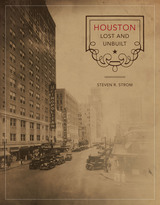 Houston Lost and Unbuilt
By Steven R. Strom
University of Texas Press, 2010 Winner, San Antonio Conservation Society Citation, 2011
Good Brick Award, Greater Houston Preservation Alliance, 2011
Julia Ideson Award, Friends of the Texas Room, 2011 Driven by an almost fanatical desire for whatever is new, "modern," and likely to make money, Houston is constantly in the process of remaking itself. Few structures remain from the nineteenth century, and even much of the twentieth-century built environment has fallen before the wrecking ball of "progress." Indeed, the demolition of older buildings in Houston can be compared to the destruction of cityscapes such as Berlin, Warsaw, and Tokyo in World War II. But because this wholesale restructuring of Houston's built environment has happened in peacetime, historically minded people have only recently sounded an alarm over what is being lost and the toll this destruction is taking on Houstonians' sense of place. Houston Lost and Unbuilt presents an extensive catalogue of twentieth-century public and commercial buildings that have been lost forever, as well as an intriguing selection of buildings that never made it off the drawing board. The lost buildings (or lost interiors of buildings) span a wide range, from civic gathering places such as the Houston Municipal Auditorium and the Astrodome to commercial enterprises such as the Foley Brothers, Sears Roebuck, and Sakowitz department stores to "Theatre Row" downtown to neighborhoods such as Fourth Ward/Freedmen's Town. Steven Strom's introductions and photo captions describe each significant building's contribution to the civic life of Houston. The "unbuilt" section of the book includes numerous previously unpublished architectural renderings of proposed projects such as a multi-building city center, monorail, and people mover system, all which reflect Houston's fascination with the future and optimism that technology will solve all of the city's problems.
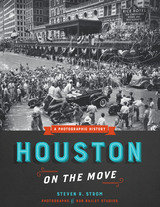 Houston on the Move: A Photographic History
By Steven R. Strom, Photographs by Bob Bailey Studios
University of Texas Press, 2016 Houston completely transformed itself during the twentieth century, burgeoning from a regional hub into a world-class international powerhouse. This remarkable metamorphosis is captured in the Bob Bailey Studios Photographic Archive, an unparalleled visual record of Houston life from the 1930s to the early 1990s. Founded by the commercial photographer Bob Bailey in 1929, the Bailey Studios produced more than 500,000 photographs and fifty-two 16 mm films, making its archive the largest and most comprehensive collection of images ever taken in and around Houston. The Bob Bailey Studios Archive is now owned by the Dolph Briscoe Center for American History at the University of Texas at Austin. Houston on the Move presents over two hundred of the Bailey archive’s most memorable and important photographs with extended captions that detail the photos’ subjects and the reasons for their significance. These images, most never before published, document everything from key events in Houston’s modern history—World War II; the Texas City Disaster; the building of the Astrodome; and the development of the Ship Channel, Medical Center, and Johnson Space Center—to nostalgic scenes of daily life. Bob Bailey’s expertly composed photographs reveal a great city in the making: a downtown striving to be the best, biggest, and tallest; birthday parties, snow days, celebrations, and rodeos; opulent department stores; Hollywood stars and political leaders; rapid industrial and commercial growth; and the inexorable march of the suburbs. An irresistible “remember that?” book for long-time Houstonians, Houston on the Move will also be an essential reference for historians, photographers, designers, and city planners.
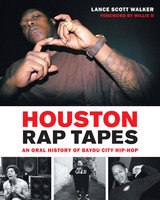 Houston Rap Tapes: An Oral History of Bayou City Hip-Hop
By Lance Scott Walker, Foreword by Willie D
University of Texas Press, 2018 The neighborhoods of Fifth Ward, Fourth Ward, Third Ward, and the Southside of Houston, Texas, gave birth to Houston rap, a vibrant music scene that has produced globally recognized artists such as Geto Boys, DJ Screw, Pimp C and Bun B of UGK, Fat Pat, Big Moe, Z-Ro, Lil’ Troy, and Paul Wall. Lance Scott Walker and photographer Peter Beste spent a decade documenting Houston’s scene, interviewing and photographing the people—rappers, DJs, producers, promoters, record label owners—and places that give rap music from the Bayou City its distinctive character. Their collaboration produced the books Houston Rap and Houston Rap Tapes. This second edition of Houston Rap Tapes amplifies the city’s hip-hop history through new interviews with Scarface, Slim Thug, Lez Moné, B L A C K I E, Lil’ Keke, and Sire Jukebox of the original Ghetto Boys. Walker groups the interviews into sections that track the different eras and movements in Houston rap, with new photographs and album art that reveal the evolution of the scene from the 1970s to today’s hip-hop generation. The interviews range from the specifics of making music to the passions, regrets, memories, and hopes that give it life. While offering a view from some of Houston’s most marginalized areas, these intimate conversations lay out universal struggles and feelings. As Willie D of Geto Boys writes in the foreword, “Houston Rap Tapes flows more like a bunch of fellows who haven’t seen each other for ages, hanging out on the block reminiscing, rather than a calculated literary guide to Houston’s history.”
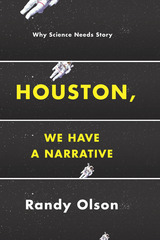 Houston, We Have a Narrative: Why Science Needs Story
Randy Olson
University of Chicago Press, 2015 Ask a scientist about Hollywood, and you’ll probably get eye rolls. But ask someone in Hollywood about science, and they’ll see dollar signs: moviemakers know that science can be the source of great stories, with all the drama and action that blockbusters require.
That’s a huge mistake, says Randy Olson: Hollywood has a lot to teach scientists about how to tell a story—and, ultimately, how to do science better. With Houston, We Have a Narrative, he lays out a stunningly simple method for turning the dull into the dramatic. Drawing on his unique background, which saw him leave his job as a working scientist to launch a career as a filmmaker, Olson first diagnoses the problem: When scientists tell us about their work, they pile one moment and one detail atop another moment and another detail—a stultifying procession of “and, and, and.” What we need instead is an understanding of the basic elements of story, the narrative structures that our brains are all but hardwired to look for—which Olson boils down, brilliantly, to “And, But, Therefore,” or ABT. At a stroke, the ABT approach introduces momentum (“And”), conflict (“But”), and resolution (“Therefore”)—the fundamental building blocks of story. As Olson has shown by leading countless workshops worldwide, when scientists’ eyes are opened to ABT, the effect is staggering: suddenly, they’re not just talking about their work—they’re telling stories about it. And audiences are captivated.
Written with an uncommon verve and enthusiasm, and built on principles that are applicable to fields far beyond science, Houston, We Have a Narrative has the power to transform the way science is understood and appreciated, and ultimately how it’s done.
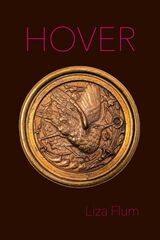 Hover
Liza Flum
Omnidawn, 2025 Poetry and prose that takes on multiple forms to celebrate queer polyamorous families.
Liza Flum’s Hover focuses on queer polyamorous families, considering the ways people in radical family structures are both highly visible and erased. From hummingbirds to stars, historical records, and cemetery monuments, Flum searches for images to represent lives and loves like her own and to find lasting traces of queer and chosen family. In the poetic lexicon of Hover, hummingbirds become emblems of ungraspable survival and vitality, while records on paper and in stone afford enduring, though limited, representations.
The book explores sexuality, love, reproductive choice, and infertility in sonnets and expansive prose meditations. Linked stanzas, which act as little rooms, suggest the intermingling of bedrooms, doctor’s offices, and hospital rooms. The many forms in this collection claim space, both on the page and in poetic discourse, to make the intimate outwardly visible.
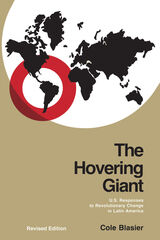 The Hovering Giant (Revised Edition): U.S. Responses to Revolutionary Change in Latin America, 1910–1985
Cole Blasier
University of Pittsburgh Press, 1985
In the first edition of The Hovering Giant, Cole Blasier analyzed U.S. response to revolutions in Latin America from Madero in Mexico to Allende in Chile. He explained why U.S. leaders sponsored paramilitary units to overthrow revolutionary governments in Guatemala and Cuba and compromised their own differences with revolutionary governments in Mexico and Bolivia. The protection of private U.S. interests was part of the explanation, but Blasier gave greater emphasis to rivalry with Germany or the Soviet Union.
Now in this revised edition, Blasier also examines the responses of the Carter and Reagan administrations to the Grenadian and Nicaraguan revolutions and the revolt in El Salvador. He also brings up to date the interpretation of U.S.-Cuban relations.
Blasier stresses U.S. defense of its preeminent position in the Caribean Basin, as well as rivalry with the Soviet Union, to explain these later U.S. responses. Seemingly unaware of historical experience, Washington followed patterns in Central America and Grenada similar to earlier patterns in Guatemala, Cuba, and Chile even though the latter had adverse effects on U.S. security and economic interests.
How
Geoff Wyss
Ohio State University Press, 2012 If every story is born of a question—How did we get here? How do you make your arm do that?—the stories in Geoff Wyss’s How search for answers to the mysteries of an astonishing range of characters. The narrator of “How I Come to Be Here at the GasFast” explains why he hasn’t left a truck stop in the two days since he scratched a winning lottery ticket. In “How to Be a Winner,” a sports consultant browbeats a high school football team with his theory of history and a justification of his failed coaching career. Lost in the mazes they’ve made of themselves, Wyss’s characters search for exits on ground that shifts dizzyingly from humor to pathos, from cynicism to earnestness, from comedy to tragedy, often within the same sentence. Although propelled by a razor-sharp, contemporary voice, Wyss’s stories—many set in a New Orleans unknown to television and tourists—have more in common with Chekhov and O’Connor than with “Treme.”
 How a Century of War Changed the Lives of Women
Lindsey German
Pluto Press, 2013 How a Century of War Changed the Lives of Women looks at the remarkable impact of war on women in Britain. It shows how conflict has changed women’s lives and how those changes have put women at the centre of peace campaigning.
Lindsey German, one of the UK's leading anti-war activists and commentators, shows how women have played a central role in anti-war and peace movements, including the recent wars in Afghanistan and Iraq. The women themselves talk about how they overcame prejudice and difficulty to become active. The book integrates this experience with a historical overview, analysing the two world wars as catalysts of social change for women. It looks at how the changing nature of war, especially the involvement of civilians, increasingly involves significant numbers of women.
As well as providing an inspiring account of women's opposition to war, the book also tackles key contemporary developments, challenging negative assumptions about Muslim women and showing how anti-war movements are feeding into a broader desire to change society.
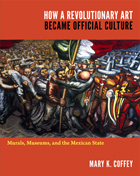 How a Revolutionary Art Became Official Culture: Murals, Museums, and the Mexican State
Mary K. Coffey
Duke University Press, 2012 A public art movement initiated by the postrevolutionary state, Mexican muralism has long been admired for its depictions of popular struggle and social justice. Mary K. Coffey revises traditional accounts of Mexican muralism by describing how a radical art movement was transformed into official culture, ultimately becoming a tool of state propaganda. Analyzing the incorporation of mural art into Mexico's most important public museums—the Palace of Fine Arts, the National History Museum, and the National Anthropology Museum—Coffey illuminates the institutionalization of muralism and the political and aesthetic issues it raised. She focuses on the period between 1934, when José Clemente Orozco and Diego Rivera were commissioned to create murals in the Palace of Fine Arts, through the crisis of state authority in the 1960s. Coffey highlights a reciprocal relationship between Mexico's mural art and its museums. Muralism shaped exhibition practices, which affected the politics, aesthetics, and reception of mural art. Interpreting the iconography of Mexico's murals, she focuses on representations of mestizo identity, the preeminent symbol of postrevolutionary Mexico. Coffey argues that those gendered representations reveal a national culture project more invested in race and gender inequality than in race and class equality.
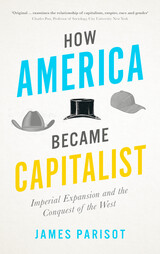 How America Became Capitalist: Imperial Expansion and the Conquest of the West
James Parisot
Pluto Press, 2019 No nation in the history of the world has been more closely identified with capitalism than the United States. Capitalism, politicians and business leaders confidently assert, is and always has been at the heart of the American dream.
Not so fast, says James Parisot. In How America Became Capitalist, he tells the little-known story of how our economic system came to be, and of the alternatives that were sidelined along the way. Capitalist elements were apparent from the first colonies of white settlers, but they were far from dominant, and they weren’t the driving factor in the advancement of colonies deeper into the continent. Even slavery, which was at the heart of both American capitalism and imperialism throughout much of the nation’s growth, was less a monolithic force than a series of complicated encounters that took different forms. Individual difference slowed the homogenization of capitalism as well, as transgender people, gays and lesbians, and people in interracial relationships all brought complexity to the market’s idea of the typical household.
At a moment when the long-term viability of capitalism is coming increasingly into question, How America Became Capitalist reminds us that the path to its dominance was never so smooth, nor so complete, as its champions would have us believe.
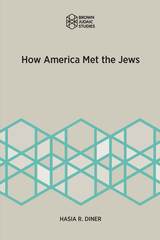 How America Met the Jews
Hasia R. Diner
SBL Press, 2017 Explore how American conditions and Jewish circumstances collided in the nineteenth and early twentieth centuries
In this new book award-winning author Hasia R. Diner explores the issues behind why European Jews overwhelmingly chose to move to the United States between the 1820s and 1920s. Unlike books that tend to romanticize American freedom as the force behind this period of migration or that tend to focus on Jewish contributions to America or that concentrate on how Jewish traditions of literacy and self-help made it possible for them to succeed, Diner instead focuses on aspects of American life and history that made it the preferred destination for 90 percent of European Jews.
Features:
- Examination of the realities of race, immigration, color, money, economic development, politics, and religion in America
- Exploration of an America agenda that sought out white immigrants to help stoke economic development and that valued religion as a force for morality
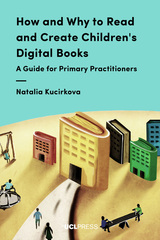 How and Why to Read and Create Children's Digital Books: A Guide for Primary Practitioners
Natalia Kucirkova
University College London, 2018 How and Why to Read and Create Children’s Digital Books outlines effective ways of using digital books in early years and primary classrooms, and specifies the educational potential of using digital books and apps in physical spaces and virtual communities. With a particular focus on apps and personalized reading, Natalia Kucirkova combines theory and practice to argue that personalized reading is only truly personalized when it is created or cocreated by reading communities. Part I suggests criteria to evaluate the educational quality of digital books and practical strategies for their use in the classroom. Specific attention is paid to the ways in which digital books can support individual children’s strengths and difficulties, digital literacies, and language and communication skills . Part II explores digital books created by children, caregivers, teachers, and librarians and offers insights into how smart toys can likewise enrich children’s reading for pleasure.
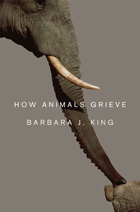 How Animals Grieve
Barbara J. King
University of Chicago Press, 2013 From the time of our earliest childhood encounters with animals, we casually ascribe familiar emotions to them. But scientists have long cautioned against such anthropomorphizing, arguing that it limits our ability to truly comprehend the lives of other creatures. Recently, however, things have begun to shift in the other direction, and anthropologist Barbara J. King is at the forefront of that movement, arguing strenuously that we can—and should—attend to animal emotions. With How Animals Grieve, she draws our attention to the specific case of grief, and relates story after story—from fieldsites, farms, homes, and more—of animals mourning lost companions, mates, or friends. King tells of elephants surrounding their matriarch as she weakens and dies, and, in the following days, attending to her corpse as if holding a vigil. A housecat loses her sister, from whom she's never before been parted, and spends weeks pacing the apartment, wailing plaintively. A baboon loses her daughter to a predator and sinks into grief. In each case, King uses her anthropological training to interpret and try to explain what we see—to help us understand this animal grief properly, as something neither the same as nor wholly different from the human experience of loss. The resulting book is both daring and down-to-earth, strikingly ambitious even as it’s careful to acknowledge the limits of our understanding. Through the moving stories she chronicles and analyzes so beautifully, King brings us closer to the animals with whom we share a planet, and helps us see our own experiences, attachments, and emotions as part of a larger web of life, death, love, and loss.
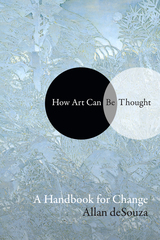 How Art Can Be Thought: A Handbook for Change
Al-An deSouza
Duke University Press, 2018 What terms do we use to describe and evaluate art, and how do we judge if art is good, and if it is for the social good? In How Art Can Be Thought Allan deSouza investigates such questions and the popular terminology through which art is discussed, valued, and taught. Adapting art viewing to contemporary demands within a rapidly changing world, deSouza outlines how art functions as politicized culture within a global industry. In addition to offering new pedagogical strategies for MFA programs and the training of artists, he provides an extensive analytical glossary of some of the most common terms used to discuss art while focusing on their current and changing usage. He also shows how these terms may be crafted to new artistic and social practices, particularly in what it means to decolonize the places of display and learning. DeSouza's work will be invaluable to the casual gallery visitor and the arts professional alike, to all those who regularly look at, think about, and make art—especially art students and faculty, artists, art critics, and curators.
 How Belfast Got the Blues: A Cultural History of Popular Music in the 1960s
Noel McLaughlin and Joanna Braniff
Intellect Books, 2020 Was the first white European blues singer an Irish woman? What links The Rolling Stones to the birth of the Northern Ireland civil rights movement? Did the state suppress the work of a key countercultural director because his film was shot in Belfast in 1965?
This book provides the answers in an engaging and dynamic reconsideration of Belfast’s long-ignored contributions to the popular music and cultural politics of the 1960s. In an expansive socio-cultural history, Noel McLaughlin and Joanna Braniff explore how popular music engaged with and influenced the global cultural and political currents of the decade.
The popular history of Northern Ireland has been overshadowed by the violence of the Troubles. But How Belfast Got the Blues offers a corrective, reconsidering the period before 1969 and arguing that popular music in Northern Ireland was central to the politics of the time, in ways not previously understood or explored. In addition to big names like Van Morrison and Rory Gallagher, the authors highlight lesser-known artists—notably Ottilie Patterson, Ireland's first blues singer—and restore them to music history. By intertwining politics, culture, and key personalities, the authors reexamine this radical decade and the complex but essential relationship between music and identity in a place where it could mean the difference between life and death.
How Celia Changed Her Mind and Selected Stories: Rose Terry Cooke
Ammons, Elizabeth
Rutgers University Press, 1986 This anthology of fiction by Rose Terry Cooke contains eleven stories, drawn together for the first time in one volume, that reflect the whole spectrum of Cooke's career from the 1850s to the 1890s. It restores to American literature the work of a writer highly admired in her own day and increasingly recognized today as an important figure in the development of realism, the evolution of regionalism as a literary form, and the emergence of women writers in nineteenth-century fiction.
Cooke's stories are rich literarily and historically; her command of dialect, ear for dialogue, dramatic sense, and ability to draw interesting, memorable characters all distinguish her work. This reissue of some of her best work represents an important contribution to the canon of American literature.
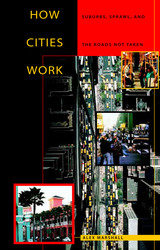 How Cities Work: Suburbs, Sprawl, and the Roads Not Taken
By Alex Marshall
University of Texas Press, 2001 Do cities work anymore? How did they get to be such sprawling conglomerations of lookalike subdivisions, megafreeways, and "big box" superstores surrounded by acres of parking lots? And why, most of all, don't they feel like real communities? These are the questions that Alex Marshall tackles in this hard-hitting, highly readable look at what makes cities work. Marshall argues that urban life has broken down because of our basic ignorance of the real forces that shape cities—transportation systems, industry and business, and political decision making. He explores how these forces have built four very different urban environments—the decentralized sprawl of California's Silicon Valley, the crowded streets of New York City's Jackson Heights neighborhood, the controlled growth of Portland, Oregon, and the stage-set facades of Disney's planned community, Celebration, Florida. To build better cities, Marshall asserts, we must understand and intelligently direct the forces that shape them. Without prescribing any one solution, he defines the key issues facing all concerned citizens who are trying to control urban sprawl and build real communities. His timely book will be important reading for a wide public and professional audience.
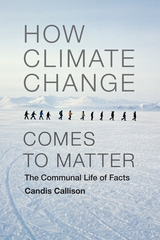 How Climate Change Comes to Matter: The Communal Life of Facts
Candis Callison
Duke University Press, 2014 During the past decade, skepticism about climate change has frustrated those seeking to engage broad publics and motivate them to take action on the issue. In this innovative ethnography, Candis Callison examines the initiatives of social and professional groups as they encourage diverse American publics to care about climate change. She explores the efforts of science journalists, scientists who have become expert voices for and about climate change, American evangelicals, Indigenous leaders, and advocates for corporate social responsibility.
The disparate efforts of these groups illuminate the challenge of maintaining fidelity to scientific facts while transforming them into ethical and moral calls to action. Callison investigates the different vernaculars through which we understand and articulate our worlds, as well as the nuanced and pluralistic understandings of climate change evident in different forms of advocacy. As she demonstrates, climate change offers an opportunity to look deeply at how issues and problems that begin in a scientific context come to matter to wide publics, and to rethink emerging interactions among different kinds of knowledge and experience, evolving media landscapes, and claims to authority and expertise.
 How College Works
Daniel F. Chambliss and Christopher G. Takacs
Harvard University Press, 2013 A Chronicle of Higher Education “Top 10 Books on Teaching” Selection
Winner of the Virginia and Warren Stone Prize
Constrained by shrinking budgets, can colleges do more to improve the quality of education? And can students get more out of college without paying higher tuition? Daniel Chambliss and Christopher Takacs conclude that the limited resources of colleges and students need not diminish the undergraduate experience. How College Works reveals the surprisingly decisive role that personal relationships play in determining a student's collegiate success, and puts forward a set of small, inexpensive interventions that yield substantial improvements in educational outcomes.
“The book shares the narrative of the student experience, what happens to students as they move through their educations, all the way from arrival to graduation. This is an important distinction. [Chambliss and Takacs] do not try to measure what students have learned, but what it is like to live through college, and what those experiences mean both during the time at school, as well as going forward.”
—John Warner, Inside Higher Ed
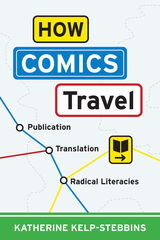 How Comics Travel: Publication, Translation, Radical Literacies
Katherine Kelp-Stebbins
Ohio State University Press, 2022 Winner, 2023 Eisner Award for Best Scholarly/Academic Work
Honorable Mention, 2023 CSS Charles Hatfield Book Prize
In How Comics Travel: Publication, Translation, Radical Literacies, Katherine Kelp-Stebbins challenges the clichéd understanding of comics as a “universal” language, circulating without regard for cultures or borders. Instead, she develops a new methodology of reading for difference. Kelp-Stebbins’s anticolonial, feminist, and antiracist analytical framework engages with comics as sites of struggle over representation in a diverse world. Through comparative case studies of Metro, Tintin, Persepolis, and more, she explores the ways in which graphic narratives locate and dislocate readers in every phase of a transnational comic’s life cycle according to distinct visual, linguistic, and print cultures. How Comics Travel disengages from the constrictive pressures of nationalism and imperialism, both in comics studies and world literature studies more broadly, to offer a new vision of how comics depict and enact the world as a transcultural space.
How Corrupt Is Britain?
Edited by David Whyte
Pluto Press, 2015 Banks accused of rate-fixing. Members of parliament cooking the books. Major defense contractors investigated over suspect arms deals. Police accused of being paid off by tabloids. The headlines are unrelenting these days. Perhaps it’s high time we ask: Just exactly how corrupt is Britain?
David Whyte brings together a wide range of leading commentators and campaigners, offering a series of troubling answers. Unflinchingly facing the corruption in British public life, they show that it is no longer tenable to assume that corruption is something that happens elsewhere; corrupt practices are revealed across a wide range of venerated institutions, from local government to big business. These powerful, punchy essays aim to shine a light on the corruption fundamentally embedded in UK politics, police, and finance.
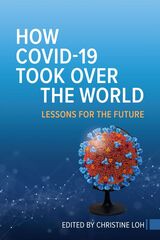 How COVID-19 Took Over the World: Lessons for the Future
Edited by Christine Loh
Hong Kong University Press, 2023 This analysis of the global response to the COVID-19 pandemic will help health professionals and policymakers move forward.
The pandemic left disorder and crises in its wake everywhere it struck. Drawing on disciplines including public health, politics, and socioeconomics, this book tracks the spread of COVID-19 to weave a coherent picture that explains how scientists learned about the virus, how authorities reacted around the world, and how different societies coped.
Written by a leading team of public health, policy, and economics experts, How COVID-19 Took Over the World provides an in-depth analysis of various countries’ responses to the pandemic, as well as suggestions to increase the capability to fight future pandemics. The first part of the book provides an overview of global governance and international cooperation, the economic and social consequences of the outbreak, and breakthroughs in mathematical modeling and COVID-19 vaccines. The second part of the book examines and compares specific countries and regions through the lens of good governance, social contract, and political trust.
How COVID-19 Took Over the World is essential for anyone seeking to learn from the impact of COVID-19, particularly professionals and policymakers, as well as those with a general interest in governance and pandemics.
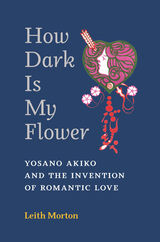 How Dark Is My Flower: Yosano Akiko and the Invention of Romantic Love
Leith Morton
University of Michigan Press, 2023 The poetry of Yosano Akiko covers all the many and varied aspects of the experience of love—from early romantic encounters between the lover and beloved to the intimate pleasures of mutual infatuation and then true love. The journey outlined in Akiko’s verse also grapples with jealousy and unrequited passion, as Akiko’s poem-narrative treats the rivalry between herself and her best friend, the poet Yamakawa Tomiko, for the affection of the dashing young literary lion, Yosano Tekkan, who later became Akiko’s husband. Thus, How Dark Is My Flower: Yosano Akiko and the Invention of Romantic Love tells a number of stories: a real-life romance unfolds in the poetry of these three poets examined in the book, as well as the story of the journey from romanticism to modernism undertaken by early 20th century Japanese poetry.
How Dark Is My Flower emphasizes the astonishing innovations in diction and style, not to mention content, in Akiko’s work that transformed the tanka genre from a hidebound and conservative mode of verse to something much more daring and modern. This book pays particular attention to poetry, particularly the tanka genre, in the evolution of modernism in Japanese literature and breaks new ground in the study of modern Japanese literature by examining the invention and evolution of the concept of romantic love.
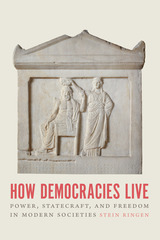 How Democracies Live: Power, Statecraft, and Freedom in Modern Societies
Stein Ringen
University of Chicago Press, 2022 Times have not been kind to democracy. This book is in its defense.
In the new century, the triumph of democracy at the end of the Cold War turned to retrenchment. The core democracies, in America and Britain, succumbed to polarization and misrule. Dictatorships, such as China, made themselves assertive. New democracies in Central Europe turned to muddled ideologies of “illiberal democracy.” In this book, Stein Ringen offers a meditation on what democracy is, the challenges it faces, and how it can be defended. Ringen argues that democracy must be rooted in a culture that supports the ability of citizens to exchange views and information among themselves and with their rulers.
Drawing on the ideas of Machiavelli, Aristotle, Tocqueville, Max Weber, and others, Ringen shows how power is the fuel of government, and statecraft turns power into effective rule. Democracy should prize freedom and minimizing unfairness, especially poverty. Altogether, Ringen offers powerful insight on the meaning of democracy, including a new definition, and how countries can improve upon it and make it function more effectively. Timely and thought-provoking, How Democracies Live is a sober reminder of the majesty of the democratic enterprise.
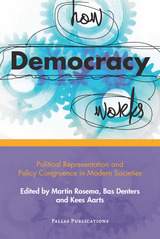 How Democracy Works: Political Representation and Policy Congruence in Modern Societies
Edited by Martin Rosema, Bas Denters, and Kees Aarts
Amsterdam University Press, 2011 In this book, a group of leading scholars analyzes the functioning of modern democracies by focusing on two basic principles: political representation and policy congruence. Drawing on recent survey data from a variety of national and international research projects, they demonstrate how political representation works and mostly leads to a fair degree of policy congruence between citizens and their representatives. They also present new insights on the sources of satisfaction with democracy and the impact of the economy on elections and political trust.
This book is published on the occasion of the retirement of Jacques Thomassen as distinguished professor of political science at the University of Twente. The contributors include Russell Dalton, Hans‐Dieter Klingemann, Pippa Norris, Ola Listhaug, Hanne Marthe Narud, Jan van Deth, Peter Mair, Cees van der Eijk, Hermann Schmitt, Sören Holmberg and Rudy Andeweg.
Martin Rosema, Bas Denters and Kees Aarts are affiliated with the Centre for the Study of Democracy (CSD) and the Institute for Innovation and Governance Studies (IGS) at the University of Twente.
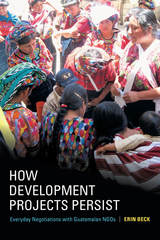 How Development Projects Persist: Everyday Negotiations with Guatemalan NGOs
Erin Beck
Duke University Press, 2017 In How Development Projects Persist Erin Beck examines microfinance NGOs working in Guatemala and problematizes the accepted wisdom of how NGOs function. Drawing on twenty months of ethnographic fieldwork, she shows how development models and plans become entangled in the relationships among local actors in ways that alter what they are, how they are valued, and the conditions of their persistence. Beck focuses on two NGOs that use drastically different methods in working with poor rural women in Guatemala. She highlights how each program's beneficiaries—diverse groups of savvy women—exercise their agency by creatively appropriating, resisting, and reinterpreting the lessons of the NGOs to match their personal needs. Beck uses this dynamic—in which the goals of the developers and women do not often overlap—to theorize development projects as social interactions in which policymakers, workers, and beneficiaries critically shape what happens on the ground. This book displaces the notion that development projects are top-down northern interventions into a passive global south by offering a provocative account of how local conditions, ongoing interactions, and even fundamental tensions inherent in development work allow such projects to persist, but in new and unexpected ways.
How Did Poetry Survive?: The Making of Modern American Verse
John Timberman Newcomb
University of Illinois Press, 2013 This book traces the emergence of modern American poetry at the turn of the nineteenth century. With a particular focus on four "little magazines"--Poetry, The Masses, Others, and The Seven Arts--John Timberman Newcomb shows how each advanced ambitious agendas combining urban subjects, stylistic experimentation, and progressive social ideals. While subsequent literary history has favored the poets whose work made them distinct--individuals singled out usually on the basis of a novel technique--Newcomb provides a denser, richer view of the history that hundreds of poets made.
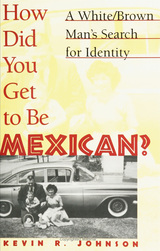 How Did You Get To Be Mexican
Kevin R. Johnson
Temple University Press, 1999 During an interview for a faculty position, a senior professor asked Kevin Johnson bluntly, "How did you get to be a Mexican?" And, a young woman at a Harvard Law School dinner party inquired, "Are you one of those people whose high school friends are all dead from gangs and stuff?" The son of a Mexican American mother and an Anglo father, Professor Johnson has spent his life in the borderlands between racial identities. In this insightful book, he uses his experiences as a mixed Latino Anglo to examine issues of diversity, assimilation, race relations, and affirmative action in the contemporary United States.
Johnson also grew up in the borderlands between classes. He spent his childhood with his mother, first on welfare and then with a racist working-class stepfather. As an adolescent, he moved to his father's home in a predominantly upper-middle-class suburb. His educational experiences too extend from a racially mixed elementary school to an all-white high school, and from Berkeley to Harvard Law School. From this vantage point, he analyzes the intersection of race and class in the United States.
This book looks not just at the question "Who is a Latino?" but also at the question of where persons of mixed Anglo-Latino heritage fit into the racial dynamics of the United States. Professor Johnson's mother was an ardent assimilationist who classified herself as "Spanish"; her failure to become a part o f middle America led her into depression and eventually mental illness. Her son has woven not just her experiences and his own, but also those of friends and relatives, into a complex and moving story of one white/brown man's search for identity.
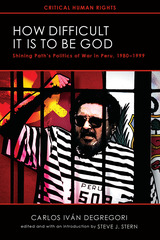 How Difficult It Is to Be God: Shining Path’s Politics of War in Peru, 1980–1999
Carlos Iván Degregori; Edited and with an introduction by Steve J. Stern; Translated by Nancy Appelbaum, Joanna Drzewieniecki, Héctor Flores, Eric Hershberg, Judy Rein, Steve J. Stern, and Kimberly Theidon
University of Wisconsin Press, 2012 The revolutionary war launched by Shining Path, a Maoist insurgency, was the most violent upheaval in modern Peru’s history, claiming some 70,000 lives in the 1980s–1990s and drawing widespread international attention. Yet for many observers, Shining Path’s initial successes were a mystery. What explained its cult-like appeal, and what actually happened inside the Andean communities at war?
In How Difficult It Is to Be God, Carlos Iván Degregori—the world’s leading expert on Shining Path and the intellectual architect for Peru’s highly regarded Truth and Reconciliation Commission—elucidates the movement’s dynamics. An anthropologist who witnessed Shining Path’s recruitment of militants in the 1970s, Degregori grounds his findings in deep research and fieldwork. He explains not only the ideology and culture of revolution among the insurgents, but also their capacity to extend their influence to university youths, Indian communities, and competing social and political movements.
Making Degregori’s most important work available to English-language readers for the first time, this translation includes a new introduction by historian Steve J. Stern, who analyzes the author’s achievement, why it matters, and the debates it sparked. For anyone interested in Peru and Latin America’s age of “dirty war,” or in the comparative study of revolutions, Maoism, and human rights, this book will provide arresting new insights.
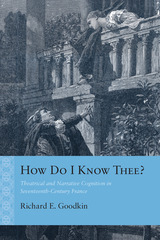 How Do I Know Thee?: Theatrical and Narrative Cognition in Seventeenth-Century France
Richard E. Goodkin
Northwestern University Press, 2015 The classical period in France presents a particularly lively battleground for the transition between oral-visual culture, on the one hand, and print culture on the other. The former depended on learning from sources of knowledge directly, in their presence, in a manner analogous to theatrical experience. The latter became characterized by the distance and abstraction of reading. How Do I Know Thee? explores the ways in which literature, philosophy, and psychology approach social cognition, or how we come to know others. Richard E. Goodkin describes a central opposition between what he calls “theatrical cognition” and “narrative cognition,” drawing both on scholarship on literary genre and mode, and also on the work of a number of philosophers and psychologists, in particular Descartes’s theory of cognition, Freudian psychoanalysis, mid‑twentieth‑century behaviorism, and the field of cognitive science. The result is a study that will be of interest not only to students of the classical period but also to those in the corresponding disciplines.
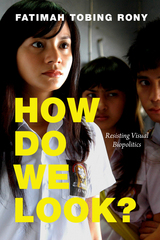 How Do We Look?: Resisting Visual Biopolitics
Fatimah Tobing Rony
Duke University Press, 2022 In How Do We Look? Fatimah Tobing Rony draws on transnational images of Indonesian women as a way to theorize what she calls visual biopolitics—the ways visual representation determines which lives are made to matter more than others. Rony outlines the mechanisms of visual biopolitics by examining Paul Gauguin’s 1893 portrait of Annah la Javanaise—a trafficked thirteen-year-old girl found wandering the streets of Paris—as well as US ethnographic and documentary films. In each instance, the figure of the Indonesian woman is inextricably tied to discourses of primitivism, savagery, colonialism, exoticism, and genocide. Rony also focuses on acts of resistance to visual biopolitics in film, writing, and photography. These works, such as Rachmi Diyah Larasati’s The Dance that Makes You Vanish, Vincent Monnikendam’s Mother Dao (1995), and the collaborative films of Nia Dinata, challenge the naturalized methods of seeing that justify exploitation, dehumanization, and early death of people of color. By theorizing the mechanisms of visual biopolitics, Rony elucidates both its violence and its vulnerability.
 How Does A Policy Mean?: Interpreting Policy and Organizational Actions
Dvora Yanow
Georgetown University Press This book offers a new, interpretive way of understanding organizations and policy by analyzing how they convey meaning through symbolic language, objects, and act. Yanow argues that contested facts in policy often reflect different policy meanings, which are often known tacitly and communicated through the symbols used by an implementing organization. Yanow argues that policy and organizational actions are often as expressive of group or national identity as they are instrumentally oriented. Drawing on the Israel Corporation of Community Centers as an extended illustration of her arguments, she shows how policy meanings may be communicated to multiple audiences through the agency's actions. Using language, physical artifacts, and acts, Yanow explores how one vision of Israeli identity was communicated tacitly, at a time when Jewish Israeli "ethnicity" was publicly undiscussable. In reading public policies and administrative practices as ways in which a polity constructs and narrates its identity, Yanow shows how the case example raises questions of what it means to be a "good" Israeli. Unlike most policy studies which consider organizations within a void, How Does a Policy Mean? puts policy in a societal context. Yanow's interpretation of the policy process extends beyond the field of public policy to examine the way organizations establish identity and image for themselves and for the wider public. Her analysis will be of value to those involved in political science, public administration, and organizational studies.
|
|


